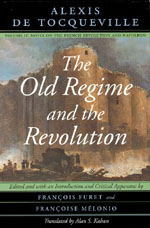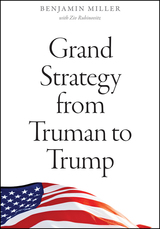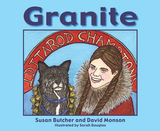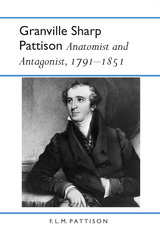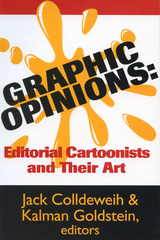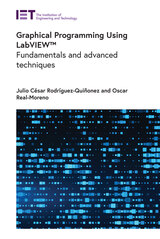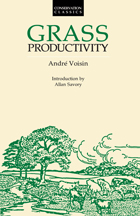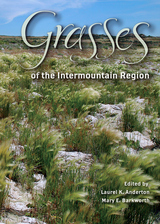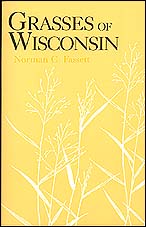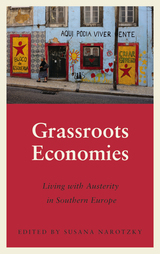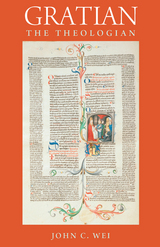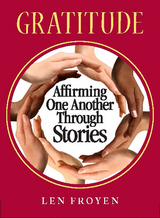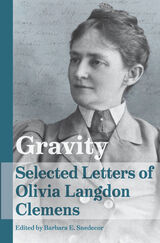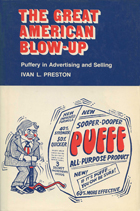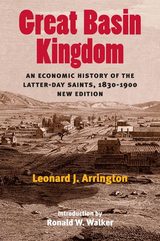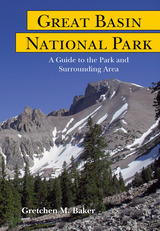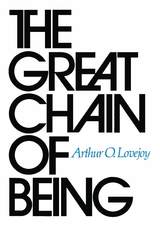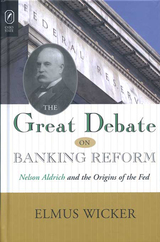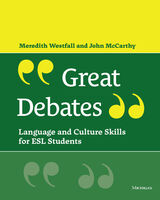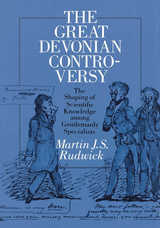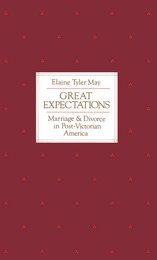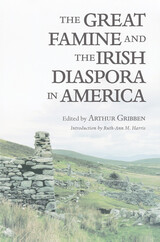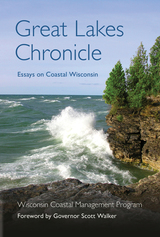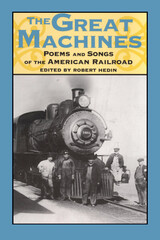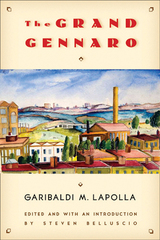 The Grand Gennaro
Belluscio, Steven
Rutgers University Press, 2009 An illiterate Calabrian in southern Italy owes money to his church and mayor. He skips town for the bustling streets of New York. Meeting an old friend, a fellow immigrant, he thanks him for help getting settled, and then steals his money. With a new parcel of wealth, he materializes from a small-time laborer into a big-time entrepreneur, soon becoming the tyrant of the local Italian American community. By pluck, luck, and unscrupulous business practices, this cunning character "makes America." There are riches, pleasure, and the beautiful Carmela. Then trouble. Comeuppance. Ambush. Revenge.Twenty-first century popular culture? Not at all. The Grand Gennaro, a riveting saga set at the turn of the last century in Italian American Harlem, reflects on how youthful acts of cruelty and desperation follow many to the grave. A classic in the truest sense, this operatic narrative is alive once again, addressing the question: How does one become an "American"?
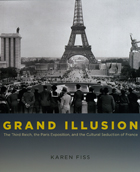 Grand Illusion: The Third Reich, the Paris Exposition, and the Cultural Seduction of France
Karen Fiss
University of Chicago Press, 2009 Franco-German cultural exchange reached its height at the 1937 Paris World’s Fair, where the Third Reich worked to promote an illusion of friendship between the two countries. Through the prism of this decisive event, Grand Illusion examines the overlooked relationships among Nazi elites and French intellectuals. Their interaction, Karen Fiss argues, profoundly influenced cultural production and normalized aspects of fascist ideology in 1930s France, laying the groundwork for the country’s eventual collaboration with its German occupiers. Tracing related developments across fine arts, film, architecture, and mass pageantry, Fiss illuminates the role of National Socialist propaganda in the French decision to ignore Hitler’s war preparations and pursue an untenable policy of appeasement. France’s receptiveness toward Nazi culture, Fiss contends, was rooted in its troubled identity and deep-seated insecurities. With their government in crisis, French intellectuals from both the left and the right demanded a new national culture that could rival those of the totalitarian states. By examining how this cultural exchange shifted toward political collaboration, Grand Illusion casts new light on the power of art to influence history.
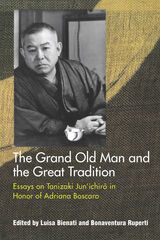 The Grand Old Man and the Great Tradition: Essays on Tanizaki Jun’ichiro in Honor of Adriana Boscaro
Luisa Bienati and Bonaventura Ruperti, Editors
University of Michigan Press, 2009 In 1995, on the thirtieth anniversary of Tanizaki Jun’ichirō’s death, Adriana Boscaro organized an international conference in Venice that had an unusally lasting effect on the study of this major Japanese novelist. Thanks to Boscaro’s energetic commitment, Venice became a center for Tanizaki studies that produced two volumes of conference proceedings now considered foundational for all scholarly works on Tanizaki. In the years before and after the Venice Conference, Boscaro and her students published an abundance of works on Tanizaki and translations of his writings, contributing to his literary success in Italy and internationally. The Grand Old Man and the Great Tradition honors Boscaro’s work by collecting nine essays on Tanizaki’s position in relation to the “great tradition” of Japanese classical literature. To open the collection, Edward Seidensticker contributes a provocative essay on literary styles and the task of translating Genji into a modern language. Gaye Rowley and Ibuki Kazuko also consider Tanizaki’s Genji translations, from a completely different point of view, documenting the author’s three separate translation efforts. Aileen Gatten turns to the influence of Heian narrative methods on Tanizaki’s fiction, arguing that his classicism, far from being superficial, “reflects a deep sensitivity to Heian narrative.” Tzevetana Kristeva holds a different perspective on Tanizaki’s classicism, singling out specific aspects of Tanizaki’s eroticism as the basis of comparison. The next two essays emphasize Tanizaki’s experimental engagement with the classical literary genres—Amy V. Heinrich treats the understudied poetry, and Bonaventura Ruperti considers a 1933 essay on performance arts. Taking up cinema, Roberta Novelli focuses on the novel Manji, exploring how it was recast for the screen by Masumura Yasuzō. The volume concludes with two contributions interpreting Tanizaki’s works in the light of Western and Meiji literary traditions: Paul McCarthy considers Nabokovas a point of comparison, and Jacqueline Pigeot conducts a groundbreaking comparison with a novel by Natsume Sōseki.
 The Grand Option: Personal Transformation and a New Creation
Beatrice Bruteau
University of Notre Dame Press, 2001 Building on the foundations of Teilhard de Chardin, this dynamic work elegantly explores the ongoing challenges of the next leap in human development.
“I know of scarcely anybody,” Bede Griffiths has said, “who goes to the heart of reality as profoundly as Beatrice Bruteau does.” Here Bruteau develops a Trinitarian anthropology with the potential for healing our conflict-ridden planet by transforming us from riven and conflicting individuals, into open, sharing persons of the New Creation. In transcendent freedom, a profound communion consciousness gives birth to global, wholistic community.
Bruteau’s integral vision is as compelling as it is concrete. In this work of philosophical, theological, and psychological anthropology, she presents a cogent spiritual praxis that possesses the power to initiate a psychic revolution. “A new way of seeing,” Teilhard has exclaimed, “combined with a new way of acting—that is what we need.” This is precisely what Beatrice Bruteau offers in The Grand Option.
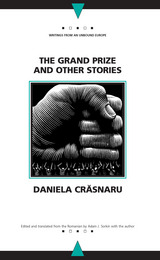 The Grand Prize and Other Stories
Daniela Crasnaru
Northwestern University Press, 2005 Daniela Crasnaru is one of the most prominent poets and short story writers in her native Romania. Once a vocal foe of the Ceauçescu regime, Crasnaru was influenced by the political repression of the communist period; but her short stories depart from those of the many Eastern European writers who use literature purely as a forum for political expression. She also focuses her sympathetic eye on the human foibles of ordinary people whose lives are limited by feelings of helplessness and failure.
Crasnaru portrays the lives of people so used to hardship that it never occurs to them to surrender. An unhappily married woman waits in vain for a call from a potential lover. A foul-mouthed mother of seven accuses a war hero of conning her out of her life savings. A lawyer is lured to a forest by a dead coworker's stories of a beautiful woman. Those with drab lives use fantasy to endure and those who believe themselves happy are forced to face grim realities. Crasnaru mixes elements of the ridiculous, the fanciful, and the grotesque with vivid realism and her remarkable stories, while taking place in a dark era in her nation's history, are about the human as well as the Romanian condition.
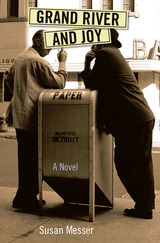 Grand River and Joy
Susan Messer
University of Michigan Press, 2010 Halloween morning 1966, Harry Levine arrives at his wholesale shoe warehouse to find an ethnic slur soaped on the front window. As he scavenges around the sprawling warehouse basement, looking for the supplies he needs to clean the window, he makes more unsettling discoveries: a stash of Black Power literature; marijuana; a new phone line running off his own; and a makeshift living room, arranged by Alvin, the teenaged tenant who lives with his father, Curtis, above the warehouse. Accustomed to sloughing off fears about Detroit's troubled inner-city neighborhood, Harry dismisses the soaped window as a Halloween prank and gradually dismantles “Alvin's lounge” in a silent conversation with the teenaged tenant. Still, these events and discoveries draw him more deeply into the frustrations and fissures permeating his city in the months leading up to the Detroit riots. Grand River and Joy, named after a landmark intersection in Detroit, follows Harry through the intersections of his life and the history of his city. It's a work of fiction set in a world that is anything but fictional, a novel about the intersections between races, classes and religions exploding in the long, hot summers of Detroit in the 1960s. Grand River and Joy is a powerful and moving exploration of one of the most difficult chapters of Michigan history. Susan Messer's fiction and nonfiction have appeared in numerous publications, including Glimmer Train Stories, North American Review, and Colorado Review. She received an Illinois Arts Council Fellowship in prose, an Illinois Arts Council literary award for creative nonfiction, and a prize in the Jewish Cultural Writing Competition of the Dora Teitelboim Center for Yiddish Culture. Cover photograph copyright © Bill Rauhauser and Rauhauser Photographic Trust
Grand Strategy from Truman to Trump
Benjamin Miller with Ziv Rubinovitz
University of Chicago Press, 2020 American foreign policy is the subject of extensive debate. Many look to domestic factors as the driving forces of bad policies. Benjamin Miller instead seeks to account for changes in US international strategy by developing a theory of grand strategy that captures the key security approaches available to US decision-makers in times of war and peace. Grand Strategy from Truman to Trump makes a crucial contribution to our understanding of competing grand strategies that accounts for objectives and means of security policy. Miller puts forward a model that is widely applicable, based on empirical evidence from post-WWII to today, and shows that external factors—rather than internal concerns—are the most determinative.
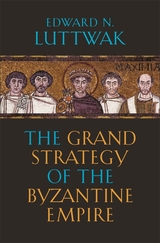 The Grand Strategy of the Byzantine Empire
Edward N. Luttwak
Harvard University Press, 2009 In this book, the distinguished writer Edward N. Luttwak presents the grand strategy of the eastern Roman empire we know as Byzantine, which lasted more than twice as long as the more familiar western Roman empire, eight hundred years by the shortest definition. This extraordinary endurance is all the more remarkable because the Byzantine empire was favored neither by geography nor by military preponderance. Yet it was the western empire that dissolved during the fifth century.
The Byzantine empire so greatly outlasted its western counterpart because its rulers were able to adapt strategically to diminished circumstances, by devising new ways of coping with successive enemies. It relied less on military strength and more on persuasion—to recruit allies, dissuade threatening neighbors, and manipulate potential enemies into attacking one another instead. Even when the Byzantines fought—which they often did with great skill—they were less inclined to destroy their enemies than to contain them, for they were aware that today’s enemies could be tomorrow’s allies. Born in the fifth century when the formidable threat of Attila’s Huns were deflected with a minimum of force, Byzantine strategy continued to be refined over the centuries, incidentally leaving for us several fascinating guidebooks to statecraft and war.
The Grand Strategy of the Byzantine Empire is a broad, interpretive account of Byzantine strategy, intelligence, and diplomacy over the course of eight centuries that will appeal to scholars, classicists, military history buffs, and professional soldiers.
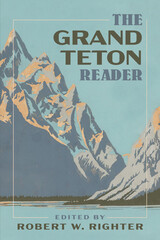 The Grand Teton Reader
Robert W. Righter
University of Utah Press, 2021 Grand Teton National Park draws more than three million visitors annually in search of wildlife, outdoor adventure, solitude, and inspiration. This collection of writings showcases the park’s natural and human histories through stories of drama and beauty, tragedy and triumph.
Editor Robert Righter has selected thirty-five contributors whose work takes readers from the Tetons’ geological origins to the time of Euro-American encroachment and the park’s politically tumultuous creation. Selections range from Laine Thom’s Shoshone legend of the Snake River and Owen Wister’s essay “Great God! I’ve Just Killed a Bear,” to Grace Gallatin Seton-Thompson’s humorous yet fearful account of crossing the Snake River, and William Owen’s first attempt to climb the Grand Teton. Conservationists, naturalists, and environmentalists are also represented: Terry Tempest Williams chronicles her multiyear encounter with her “Range of Memory,” and Olaus and Mardy Murie recount the difficulties of “park-making” in an often-hostile human environment.
Anyone seeking a deeper understanding of the park’s wild beauty and controversial past will want to read these stories by people who lived it.
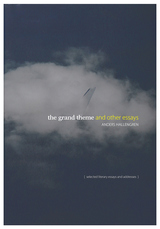 The Grand Theme and Other Essays
ANDERS HALLENGREN
Swedenborg Foundation Publishers, 2013 The Grand Themeand Other Essays is a book of lyrical and critical essays that explores Anders Hallengren’s long-standing interest in the powerful legacy of his fellow countryman, Emanuel Swedenborg. The collection highlights Swedenborg’s diverse influence upon the fields of psychology, art, poetry, history, and music, variously describing Ralph Waldo Emerson and August Strindberg in Paris, court artists in Moscow, visionary composers in Stockholm, Surrealist poets in Mauritius, revolutionary heroes in Cuba, and Linneanists in Botany Bay.
The collection contains the following eight essays:
• “Verisimilitude and the Portrait of an Angel: On the Fortunes of a Swedish-Russian artist” (on painter Carl August Tholander)
• “The Grand Theme: A Journey in the Musical Universe” (on composer Tommie Haglund, music, and classical philosophy)
• “An Angle of Vision”(on Swedenborg’s clairvoyance)
• “The Heart of the Matter” (on Swedenborg’s influence on psychology)
• “In the Garden of God” (on Swedenborg’s and Carl Linnaeus’s influence in Australia)
• “Jardin des Plantes: The Most Important Place on Earth’” (on Swedenborg, Emerson, Strindberg, and Honoré de Balzac in Paris)
• “In the Shadow of Le Morne Brabant” (on Swedenborgianism in Mauritius)
• “The Oceanic Mind” (on Swedenborgianism in Cuba)
Grand Trunk Corporation: Canadian National Railways in the United States, 1971-1992
Don L. Hofsommer
Michigan State University Press, 1995
The Detroit, Michigan-based Grand Trunk Corporation was established more than two decades ago by Canadian National to oversee and maximize the potential of its railroad holdings in the United States. By making use of corporate records, oral histories, and archival material, Hofsommer uncovers the interesting and complex history of Grand Trunk from its inception in 1971 through 1992.
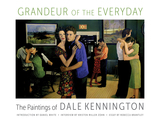 Grandeur of the Everyday: The Paintings of Dale Kennington
Dale Kennington, Introduction by Daniel White, Conversation with Kristen Miller Zohn, Essay by Rebecca Brantley
University of Alabama Press, 2017 A lavishly illustrated overview of the life and work of realist painter Dale Kennington, featuring more than eighty-five of her most renowned works.
Grandeur of the Everyday is the first full-length volume dedicated to the life and work of Dale Kennington—an accomplished master of contemporary American realism. Kennington’s works often hold a strange familiarity, even for those coming to her work for the first time. Her paintings are at once familiar and yet defy specificity of place, clear and lucid while also dense in content. These effects derive from her unique ability to capture the essence of everyday living, the ordinary “in between” moments we often overlook in our day-to-day habits and transactions.
Kennington referred to her paintings as “merged memories.” Combining elements of photography, memory, and imagination, Kennington’s art is an entrancing blend of contemporary and magical realism, with themes ranging from loneliness to community and culture, from class and race relations to the juxtaposition of private and public life. Rather than study the spectacular, she concentrated on commonplace moments of human interaction, inviting observers of her paintings to ponder their significance and to complete their implicit narratives. Often relying on local subjects for her paintings—barbershops, bars, restaurants, gospel concerts, motel rooms, nursing homes—she presented a diversity of local experience.
Grandeur of the Everyday is a treasure trove of her most accomplished creations and includes more than eighty-five examples of both Kennington’s easel paintings on canvas and her freestanding wooden folding screens. The volume also offers an original interview with the artist conducted by Kristen Miller Zohn, an introduction by art historian Daniel White, and a critical essay by the director of the Wiregrass Museum of Art, Rebecca Brantley.
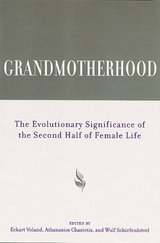 Grandmotherhood: The Evolutionary Significance of the Second Half of Female Life
Voland, Eckart
Rutgers University Press, 2014 By the year 2030, the average life expectancy of women in industrialized countries could reach ninety—exceeding that of men by about ten years. At the present time, postmenopausal women represent more than fifteen percent of the world’s population and this figure is likely to grow.
From an evolutionary perspective, these demographic numbers pose some intriguing questions. Darwinian theory holds that a successful life is measured in terms of reproduction. How is it, then, that a woman’s lifespan can greatly exceed her childbearing and childrearing years? Is this phenomenon simply a byproduct of improved standards of living, or do older women—grandmothers in particular—play a measurable role in increasing their family members’ biological success?
Until now, these questions have not been examined in a thorough and comprehensive manner. Bringing togethertheoretical and empirical work byinternationally recognized scholars in anthropology, psychology, ethnography, and the social sciences, Grandmotherhood explores the evolutionary purpose and possibilities of female post-generative life. Students and scholars of human evolution, anthropology, and even gerontology will look to this volume as a major contribution to the current literature in evolutionary studies.
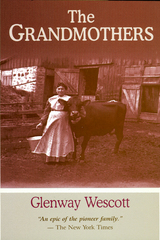 Grandmothers: A Family Portrait
With a New Introduction by Sargent Bush Jr.
University of Wisconsin Press, 1996 Glenway Wescott’s poignant story of nineteenth-century Wisconsin was first published in 1927 as the winner of the prestigious Harper Prize. Like F. Scott Fitzgerald and Ernest Hemingway, Wescott left the Midwest behind to live as a writer in 1920s Paris. In this novel, based on Wescott’s own life and family, the young Alwyn Tower leaves Wisconsin to travel in Europe, but finds himself haunted by a family of long-dead spirits—his grandparents and great-uncles and aunts, a generation whose young adulthood was shattered by the Civil War. Their images were preserved in fading family albums of daguerreotypes and in his own fragmented memories of stories told to him by his strong and enduring grandmothers. To disinter and finally lay to rest the family secrets that lingered insistently in his mind, Wescott writes, Alwyn was “obliged to live in imagination many lives already at an end.”
The Grandmothers is the chronicle of Alwyn’s ancestors: the bitter Henry Tower, who returned from Civil War battlefields to find his beautiful wife Serena lost in a fatal fever; Rose Hamilton, robust and eager, who yearned to leave the cabin of her bearded, squirrel-hunting brothers for the company of courteous Leander Tower; the boy-soldier Hilary Tower, whose worship of his brother made him desperate; fastidious Nancy Tower, whose love for her husband Jesse Davis could not overcome her disgust with the dirt under his fingernails; Ursula Duff, proud and silent, maligned among her neighbors by her venal husband; Alwyn’s parents, Ralph Tower and Marianne Duff, whose happiness is brought about only by the intervention of a determined spinster.
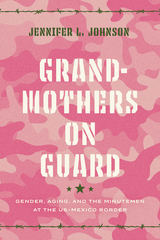 Grandmothers on Guard: Gender, Aging, and the Minutemen at the US-Mexico Border
By Jennifer L. Johnson
University of Texas Press, 2021 For about a decade, one of the most influential forces in US anti-immigrant politics was the Minuteman Project. The armed volunteers made headlines patrolling the southern border. What drove their ethno-nationalist politics? Jennifer L. Johnson spent hundreds of hours observing and interviewing Minutemen, hoping to answer that question. She reached surprising conclusions. While the public face of border politics is hypermasculine—men in uniforms, fatigues, and suits—older women were central to the Minutemen. Women mobilized support and took part in border missions. These women compel us to look beyond ideological commitments and material benefits in seeking to understand the appeal of right-wing politics. Johnson argues that the women of the Minutemen were motivated in part by the gendered experience of aging in America. In a society that makes old women irrelevant, aging white women found their place through anti-immigrant activism, which wedded native politics to their concern for the safety of their families. Grandmothers on Guard emphasizes another side of nationalism: the yearning for inclusion. The nation the Minutemen imagined was not only a space of exclusion but also one in which these women could belong.
Granite
Susan Butcher and David Monson
University of Alaska Press, 2007
Susan Butcher was a four-time champion of the Iditarod Trail sled dog race. Granite was her greatest lead dog, but he didn’t start that way. He was a shy, scraggly pup that the others pushed around, but Susan saw his potential. Together they worked until he became leader of the team.
While they were training for the Iditarod, Granite became deathly ill. The veterinarians said he would never be strong enough to run the race. Granite refused to accept this, and slowly he started to recover. By the time of the race he was strong enough to start, but Susan wondered if he could finish the entire thousand-mile race. Confidently Granite guided the team into the lead of the race, when suddenly they were caught in a raging Arctic blizzard. Now Susan and the whole team depended on Granite to get them through the storm. He had to call on all his inner strength and courage to save them—if he could.
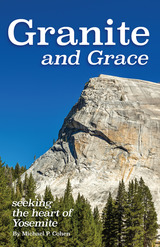 Granite and Grace: Seeking the Heart of Yosemite
Michael P. Cohen
University of Nevada Press, 2019 In Granite and Grace Michael Cohen reflects on a lifetime of climbing, walking, and pondering the granite in Yosemite National Park at Tuolumne Meadows. This high-country region of Yosemite is dominated by a young, beautifully glaciated geological formation known as the Tuolumne Intrusive Suite. It does not include familiar Yosemite icons like Half Dome, yet geologists describe this granitic realm at over 8,000 feet as “an iconic American landscape.”
Drawing together the humanistic and scientific significance of the wild landscapes he traverses, Michael uncovers relationships between people and places and meaning and substance, rendering this text part memoir—but also considerably more. On-the-rock encounters by hand and foot open up a dialogue between the heart of a philosopher and the mind of a geologist. Michael adds a literary softness to this hard landscape, blending excursions with exposition and literature with science. It is through his graceful representations that the geological becomes metaphorical, while the science turns mythological.
This high country, where in 1889 John Muir and Robert Underwood Johnson planned what would become Yosemite National Park, is significant for cultural as well as natural reasons. Discoursing on everything from Camus’s “Myths of Sisyphus” to the poems of Gary Snyder, Michael adds depth to an already splendorous landscape. Premier early geologists, such as François Matthes, shaped the language of Yosemite’s landscape. Even though Yosemite has changed over half a century, the rock has not. As Michael explores the beauty and grace of his familiar towering vistas, he demonstrates why, of the many aspects of the world to which one might get attached, the most secure is granite.
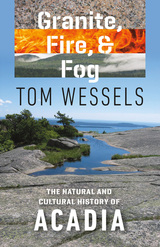 Granite, Fire, and Fog: The Natural and Cultural History of Acadia
Tom Wessels
University Press of New England, 2017 Acadia National Park, on Maine’s Mount Desert Island, is among the most popular national parks in the United States. From the road, visitors can experience magnificent vistas of summit and sea, but on a more intimate scale, equally compelling views abound along Acadia’s hiking trails. Tom Wessels, an ecologist, naturalist, and avid hiker, attributes the park’s popularity—and its unusual beauty—to the unique way in which earth, air, fire, and water—in the form of glacially scoured granite, winter winds, fire, and ocean fog—have converged to create a landscape that can be found nowhere else. In this beautifully illustrated book, Wessels invites readers to investigate the remarkable natural history of Mount Desert Island, along with the unique cultural story it gave rise to. This account of nature, terrain, and human interaction with the landscape will delight those who like to hike these bald summits, ride along the carriage roads, or explore the island’s rugged shoreline. Wessels concludes with a guided tour of one of his favorite hikes, a ten-mile loop that will acquaint the reader with the diverse ecosystems described throughout his book.
 The Granite Pail: The Selected Poems of Lorine Niedecker
Lorine Niedecker
Ohio University Press, 1996 This edition was published in 1996 by Gnomon Press. The Granite Pail is a masterful collection that showcases the poetic brilliance of one of America’s most underappreciated modernist poets. Known for its minimalist style and deep connection to the natural world, Niedecker’s work combines precision with emotional depth in poems that resonate long after they are read. This volume brings together some of Niedecker’s finest poetry, illustrating her gift for capturing profound truths in the simplest of forms. With themes ranging from the intimate and domestic to the universal and ecological, her poems reflect a life deeply rooted in the landscapes of rural Wisconsin. From meditations on the passage of time to lyrical explorations of nature, The Granite Pail reveals the interplay between solitude, creativity, and the human condition. Edited and introduced by Cid Corman, a champion of Niedecker’s work, the collection highlights her unique voice within the Objectivist tradition and her ability to create moments of beauty and insight with remarkable economy. This edition also provides context for her life and influences, shedding light on her artistic evolution and the lasting significance of her poetry. For both longtime admirers and those new to Niedecker’s work, The Granite Pail offers an essential glimpse into the mind of a poet whose quiet brilliance continues to inspire readers and writers alike.
 Grant at Vicksburg: The General and the Siege
Michael B. Ballard
Southern Illinois University Press, 2013 On May 22, 1863, after two failed attempts to take the city of Vicksburg by assault, Major General Ulysses S. Grant declared in a letter to the commander of the Union fleet on the Mississippi River that “the nature of the ground about Vicksburg is such that it can only be taken by a siege.” The 47-day siege of Vicksburg orchestrated by Grant resulted in the eventual surrender of the city and fulfilled a major strategic goal for the Union: command of the Mississippi River for the remainder of the war. In this revealing volume, Michael B. Ballard offers the first in-depth exploration of Grant’s thoughts and actions during this critical operation, providing a never-before-seen portrait of the general in the midst of one of his most notable achievements. After an overview of Grant’s early Civil War career from his first battle through the early stages of the attacks on Vicksburg, Ballard describes in detail how Grant conducted the siege, examining his military decisions, placement of troops, strategy and tactics, engineering objectives, and relationships with other officers. Grant’s worried obsession with a perceived danger of a rear attack by Joseph Johnston’s Confederate army, Ballard shows, affected his decision making, and shows how threats of Confederate action occupied more of Grant’s time than did the siege itself. In addition, Ballard soundly dispels a false story about Grant’s alleged drinking binge early in the siege that has been taken as truthful by many historians, examines how racism in Grant’s army impacted the lives of freed black people and slaves in the Vicksburg area, and explores Grant’s strained relationship with John McClernand, a politically appointed general from Illinois. The book concludes with the surrender of Vicksburg on July 4, 1863, the expulsion of Johnston and his army from the region, and demonstrates the impact of the siege on the outcome on the short and long-terms of Grant’s military career. By analyzing Grant’s personality during the siege and how he dealt with myriad issues as both a general and an administrator, Grant at Vicksburg offers a revealing rendering of the legendary general.
 Grant Castner: The Lost Archive
Nicholas P. Ciotola
Rutgers University Press, 2026 In July 2019, staff of the New Jersey State Museum visited a cramped and dusty storage locker in Hunterdon County. Inside was a treasure trove of more than one thousand glass plate negatives. Each negative preserved an image of New Jersey at the turn of the 20th century. They once belonged to a Trenton resident who had used the plates as tools for his chosen art form. His name was Grant Castner. His art was photography.
Castner’s glass plate negatives are a visual record of New Jersey’s social and cultural history. His many human subjects are rich and poor, young and old, Black and white. They are at work, at play, at home, and in the community. Castner also documented social change brought about by electricity, engineering, education, industry, and transportation. He captured the excitement of public amusements such as parades and fairs. He recorded the aftermath of floods, fires and other disasters. Castner also had a fondness for the outdoors. He used his camera to reflect on the beauty and tranquility that he found in the natural landscapes of New Jersey.
This book presents the collective work of Grant Castner, an amateur artist whose place in New Jersey history was, until now, completely unknown. His photographic negatives forever preserve pinpoint moments in the past. They are time machines to another era. Let this long lost archive transport you on a visual journey into a New Jersey of days gone by.
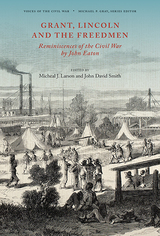 Grant, Lincoln and the Freedmen: Reminiscences of the Civil War by John Eaton
John David Smith
University of Tennessee Press, 2022 In 1863, General Ulysses S. Grant appointed one of his regimental chaplains, John Eaton of Ohio, as general superintendent of contrabands for the Department of the Tennessee. As the American Civil War raged, the former chaplain’s approach to humanitarian aid and education for the newly freed people marked one of the first attempts to consider how an entire population of formerly enslaved people would be assimilated into and become citizens of the postwar Union. General superintendent Eaton chronicled these pioneering efforts in his 1907 memoir, Grant, Lincoln, and the Freedmen: Reminiscences of the Civil War, a work that for more than a century has been an invaluable primary source for historians of the Civil War era.
In this long-awaited scholarly edition, editors John David Smith and Micheal J. Larson provide a detailed introduction and chapter-by-chapter annotations to highlight the lasting significance of Eaton’s narrative. These robust supplements to the 1907 volume contextualize important events, unpack the complexities of inter-agency relationships during the war and postwar periods, and present Eaton’s view that the military should determine how best to assimilate the freed people into the reunited Union.
Grant, Lincoln, and the Freedmen presents a firsthand account of the challenges Grant, Lincoln, and Eaton himself faced in serving and organizing the integration of the newly freed people. This heavily annotated reprint reminds us just how important Eaton’s recollections remain to the historiography of the emancipation process and the Civil War era.
 Grant Park: The Evolution of Chicago's Front Yard
Dennis H. Cremin
Southern Illinois University Press, 2013 On November 4, 2008, when president-elect Barack Obama celebrated his victory with more than one hundred thousand supporters in Chicago, everyone knew where to meet. Long considered the showplace and cultural center of Chicago, Grant Park has been the site of tragedy and tension, as well as success and joy. In addition to serving as the staging grounds for Abraham Lincoln’s funeral procession through the city, the park has been the setting for civil rights protests and the 1968 Democratic National Convention demonstrations. The faithful attended the open-air mass of Pope John Paul II in Grant Park, and fans gathered there to cheer for the Chicago Bulls after their championship wins. The long park overlooking the beautiful waters of Lake Michigan has played an active part in Chicago and U. S. history. In 1836, only three years after Chicago was founded, Chicagoans set aside the first narrow shoreline as public ground and declared it “forever open, clear, and free. . . .” Chicago historian and author Dennis H. Cremin reveals that despite such intent, the transformation of Grant Park to the spectacular park it is more than 175 years later was a gradual process, at first fraught with a lack of funding and organization, and later challenged by erosion, the railroads, automobiles, and a continued battle between original intent and conceptions of progress. Throughout the book, Cremin shows that while Grant Park’s landscape and uses have changed throughout its rocky history, the public ground continues to serve “as a display case for the city and a calling card to visitors.” Amply illustrated with maps and images from throughout Chicago’s history, Grant Park shows readers how Chicago’s “front yard” developed into one of the finest urban parks in the country today.
2014 Illinois State Historical Society Book of the Year
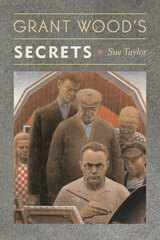 Grant Wood’s Secrets
Sue Taylor
University of Delaware Press, 2011 Incorporating copious archival research and original close readings of American artist Grant Wood’s iconic as well as lesser-known works, Grant Wood’s Secrets reveals how his sometimes anguished psychology was shaped by his close relationship with his mother and how he channeled his lifelong oedipal guilt into his art. Presenting Wood’s abortive autobiography “Return from Bohemia” for the first time ever, Sue Taylor integrates the artist’s own recollections into interpretations of his art. As Wood dressed in overalls and boasted about his beloved Midwest, he consciously engaged in regionalist strategies, performing a farmer masquerade of sorts. In doing so, he also posed as conventionally masculine, hiding his homosexuality from his rural community. Thus, he came to experience himself as a double man. This book conveys the very real threats under which Wood lived and pays tribute to his resourceful responses, which were often duplicitous and have baffled art historians who typically take them at face value.
Published by University of Delaware Press. Distributed worldwide by Rutgers University Press.
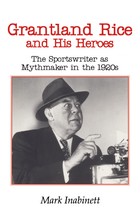 Grantland Rice and His Heroes: The Sportswriter as Mythmaker in the 1920s
Mark Inabinett
University of Tennessee Press, 1994 The decade of the 1920s has long been heralded as the "Golden Age" of American sports. What made it golden, however, was not simply a wealth of talented athletes. Just as important-if not more so-were the sportswriters who deified those athletes.
No figure of that era better epitomized the sportswriter as mythmaker than Grantland Rice. An avowed romantic remembered for his assertion that winning or losing is less important than "how you played the Game," Rice always preferred praising athletes' triumphs to condemning their failures, on the field or otherwise. The dynamism and vividness of his writing not only captivated the myriad readers of his syndicated column but left a permanent mark on sports journalism.
In Grantland Rice and His Heroes, Mark Inabinett explores Rice's critical role in creating the legends that surrounded six sports stars: Jack Dempsey, Babe Ruth, Bobby Jones, Bill Tilden, Red Grange, and Knute Rockne. Quoting liberally from Rice's writings, Inabinett evokes the sportswriter's ability to humanize his subjects, his passionate love of the games he covered, and the ambience of an era that shared his idealism about athletic competition.
As Inabinett notes, the sportswriters of the 1920s enjoyed a near monopoly on sports news since few fans had a way to verify their accounts. And Rice, the most famous and widely read of those sportswriters, used that power to move and inspire his readers. Today, when television makes sporting events accessible to millions, the imagery and storytelling that marked Rice's columns might seem superfluous. Yet, Inabinett says, the elements that Rice used to create his stories-heroes and goats, winners and losers, desire and skill-still exist in sports. "The stories need to be told," Inabinett suggests, "and for a deeper reason than the games themselves."
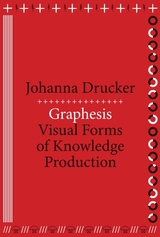 Graphesis: Visual Forms of Knowledge Production
Johanna Drucker
Harvard University Press, 2014 In our current screen-saturated culture, we take in more information through visual means than at any point in history. The computers and smart phones that constantly flood us with images do more than simply convey information. They structure our relationship to information through graphical formats. Learning to interpret how visual forms not only present but produce knowledge, says Johanna Drucker, has become an essential contemporary skill.
Graphesis provides a descriptive critical language for the analysis of graphical knowledge. In an interdisciplinary study fusing digital humanities with media studies and graphic design history, Drucker outlines the principles by which visual formats organize meaningful content. Among the most significant of these formats is the graphical user interface (GUI)—the dominant feature of the screens of nearly all consumer electronic devices. Because so much of our personal and professional lives is mediated through visual interfaces, it is important to start thinking critically about how they shape knowledge, our behavior, and even our identity.
Information graphics bear tell-tale signs of the disciplines in which they originated: statistics, business, and the empirical sciences. Drucker makes the case for studying visuality from a humanistic perspective, exploring how graphic languages can serve fields where qualitative judgments take priority over quantitative statements of fact. Graphesis offers a new epistemology of the ways we process information, embracing the full potential of visual forms and formats of knowledge production.
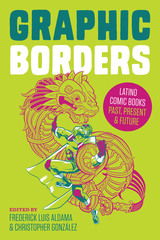 Graphic Borders: Latino Comic Books Past, Present, and Future
Edited by Frederick Luis Aldama and Christopher González
University of Texas Press, 2016 From the influential work of Los Bros Hernandez in Love & Rockets, to comic strips and political cartoons, to traditional superheroes made nontraditional by means of racial and sexual identity (e.g., Miles Morales/Spider-Man), comics have become a vibrant medium to express Latino identity and culture. Indeed, Latino fiction and nonfiction narratives are rapidly proliferating in graphic media as diverse and varied in form and content as is the whole of Latino culture today. Graphic Borders presents the most thorough exploration of comics by and about Latinos currently available. Thirteen essays and one interview by eminent and rising scholars of comics bring to life this exciting graphic genre that conveys the distinctive and wide-ranging experiences of Latinos in the United States. The contributors’ exhilarating excavations delve into the following areas: comics created by Latinos that push the boundaries of generic conventions; Latino comic book author-artists who complicate issues of race and gender through their careful reconfigurations of the body; comic strips; Latino superheroes in mainstream comics; and the complex ways that Latino superheroes are created and consumed within larger popular cultural trends. Taken as a whole, the book unveils the resplendent riches of comics by and about Latinos and proves that there are no limits to the ways in which Latinos can be represented and imagined in the world of comics.
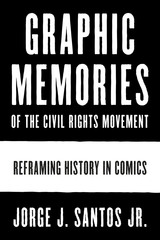 Graphic Memories of the Civil Rights Movement: Reframing History in Comics
By Jorge J. Santos, Jr.
University of Texas Press, 2019 Winner, Charles Hatfield Book Prize, Comic Studies Society, 2020
A CHOICE Outstanding Academic Title, 2019 The history of America’s civil rights movement is marked by narratives that we hear retold again and again. This has relegated many key figures and turning points to the margins, but graphic novels and graphic memoirs present an opportunity to push against the consensus and create a more complete history. Graphic Memories of the Civil Rights Movement showcases five vivid examples of this: Ho Che Anderson's King (2005), which complicates the standard biography of Martin Luther King Jr.; Congressman John Lewis's three-volume memoir, March (2013–2016); Darkroom (2012), by Lila Quintero Weaver, in which the author recalls her Argentinian father’s participation in the movement and her childhood as an immigrant in the South; the bestseller The Silence of Our Friends, by Mark Long, Jim Demonakos, and Nate Powell (2012), set in Houston's Third Ward in 1967; and Howard Cruse's Stuck Rubber Baby (1995), whose protagonist is a closeted gay man involved in the movement. In choosing these five works, Jorge Santos also explores how this medium allows readers to participate in collective memory making, and what the books reveal about the process by which history is (re)told, (re)produced, and (re)narrativized. Concluding the work is Santos’s interview with Ho Che Anderson.
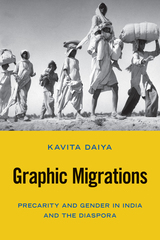 Graphic Migrations: Precarity and Gender in India and the Diaspora
Kavita Daiya
Temple University Press, 2020 In Graphic Migrations, Kavita Daiya provides a literary and cultural archive of refugee stories and experiences to respond to the question “What is created?” after decolonization and the 1947 Partition of India. She explores how stories of Partition migrations shape and influence the political and cultural imagination of secularism and contribute to gendered citizenship for South Asians in India and its diasporas. Daiya analyzes modern literature, Bollywood films, Margaret Bourke-White’s photography, advertising, and print culture to show how they memorialize or erase refugee experiences. She also uses oral testimonies of Partition refugees from Hong Kong, South Asia, and North America to draw out the tensions of the nation-state, ethnic discrimination, and religious difference. Employing both Critical Refugee Studies and Feminist Postcolonial Studies frameworks, Daiya traces the cultural, affective, and political legacies of Partition migrations. The precarity generated by modern migration and expressed through public culture prompts a rethinking of how dominant media represents gendered migrants and refugees. Graphic Migrations demands that we redraw the boundaries of how we tell the story of modern world history and the intricately interwoven, intimate production of statelessness and citizenship across the world’s communities.
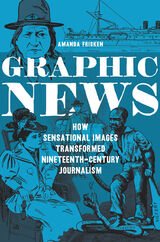 Graphic News: How Sensational Images Transformed Nineteenth-Century Journalism
Amanda Frisken
University of Illinois Press, 2020 ”You furnish the pictures and I’ll furnish the war.” This famous but apocryphal quote, long attributed to newspaper magnate William Randolph Hearst, encapsulates fears of the lengths to which news companies would go to exploit visual journalism in the late nineteenth century. From 1870 to 1900, newspapers disrupted conventional reporting methods with sensationalized line drawings. A fierce hunger for profits motivated the shift to emotion-driven, visual content. But the new approach, while popular, often targeted, and further marginalized, vulnerable groups. Amanda Frisken examines the ways sensational images of pivotal cultural events—obscenity litigation, anti-Chinese bloodshed, the Ghost Dance, lynching, and domestic violence—changed the public's consumption of the news. Using intersectional analysis, Frisken explores how these newfound visualizations of events during episodes of social and political controversy enabled newspapers and social activists alike to communicate—or challenge—prevailing understandings of racial, class, and gender identities and cultural power.
Graphic Opinions: Editorial Cartoonists and Their Art
Jack Colldeweih
University of Wisconsin Press, 1998 Editorial cartoonists are buffeted by unprecedented challenges from global computer information networks. Newspapers fail, colleagues are dismissed or harried, and they tussle over “selling” gags rather than satire. Graphic Opinions offers a path-breaking group portrait of these artists’ attempts to reconcile economics with a sense of
calling.
The editors examine the current work and opinions of two dozen prominent cartoonists through profiles and essays about political and social issues. Four examples by each cartoonist illustrate this.
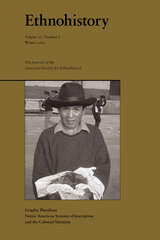 Graphic Pluralism, Volume 57
Frank L. Salomon
Duke University Press This special issue of Ethnohistory examines how Amerindian graphic codes interacted with alphabetic writing in the colonial polities of the Americas. Expanding on the common understanding of writing, the issue introduces the term graphic pluralism to describe situations in which multiple systems of inscription were used in the same linguistic community. The contributors’ studies of graphic pluralism shed light on colonial interactions in North America, Mesoamerica, and South America, and on how both alphabets and indigenous systems helped form the basis of colonial control and resistance. One contributor shows how the Spanish colonial powers and the traditional Maya nobility in the Yucatán struggled over alphabetic literacy and the continued use of hieroglyphics. Another contributor documents how the Natick speakers of Martha’s Vineyard adopted alphabetic literacy for their own purposes in the seventeenth and eighteenth centuries, incorporating writing as a tool of traditional governance. In another article, a Spanish translation is compared to the original Nahua text to show how the two versions provide very different views of the Spanish conquest of the city-state of Mexico-Tenochtitlán. Yet another contributor examines how competing language ideologies in the Andes were used to characterize khipus (Andean knotted strings) and alphabetic script.
Graphic Subjects: Critical Essays on Autobiography and Graphic Novels
Michael A. Chaney
University of Wisconsin Press, 2011 Some of the most noteworthy graphic novels and comic books of recent years have been entirely autobiographical. In Graphic Subjects, Michael A. Chaney brings together a lively mix of scholars to examine the use of autobiography within graphic novels, including such critically acclaimed examples as Art Spiegelman’s Maus, David Beauchard’s Epileptic, Marjane Satrapi’s Persepolis, Alan Moore’s Watchmen, and Gene Yang’s American Born Chinese. These essays, accompanied by visual examples, illuminate the new horizons that illustrated autobiographical narrative creates. The volume insightfully highlights the ways that graphic novelists and literary cartoonists have incorporated history, experience, and life stories into their work. The result is a challenging and innovative collection that reveals the combined power of autobiography and the graphic novel.
 Graphic War: Jewish Women Drawing Contested Spaces
Laini Kavaloski
Rutgers University Press, 2026 Employing geographical and political structures to her analyses, Laini Kavaloski argues that spatial forms that represent boundaries such as walls, ghettos, and war zones together with the artistic renderings of emotion, gendered experiences, and cultural narratives make visible the consequences of war on bodies and political futures. Representations of Jewish territorial positions are not only metaphoric but are also active forces in determining the effects of boundaries—political and cultural— on Jewish lives. Through an archive of contemporary memoirs that grapple with Jewish experiences of war, Graphic War makes visible the consequences of state structures, militarized environments, and nationalisms on the female body and in doing so registers a shift from the persistent Jewish identification with 20th-century oppression toward a narrative of Jewish belonging based in transnational agency and activism in the 21st Century.
Graphical Programming Using LabVIEW™: Fundamentals and advanced techniques
Julio César Rodríguez-Quiñonez
The Institution of Engineering and Technology, 2022 In this book, the authors focus on efficient ways to program instrumentation and automation systems using LabVIEW™, a system design platform and development environment commonly used for data acquisition, instrument control, and industrial automation on a variety of operating systems.
 The Graphomaniac: A Literary-Historical Discussion of Dmitry Khvostov
Ilya Vinitsky and James H. McGavran III
Northwestern University Press, 2025 On the unexpected pleasures and provocations of bad poetry
The only Russian Count of Sardinia, Dmitry Ivanovich Khvostov (1757–1835) didn’t achieve fame in his lifetime—he achieved infamy. Pathologically prolific and delusionally dedicated to a craft for which he had no talent, the count was renowned for his compulsive output, driven by a passion for poetry that was as strong as his abilities were weak. Only the country that gave the world Pushkin, however, could produce Khvostov, in whom we find a distorted yet illuminating reflection of his poetic epoch, with all its numerous cultural manifestations and hidden impulses, its desires and prejudices.
As he leads us on a playful journey across Russia’s Golden Age and beyond, from neoclassical salon to faculty lounge, Ilya Vinitsky reflects on the challenges and necessities of literary critique and on the unexpected rewards of bad art as a subject of study, not just ridicule. Mischievous but erudite, sensitive but never self-serious, The Graphomaniac is an intellectual biography of the anti-hero, a cultural figure whose paradoxes yield new insights into his era.
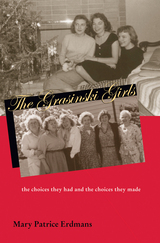 The Grasinski Girls: The Choices They Had and the Choices They Made
Mary Patrice Erdmans
Ohio University Press, 2004 The Grasinski Girls were working-class Americans of Polish descent, born in the 1920s and 1930s, who created lives typical of women in their day. They went to high school, married, and had children. For the most part, they stayed home to raise their children. And they were happy doing that. They took care of their appearance and their husbands, who took care of them. Like most women of their generation, they did not join the women’s movement, and today they either reject or shy away from feminism. Basing her account on interviews with her mother and aunts, Mary Erdmans explores the private lives of these white, Christian women in the post-World War II generation. She compares them, at times, to her own postfeminist generation. Situating these women within the religious routines that shaped their lives, Professor Erdmans explores how gender, class, ethnicity, and religion shaped the choices the Grasinski sisters were given as well as the choices they made. These women are both acted upon and actors; they are privileged and disadvantaged; they resist and surrender; they petition the Lord and accept His will. The Grasinski Girls examines the complexity of ordinary lives, exposing privileges taken for granted as well as nuances of oppression often overlooked. Erdmans brings rigorous scholarship and familial insight to bear on the realities of twentieth-century working-class white women in America.
 The Grasping Hand: "Kelo v. City of New London" and the Limits of Eminent Domain
Ilya Somin
University of Chicago Press, 2015 In 2005, the Supreme Court ruled that the city of New London, Connecticut, could condemn fifteen residential properties in order to transfer them to a new private owner. Although the Fifth Amendment only permits the taking of private property for “public use,” the Court ruled that the transfer of condemned land to private parties for “economic development” is permitted by the Constitution—even if the government cannot prove that the expected development will ever actually happen. The Court’s decision in Kelo v. City of New London empowered the grasping hand of the state at the expense of the invisible hand of the market.
In this detailed study of one of the most controversial Supreme Court cases in modern times, Ilya Somin argues that Kelo was a grave error. Economic development and “blight” condemnations are unconstitutional under both originalist and most “living constitution” theories of legal interpretation. They also victimize the poor and the politically weak for the benefit of powerful interest groups and often destroy more economic value than they create. Kelo itself exemplifies these patterns. The residents targeted for condemnation lacked the influence needed to combat the formidable government and corporate interests arrayed against them. Moreover, the city’s poorly conceived development plan ultimately failed: the condemned land lies empty to this day, occupied only by feral cats. The Supreme Court’s unpopular ruling triggered an unprecedented political reaction, with forty-five states passing new laws intended to limit the use of eminent domain. But many of the new laws impose few or no genuine constraints on takings. The Kelo backlash led to significant progress, but not nearly as much as it may have seemed.
Despite its outcome, the closely divided 5-4 ruling shattered what many believed to be a consensus that virtually any condemnation qualifies as a public use under the Fifth Amendment. It also showed that there is widespread public opposition to eminent domain abuse. With controversy over takings sure to continue, The Grasping Hand offers the first book-length analysis of Kelo by a legal scholar, alongside a broader history of the dispute over public use and eminent domain and an evaluation of options for reform.
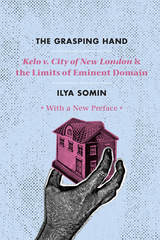 The Grasping Hand: "Kelo v. City of New London" and the Limits of Eminent Domain
Ilya Somin
University of Chicago Press, 2015 In 2005, the Supreme Court ruled that the city of New London, Connecticut, could condemn fifteen residential properties in order to transfer them to a new private owner. Although the Fifth Amendment only permits the taking of private property for “public use,” the Court ruled that the transfer of condemned land to private parties for “economic development” is permitted by the Constitution—even if the government cannot prove that the expected development will ever actually happen. The Court’s decision in Kelo v. City of New London empowered the grasping hand of the state at the expense of the invisible hand of the market.
In this detailed study of one of the most controversial Supreme Court cases in modern times, Ilya Somin argues that Kelo was a grave error. Economic development and “blight” condemnations are unconstitutional under both originalist and most “living constitution” theories of legal interpretation. They also victimize the poor and the politically weak for the benefit of powerful interest groups and often destroy more economic value than they create. Kelo itself exemplifies these patterns. The residents targeted for condemnation lacked the influence needed to combat the formidable government and corporate interests arrayed against them. Moreover, the city’s poorly conceived development plan ultimately failed: the condemned land lies empty to this day, occupied only by feral cats. The Supreme Court’s unpopular ruling triggered an unprecedented political reaction, with forty-five states passing new laws intended to limit the use of eminent domain. But many of the new laws impose few or no genuine constraints on takings. The Kelo backlash led to significant progress, but not nearly as much as it may have seemed.
Despite its outcome, the closely divided 5-4 ruling shattered what many believed to be a consensus that virtually any condemnation qualifies as a public use under the Fifth Amendment. It also showed that there is widespread public opposition to eminent domain abuse. With controversy over takings sure to continue, The Grasping Hand offers the first book-length analysis of Kelo by a legal scholar, alongside a broader history of the dispute over public use and eminent domain and an evaluation of options for reform.
Grass Productivity
Andre Voisin; Introduction by Allan Savory
Island Press, 1988 Grass Productivity is a prodigiously documented textbook of scientific information concerning every aspect of management "where the cow and grass meet." Andre Voisin's "rational grazing" method maximizes productivity in both grass and cattle operations.
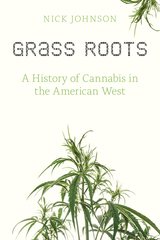 Grass Roots: A History of Cannabis in the American West
Nick Johnson
Oregon State University Press, 2017 Marijuana legalization is unfolding across the American West, but cultivation of the cannabis plant is anything but green. Unregulated outdoor grows are polluting ecosystems, high-powered indoor grows are churning out an excessive carbon footprint, and the controversial crop is becoming an agricultural boon just as the region faces an unprecedented water crisis.
To understand how we got here and how the legal cannabis industry might become more environmentally sustainable, Grass Roots looks at the history of marijuana growing in the American West, from early Mexican American growers on sugar beet farms to today’s sophisticated greenhouse gardens. Over the past eighty years, federal marijuana prohibition has had a multitude of consequences, but one of the most important is also one of the most overlooked—environmental degradation. Grass Roots argues that the most environmentally negligent farming practices—such as indoor growing—were borne out of prohibition. Now those same practices are continuing under legalization.
Grass Roots uses the history of cannabis as a crop to make sense of its regulation in the present, highlighting current efforts to make the marijuana industry more sustainable. In exploring the agricultural history of cannabis, There are many social and political histories of cannabis, but in considering cannabis as a plant rather than as a drug, Grass Roots offers the only agriculturally focused history to date.
 Grass Roots History
Theodore C. Blegen
University of Minnesota Press, 1947
Grass Roots History was first published in 1947. Minnesota Archive Editions uses digital technology to make long-unavailable books once again accessible, and are published unaltered from the original University of Minnesota Press editions.
The pivot of history is not the uncommon, but the usual, and the true makers of history are "the people, yes."
Theodore C. Blegen, writing with discernment and vigor, explores in his book the simple essence of grass roots history, the colors and forms and the processes of our daily life and civilization. He uses diaries and letters, songs and ballads of the immigrants and pioneers, everyday speech, and newspaper advertisements to show clearly and sharply the exciting sources of "the literature of the unlettered," to reveal the spirit of the day, and to reconstruct for the reader a segment of the American past.
"We have need to dig into the folk story of America if we are to bring out the pattern of American development and American culture in all its color and richness of texture and design. Grass roots history is an avenue to that 'social awareness' which the natural scientists, more boldly than the social scientists, have declared to be the most urgent and compelling need of our day."
This is the author's own statement of the significance of grass roots history.
 Grass Widow: Making My Way in Depression Alabama
Viola Goode Liddell
University of Alabama Press, 2004 An engaging account of one woman’s overcoming the Depression and small town mores. Viola Goode Liddell’s short memoir tells the story of her return to Alabama in search of a husband and a new life. Thirty years old and recently divorced, Liddell comes back to her home state—with her young son—determined to survive, during the depths of the Depression. Liddell narrates the obstacles she faces as a single mother in the 1930s Deep South with self-deprecating humor and a confessional tone that reveal both her intelligence and her unapologetic ambitions. Unable to earn, borrow, or beg enough money to support herself and her child, Liddell uses her family connections to secure a teaching position in Camden, Alabama. Even though an older sister’s status within the community helps her land the job, Liddell is warned that she must be very careful as she navigates the tricky social terrain of small town life, particularly when it comes to men. A commentary on the plight of women of the time is woven into the narrative as Liddell recounts her experience of being refused a loan at the local bank by her own brother-in-law. Despite all the restrictions on her behavior and the crushing reality that she has become "the biggest nuisance in the family" because of her past, Liddell cheerfully and successfully builds a new life of respectability and hope.
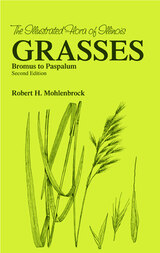 Grasses: Bromus to Paspalum, Second Edition
Robert H. Mohlenbrock
Southern Illinois University Press, 2002 Since the publication of the first edition of Grasses: Bromus to Paspalumin 1972, twenty-two additional taxa of grasses have been discovered in Illinois that are properly placed in this volume. In addition, numerous nomenclatural changes have occurred for plants previously discovered, and many distributional records have been added. New keys have been prepared for each genus where additional species from Illinois are known. For new species, full-page illustrations are provided. This second edition updates the status of Illinois grasses. The book features 263 figures from the first edition plus 21 new figures for this edition by Paul W. Nelson. Genera of grasses included in this work are Aegilops, Agropyron, Agrostis, Aira, Alopecurus, Anthoxanthum, Avena, Beckmannia, Briza, Bromus, Calamagrostis, Cinna, Dactylis, Deschampsia, Elyhordeum, Elymus, Elytrigia, Festuca, Hierochloe, Holcus, Hordeum, Koeleria, Lolium, Milium, Paspalum, Pennisetum, Phalaris, Phleum, Poa, Puccinellia, Sclerochloa, Secale, Sphenopholis, Torreyochloa, Triticum, and Vulpia.
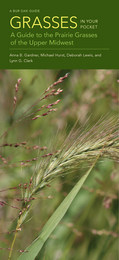 Grasses in Your Pocket: A Guide to the Prairie Grasses of the Upper Midwest
Anna B. Gardner, Michael Hurst, Deborah Lewis, and Lynn G. Clark
University of Iowa Press, 2014 At the time of European settlement, tallgrass prairie was the iconic landscape in much of the Upper Midwest. Although its extent has been drastically reduced, intact prairie remnants exist, prairie species persist along roadsides, and interest in prairie reconstruction has increased. The basic prairie matrix is formed by grasses, yet their diversity and beauty are often underappreciated because their flowering structures are highly reduced to aid in wind pollination. This much-needed addition to Iowa’s popular series of laminated guides—the twenty-sixth in the series—illustrates fifty-five grass species characteristic of or commonly found on prairies of the Upper Midwest states of Illinois, Iowa, Indiana, Michigan, Minnesota, Ohio, and Wisconsin.
The authors have organized species into groups by their most easily noted field characteristics. Are the flowering heads branched or unbranched? Are the branches dense, narrow, or fingerlike? For each species, its native or exotic status is followed by the months of flowering, abundance, general habitat, height, diagnostic features, geographic range, and, if relevant, threatened or endangered status.
Even amateur naturalists can identify big and little bluestem and prairie dropseed in the field, but both professional and amateur naturalists find certain grasses harder to identify, especially the less common or rare species such as cluster fescue and sand reedgrass. The photographs and descriptions in Grasses in Your Pocket will be an invaluable reference for outdoor expeditions in midwestern grasslands.
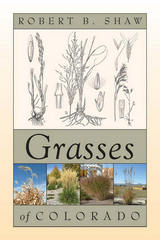 Grasses of Colorado
Robert B. Shaw
University Press of Colorado, 2008 This systematic treatment of Colorado grasses will help students, naturalists, botanists, ecologists, agronomists, range scientists, and other interested readers identify and learn about this unique and economically important plant family. Grasses of Colorado describes all grasses known to occur in the state outside of cultivation: more than 300 native, introduced, naturalized, and adventive species. Colorado's elevation range of more than 11,000 feet creates a wide variety of habitats that supports a spectacular diversity of grasses. With 335 known species, Colorado has one of the most diverse and extensive grass floras in the United States. Comprehensive coverage, useful keys, and detailed species descriptions in Grasses of Colorado will make this volume the standard reference for years to come. Robert B. Shaw provides overviews of Colorado's physiography and ecoregions and introduces the grass plant in plain, enjoyable text. He includes a checklist of Colorado grasses, a bibliography, and a glossary of terms that may be unfamiliar to nonspecialists. Line drawings, state distribution maps, and habitat notes for each species enable accurate plant identification, familiarity with regional ecogeography, and increased understanding of plant ecology of the Rocky Mountains. A monumental accomplishment certain to become the standard work on the subject, Grasses of Colorado synthesizes existing literature and incorporates recent scientific findings to offer a complete, current reference.
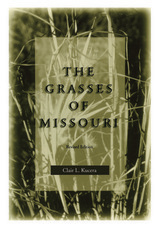 The Grasses of Missouri, Revised Edition
Clair L. Kucera
University of Missouri Press, 1998 Missouri's diverse landscapes, geology, and climate have endowed the state with a rich and varied grass flora. From tallgrass prairies to forested Ozarks to Mississippi lowlands, the state offers an array of grasses that can be classified into six subfamilies of the Poaceae, eighteen tribes, and eighty-seven genera. Significant changes have been made in grass classification since the first edition of The Grasses of Missouri was published in 1961, resulting in an increased emphasis on phyletic criteria. Recognizing the recent advances in classification and changes in nomenclature, as well as new additions to the flora, this newly revised edition serves as a compilation of the native and naturalized species and subspecific taxa found in Missouri. Formerly divided into two subfamilies, the Festucoideae and Panicoideae, the state's grass flora is now represented by six subfamilies. While the Panicoideae have remained intact, the traditional Festucoideae are now separated into smaller, more cohesive groupings. Further revisions have resulted in eighteen tribes compared to the twelve identified in the first edition. Covering more than 275 species and subspecific entities, The Grasses of Missouri is an essential research tool for identifying grasses, complete with working keys, descriptions, line drawings, distributions, a glossary, and a bibliography. The professional and lay person alike will benefit from this indispensable manual.
Grasses of the Intermountain Region
Laurel K. Anderton and Mary E. Barkworth
Utah State University Press, 2009 Grasses of the Intermountain Region is a modification of the two grass volumes of the Flora of North America (FNA). It is designed for identifying members of the Poaceae in the region between the Sierra Nevada and Rocky Mountains, and is intended for use by botanists working with the grasses in this intermountain region of North America. The reduction in number of taxa included from FNA has reduced the length of the keys and made it possible to include, in a single volume, descriptions and illustrations for all taxa treated as well as provide distribution maps for species that are established in the area. Another difference from the FNA volumes is that the maps in this volume show only records from IMR and adjacent areas rather than the full North America range of the taxa.
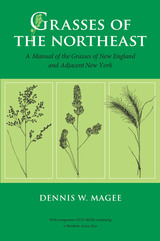 Grasses of the Northeast: A Manual of the Grasses of New England and Adjacent New York
Dennis W. Magee
University of Massachusetts Press, 2014 This book is designed to serve as a reference work, classroom textbook, and field manual for botanists, naturalists, and students interested in learning to identify and learn about the distinguishing features of grasses of the northeastern United States. Included are more than 380 species of grasses that have been documented as occurring in the region. The volume contains 246 range maps and 269 line drawings that clarify descriptions used in the keys and illustrate characteristics of the various kinds of grasses. Dennis Magee also provides a description of each genus and species along with synonyms and habitats. For anyone interested in an up-to-date treatment of the grasses of greater New England, this volume will be an invaluable resource. It is the only comprehensive technical guide devoted exclusively to the grasses of this region and presents a wealth of information in a precise, clear format.
The geographic scope of the work extends from the Canadian border south through Long Island and west to the Hudson River. But given the considerable overlap with the grass flora to the adjacent north, south, and west, the book will also be useful beyond New England and the bordering New York counties.
The volume includes an illustrated glossary of essential terms and concepts and a "how to use this manual" section. A CD-ROM with a multiple-entry identification guide, and hundreds of accompanying photographic images of individual species, is provided in a sleeve inside the back cover of the book.
Grasses of Wisconsin: The Taxonomy, Ecology, and Distribution of the Gramineae Growing in the State without Cultivation
Norman C. Fassett
University of Wisconsin Press, 1997 The definitive study of grasses, whether native or non-native, growing in the wild in Wisconsin. Includes meticulous descriptions, techniques, maps, and illustrations for locating and identifying these grasses, expert analysis, and a detailed glossary and index.
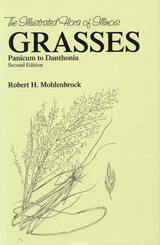 Grasses: Panicum to Danthonia, Second Edition
Robert H. Mohlenbrock
Southern Illinois University Press, 2001 Since the publication of the first edition of Grasses: Panicum to Danthonia in 1973, twenty additional taxa of grasses have been discovered in Illinois that are properly placed in this volume. In addition, numerous nomenclatural changes have occurred for plants already known from the state, and many distributional records have been added. This second edition updates the status of grasses in Illinois. Paul W. Nelson has provided illustrations for all of the additions. Because the nature of grass structures is generally so different from that of other flowering plants, a special terminology is applied to them. In his introduction, Robert H. Mohlenbrock cites these terms, with descriptions that make the identification of unknown specimens possible. Mohlenbrock’s division of the grass family into subfamilies and tribes is a major departure from the sequence usually found in most floristic works in North America. Synonyms that have been applied to species in the northeastern United States are given under each species. A description based primarily on Illinois material covers the more important features of the species. The common names—Paflic Grass, Billion Dollar Grass or Japanese Millett, Thread Love Grass, and Goose Grass—are the ones used locally in the state. The habitat designation and dot maps showing county distribution of each grass are provided only for grasses in Illinois, but the overall range for each species is also given.
 Grasses, Pods, Vines, Weeds: Decorating with Texas Naturals
Quentin Steitz
University of Texas Press, 1987 Purple three-awn.
Tree of heaven.
Alamo vine.
Narrowleaf cattail. These exotic and fanciful names conjure up visions of lush foliage, colorful grasses, and dense plant life. They are, in fact, names of native and naturalized Texas plants—grasses, pods, vines, and weeds. Lovely and all-too-often overlooked in nature, they become ornamental delights when used imaginatively and decoratively. Grasses, Pods, Vines, Weeds introduces 44 of Texas' most common and important naturals. Quentin Steitz shows how to recognize them and discover their aesthetic wealth. By taking the reader through all of the steps involved in utilizing naturals—from harvest to design—her book becomes an important tool for floral and landscape designers, decorators, horticulturalists, home gardeners, botanists: all those people who enjoy hands-on experience with Texas' vast array of native and naturalized plants. The book presents clear and concise descriptions of many Texas naturals, accompanied by approximately 150 full-color photographs showing each in one or more stages of growth and also in a design. The reader can see the plant as it looks not only in the wild but also in an arrangement. The author offers techniques on how the species can be prepared for display, discussing drying and arranging. And a chapter on cultivation and conservation suggests to outdoor enthusiasts species they can grow for decorative natural materials as well as conserve and appreciate in the wild. Grasses, Pods, Vines,Weeds is enhanced by flora selected, collected, prepared, and dried by the author. These hand-culled materials have been used in designs contributed by some nineteen notable floral designers as well as the author. The text and designs combine to reveal the fresh, creative applications of Texas' decorative naturals and to increase our pleasure in the wonders of natural Texas.
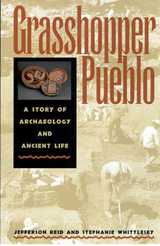 Grasshopper Pueblo: A Story of Archaeology and Ancient Life
Jefferson Reid and Stephanie Whittlesey
University of Arizona Press, 1999 Located in the mountains of east-central Arizona, Grasshopper Pueblo is a prehistoric ruin that has been excavated and interpreted more thoroughly than most sites in the Southwest: more than 100 rooms have been unearthed here, and artifacts of remarkable quantity and quality have been discovered. Thanks to these findings, we know more about ancient life at Grasshopper than at most other pueblos. Now two archaeologists who have devoted more than two decades to investigations at Grasshopper reconstruct the life and times of this fourteenth-century Mogollon community.
Written for general readers—and for the White Mountain Apache, on whose land Grasshopper Pueblo is located and who have participated in the excavations there—the book conveys the simple joys and typical problems of an ancient way of life as inferred from its material remains. Reid and Whittlesey's account reveals much about the human capacity for living under what must strike modern readers as adverse conditions. They describe the environment with which the people had to cope; hunting, gathering, and farming methods; uses of tools, pottery, baskets, and textiles; types of rooms and households; and the functioning of social groups. They also reconstruct the sacred world of Grasshopper as interpreted through mortuary ritual and sacred objects and discuss the relationship of Grasshopper residents with neighbors and with those who preceded and followed them.
Grasshopper Pueblo not only thoroughly reconstructs this past life at a mountain village, it also offers readers an appreciation of life at the field school and an understanding of how excavations have proceeded there through the years. For anyone enchanted by mysteries of the past, it reveals significant features of human culture and spirit and the ultimate value of archaeology to contemporary society.
 Grass-pinks and Companion Orchids in Your Pocket: A Guide to the Native Calopogon, Bletia, Arethusa, Pogonia, Cleistes, Eulophia, Pteroglossaspis, and
Paul Martin Brown
University of Iowa Press, 2008 Native orchids are increasingly threatened by pressure from population growth and development but, nonetheless, still present a welcome surprise to observant hikers in every state and province. Compiled and illustrated by long-time orchid specialist Paul Martin Brown, these pocket guides to grass-pinks and their companions form part of a series that will cover all the wild orchids of the continental United States and Canada.
Brown provides general distributional information, time of flowering, and habitat requirements for each species as well as a complete list of hybrids and the many different growth and color forms that can make identifying orchids so intriguing. For the grass-pinks and companions he includes information on 16 species, 2 additional varieties, and 7 hybrids.
Grass-pinks, with their showy pink to white flowers, are some of the most conspicuous wild orchids encountered in the prairies, bogs, and open wetlands of eastern North America. Most of these species are easy to identify based upon their general appearance, range, and time of flowering. Answering three simple questions—when, where, and how does it grow?—and comparing the living plant with the striking photos in the backpack-friendly laminated guide should enable both professional and amateur naturalists to achieve the satisfaction of identifying a specific orchid.
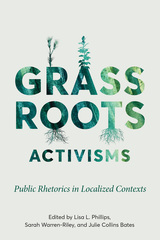 Grassroots Activisms: Public Rhetorics in Localized Contexts
Edited by Lisa L. Phillips, Sarah Warren-Riley, and Julie Collins Bates
Ohio State University Press, 2024 What is the nature of grassroots activism? How and why do individuals get involved or attempt to make change for themselves, others, or their own communities? What motivates activists to maintain momentum when their efforts to redress injustices or paths toward change seem difficult or personally risky to navigate? These questions and more are addressed in Grassroots Activisms: Public Rhetorics in Localized Contexts. Featuring a diverse array of both local activist profiles and original scholarly essays, the collection amplifies and analyzes the tactics of grassroots activists working locally to intervene in a variety of social injustices—from copwatching and policy reform to Indigenous resistance against land colonization to #RageAgainstRape.
Attuned to the demanding—and often underappreciated—work of grassroots activism, this book interrogates how such efforts unfold within and against existing historical, cultural, social, and political realities of local communities; are informed by the potentials and constraints of coalition-building; and ultimately shape different facets of society at the local level. This collection acknowledges and celebrates the complexity of grassroots activist work, showing how these less-recognized efforts often effect change where institutions have failed.
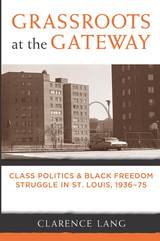 Grassroots at the Gateway: Class Politics and Black Freedom Struggle in St. Louis, 1936-75
Clarence Lang
University of Michigan Press, 2010 "This is a theoretically sophisticated and thoroughly documented historical case study of the movements for African American liberation in St. Louis. Through detailed analysis of black working class mobilization from the depression years to the advent of Black Power, award-winning historian Clarence Lang describes how the advances made in earlier decades were undermined by a black middle class agenda that focused on the narrow aims of black capitalists and politicians. The book is a major contribution to our understanding of the black working class insurgency that underpinned the civil rights and Black Power campaigns of the twentieth century."
---V. P. Franklin, University of California, Riverside "A major work of scholarship that will transform historical understanding of the pivotal role that class politics played in both civil rights and Black Power activism in the United States. Clarence Lang's insightful, engagingly written, and well-researched study will prove indispensable to scholars and students of postwar American history."
---Peniel Joseph, Brandeis University Breaking new ground in the field of Black Freedom Studies, Grassroots at the Gateway reveals how urban black working-class communities, cultures, and institutions propelled the major African American social movements in the period between the Great Depression and the end of the Great Society. Using the city of St. Louis in the border state of Missouri as a case study, author Clarence Lang undermines the notion that a unified "black community" engaged in the push for equality, justice, and respect. Instead, black social movements of the working class were distinct from---and at times in conflict with---those of the middle class. This richly researched book delves into African American oral histories, records of activist individuals and organizations, archives of the black advocacy press, and even the records of the St. Louis' economic power brokers whom local black freedom fighters challenged. Grassroots at the Gateway charts the development of this race-class divide, offering an uncommon reading of not only the civil rights movement but also the emergence and consolidation of a black working class. Clarence Lang is Assistant Professor in African American Studies and History at the University of Illinois at Urbana-Champaign. Photo courtesy Western Historical Manuscript Collection, University of Missouri, St. Louis
Grassroots Economies: Living with Austerity in Southern Europe
Susana Narotzky
Pluto Press, 2020 The austerity crisis has radically altered the economic landscape of Southern Europe. But alongside the decimation of public services and infrastructure lies the wreckage of a generation's visions for the future. In Greece, Italy, Spain and Portugal, there is a new, difficult reality of downward mobility.
Grassroots Economies interrogates the effects of the economic crisis on the livelihood of working people, providing insight into their anxieties. Drawing on a rich seam of ethnographic material, it is a distinctive comparative analysis that explores the contradictions of their coping mechanisms and support structures.
With a focus on gender, the book explores values and ideologies, including dispossession and accumulation. Ultimately it demonstrates that everyday interactions on the local scale provide a significant sense of the global.
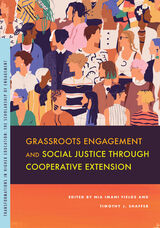 Grassroots Engagement and Social Justice through Cooperative Extension
Nia Imani Fields
Michigan State University Press, 2022 Grassroots Engagement and Social Justice through Cooperative Extension grows out of a commitment to the belief that Cooperative Extension professionals can and should be deeply engaged with the communities they work in to improve life—individually and collectively. Rooted in an understanding of the history and development of Extension, the authors focus on contemporary efforts to address systemic inequities. They offer an alternative to the “expert” model that would have Extension educators provide information detached from the difficult and sometimes contentious issues that shape community work. These essays highlight Extension’s role in and responsibility for culturally relevant community education that is rooted in democratic practices and social justice. The ultimate aim of this book is to offer a vision for the future of Extension as its practitioners continue to reach for cultural competence necessary to address issues of systemic injustice in the communities they serve and of which they are a part.
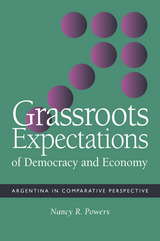 Grassroots Expectations of Democracy and Economy: Argentina in Comparative Perspective
Nancy R. Powers
University of Pittsburgh Press, 2001
This highly readable study addresses a range of fundamental questions about the interaction of politics and economics, from a grassroots perspective in post-transition Argentina. Nancy R. Powers looks at the lives and political views of Argentines of little to modest means to examine systematically how their political interests, and their evaluations of democracy, are formed. Based on the author’s fieldwork in Argentina, the analysis extends to countries of Latin America and Eastern Europe facing similarly difficult political and economic changes.
Powers uses in-depth interviews to examine how (not simply what) ordinary people think about their standard of living, their government, and the democratic regime. She explains why they sometimes do, but more often do not, see their material conditions as political problems, arguing that the type of hardship and the possibilities for coping with it are more politically significant than the degree of hardship. She analyzes alternative ways in which people define democracy and judge its legitimacy.
Not only does Powers demonstrate contradictions and gaps in the existing scholarship on economic voting, social movements, and populism, she also shows how those literatures are addressing similar questions but are failing to “talk” to one another. Powers goes on to build a more comprehensive theory of how people at the grassroots form their political interests. To analyze why people perceive only some of their material hardships as political problems, she brings into the study of politics ideas drawn from Amartya Sen and other scholars of poverty.
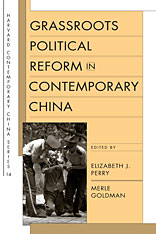 Grassroots Political Reform in Contemporary China
Elizabeth J. Perry
Harvard University Press, 2007 Observers often note the glaring contrast between China's stunning economic progress and stalled political reforms. Although sustained growth in GNP has not brought democratization at the national level, this does not mean that the Chinese political system has remained unchanged. At the grassroots level, a number of important reforms have been implemented in the last two decades.
This volume, written by scholars who have undertaken substantial fieldwork in China, explores a range of grassroots efforts--initiated by the state and society alike--intended to restrain arbitrary and corrupt official behavior and enhance the accountability of local authorities. Topics include village and township elections, fiscal reforms, legal aid, media supervision, informal associations, and popular protests. While the authors offer varying assessments of the larger significance of these developments, their case studies point to a more dynamic Chinese political system than is often acknowledged. When placed in historical context--as in the Introduction--we see that reforms in local governance are hardly a new feature of Chinese political statecraft and that the future of these experiments is anything but certain.
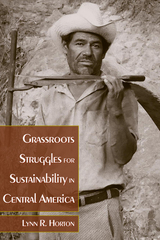 Grassroots Struggles for Sustainability in Central America
Lynn R. Horton
University Press of Colorado, 2007 In recent years, sustainable development has emerged as a central goal of the World Bank and grassroots activists alike. In Grassroots Struggles for Sustainability in Central America, Lynn R. Horton explores the implications of this new, often contested discourse and related policies for Central America's rural and indigenous poor. Drawing on the testimony of leaders and residents of three communities in Nicaragua, Costa Rica, and Panama, Horton explores grassroots assumptions, values, and practices of sustainable development and, in particular, the ways in which they overlap with or challenge international financial institutions' discourse of sustainability.
With a comparative, empirical approach, Horton also analyzes dominant practices linked to sustainable development - neoliberal reforms, project interventions, and environmental protection. She reveals how these practices support or undermine economic, cultural, and political opportunities for the rural and indigenous poor and impact these communities' advancement of their own visions of sustainability. Finally, the author explores processes of empowerment that enable communities to articulate and put into practice local visions of sustainability, which contribute toward broader social and structural transformations.
Grassroots Struggles for Sustainability in Central America will interest sociologists, anthropologists, and others who study the theory and practice of sustainable development.
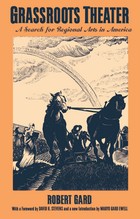 Grassroots Theater: A Search for Regional Arts in America
Robert Gard; With a Foreword by David H. Stevens and a new Introduction by Maryo Gard Ewell
University of Wisconsin Press, 1999 Robert Gard’s timeless book is a moving account of one man’s struggle to bring his dream of community-building through creative theater to citizens around the country. He traveled across America—from New York’s Finger Lakes to the prairies of Alberta, Canada, to the backwoods of northern Wisconsin—discovering and nurturing the folklore, legends, history, and drama of the region. He talked to ballad singers, painters, the tellers of tall tales, and farm women, whose poetry and painting reflected the elemental violence of nature and quiet joys of neighborliness. Grassroots Theater reminds us that an individual’s creative vision transcends technology, current events, and changing demographics. This reprint of Grassroots Theater was generously funded by the Robert E. Gard Wisconsin Idea Foundation, an affiliate of the Wisconsin Academy of Sciences, Arts & Letters.
 The Grateful Dead: THE HISTORY OF A FOLK STORY
Gordon Hall GerouldIntroduction by Norm Cohen
University of Illinois Press, 2000 In this classic study, originally published in 1908, Gordon Hall Gerould explores a body of literature devoted to the ghosts of the departed, lost souls who showed gratitude to those who took care of their bodies and assisted in getting rid of demons. Typically, the grateful dead stories concern a young hero who takes on the responsibility of seeing that an unburied corpse receives a proper burial. A stranger who offers to accompany and assist him turns out to be the ghost of the dead man, repaying the hero for his good deed.
Gerould surveys more than a hundred grateful dead stories, tracing their lineages, describing their common traits, and unraveling their variations. Through a close study of secular as well as religious stories, Gerould demonstrates the remarkable durability and adaptability of the grateful dead.
With this book, Gerould established methods that laid the foundations for modern folklore scholarship. Norm Cohen's introduction places Gerould and his legacy in this historical context.
 Grateful Nation: Student Veterans and the Rise of the Military-Friendly Campus
Ellen Moore
Duke University Press, 2017 In today's volunteer military many recruits enlist for the educational benefits, yet a significant number of veterans struggle in the classroom, and many drop out. The difficulties faced by student veterans have been attributed to various factors: poor academic preparation, PTSD and other postwar ailments, and allegedly antimilitary sentiments on college campuses. In Grateful Nation Ellen Moore challenges these narratives by tracing the experiences of Iraq and Afghanistan war veterans at two California college campuses. Drawing on interviews with dozens of veterans, classroom observations, and assessments of the work of veteran support organizations, Moore finds that veterans' academic struggles result from their military training and combat experience, which complicate their ability to function in civilian schools. While there is little evidence of antimilitary bias on college campuses, Moore demonstrates the ways in which college programs that conflate support for veterans with support for the institutional military lead to suppression of campus debate about the wars, discourage antiwar activism, and encourage a growing militarization.
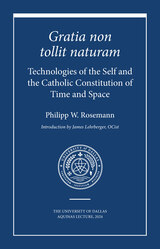 Gratia non tollit naturam: Technologies of the Self and the Catholic Constitution of Time and Space
Philipp W. Rosemann
St. Augustine's Press, 2025 In this short volume, Phillip Rosemann sets out to articulate the structures of Catholic existence in terms adapted from contemporary philosophy. Using a concept from the last works of Michel Foucault, Rosemann focuses on the liturgy as a "technology of the self." Through language, the liturgy "makes" the world in which the believer lives. But whereas modern philosophers hold that the human mind imposes its structures upon reality, the liturgical self exists in accordance with a cosmin order that stems from the Word.
If one dialogue partner is Michel Foucault, the other is Joseph Ratzinger, the late Pope Benedict XVI. Although this pairing may seem surprising, two facts suggest its fruitfulness. First, scholars now speak of a "Christian turn" in the late Foucault, a thinker often denounced - falsely - as the epitome of philosophical decadence. Second, as one of the leading liturgists of our time, Ratzinger incorporated crucial insights from modern philosophy into his liturgical theology. In relation to Ratzinger, too, moreover, some clichés need to be corrected.
In the resulting dialogue between Foucault and Ratzinger, the reader discovers what is the specific mode of existence of the "liturgical subject," and how Catholic time and space are constituted liturgically. In the end, the Thomistic adage gratia non tollit naturam turns out to be an excellent way of summarizing how the liturgical subject relates to the cosmos: not by destroying it, but by listening to the words of creation and perfecting them.
The University of Dallas Aquinas Lecture for 2024, Gratia non tollit naturam is published here with an introduction by Fr. James Lehrberger, OCist.
Gratian the Theologian
John C. Wei
Catholic University of America Press, 2016 Gratian the Theologian shows how one of the best-known canonists of the medieval period was also an accomplished theologian. Well into the twelfth century, compilations of Church law often dealt with theological issues. Gratian's Concordia discordantium canonum or Decretum, which was originally compiled around 1140, was no exception, and so Wei claims in this provocative book. The Decretum is the fundamental canon law work of the twelfth century, which served as both the standard textbook of canon law in the medieval schools and an authoritative law book in ecclesiastical and secular courts. Yet theology features prominently throughout the Decretum, both for its own sake and for its connection to canon law and canonistic jurisprudence.
 Gratian's Tractatus de penitentia
Atria A. Larson
Catholic University of America Press, 2016 Gratian's Decretum is one of the major works in European history, a text that in many ways launched the field of canon law. In this new volume, Atria Larson presents to students and scholars alike a critical edition of De penitentia (Decretum C.33 q.3), the foundational text on penance, both for canon law and for theology, of the twelfth century. This edition takes into account recent manuscript discoveries and research into the various recensions of Gratian's text and proposes a model for how a future critical edition of the entire Decretum could be formatted by offering a facing-page English translation. This translation is the first of this section of Gratian's De penitentia into any modern language and makes the text accessible to a wider audience. Both the Latin and the English text are presented in a way to make clear the development of Gratian's text in various stages within two main recensions. The edition and translation are preceded by an introduction relating the latest scholarship on Gratian and his text and are followed by three appendices, including one that provides a transcription of the relevant text from the debated manuscript Sankt Gallen, Stiftsbibliothek 673, and one that lists possible formal sources and related contemporary texts. This book provides a full edition and translation of the text studied in depth in Master of Penance: Gratian and the Development of Penitential Thought and Law in the Twelfth Century (CUA Press, 2014) by the same author.
 The Gratis Economy: Privately Provided Public Goods
András Kelen
Central European University Press, 2002 A work in the relatively new field of economic sociology, this highly unconventional book deals with the logics of toll-free services and generalizes the notion of voluntary work toward encompassing everything that can be obtained free of charge in the world. The author claims that the publicity-driven gratis economy -– perhaps the greatest wealth-creator in history -– is integrating into the conventional non-profit sector. Kelen’s exploration of the gratis economy covers the three basic institutional sectors: nonprofit/voluntary, business and government. The ‘New Economy’ offers a wide range of services seemingly for free, but the costs are still supposed to be borne by some actors of the economy. The message of the book is very important: the motives of the gratis giving of goods or services can always be identified and could be explained either by ‘motivated giving’ or by ‘hidden marketing’. These motives often lie outside of the scope of traditional economics and may have strong political, sociological and/or psychological connotations. The Gratis Economy will be of interest to professors and students of applied economics and business schools, sociologists, to the e-business community, marketing practitioners, webspinners, infonauts, netizens, software developers and decision-makers of electronic media.
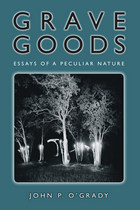 Grave Goods
John P. O'Grady
University of Utah Press, 2014 "Overheard in a coffee shop the other day, one young woman severely admonishing another about the dangers of amateur séances: 'Just one wrong move, and Poof! Suddenly every dead rock star and TV evangelist is knocking at your door and forcing you to bake ten thousand apple pies. You can’t trust these ghosts. They have a mind of their own.'"
—from the book Just because this is a collection of essays about psychics, murderers, strange disappearances, and occult phenomena doesn’t mean it isn’t funny. With wit, wry curiosity, and redemptive irony John P. O’Grady peels back the surface of the seemingly normal to reveal the dubious, the inexplicable, the outlandish. Consider Leo LaHappe, a.k.a. "The Bugman." During a 1970s-era dormitory bull session Leo reveals a strange obsession with Virginia Dare, the first child born of English parents in the New World. His obsession becomes the catalyst for a campus-wide witch hunt at the University of Maine. Or, what about the beekeeper who knocks on O’Grady’s door. Dressed in his professional gear—boots, coveralls, and dark veil—the man seeks permission to search the author’s woods for his hive. Turns out he hadn’t told the bees about his mother’s death and, sensitive creatures that they are, the bees had run away. "I have to tell them I’m sorry," the beekeeper explains. "I just hope they forgive me and come home." Grave Goods includes ghost stories, macabre modern legends, and metaphysical investigations, all informed by the natural sciences, history, philosophy, literature, and mythology. From laugh-out-loud funny to eerily thoughtful, these essays reveal the natural world as a place of unnatural surprises and strange beauty. A place where Rip Van Winkle, O’Grady’s college buddies, and ragtag psychics rub shoulders with Buddha, Socrates, and Stephen King—and it all makes perfect sense.
 Grave New World: Security Challenges in the 21st Century
Michael E. Brown, Editor
Georgetown University Press, 2003 The optimism that arrived at the end of the cold war and marked the turn of the Millennium was shattered by September 11. In the aftermath of that event it is not unwarranted pessimism that lines the pages of Grave New World, it is unavoidable reality. Terrorism is but one aspect of many other wider concerns for national and international security, and the contributors to this volume not only warn us, but reward us as well with the clarity of their views into—and possible solutions for—a difficult, complicated future. They speak convincingly of the numerous military and non-military challenges that create security problems—whether those are interstate, intrastate, or transnational—many of which are being dangerously overlooked in public policy debates. The challenges and complexities might seem insurmountable but the first step in solving problems is recognizing that they exist. Grave New World provides an eye-opening assessment of the prospects for peace and security in the 21st century. Michael E. Brown frames these issues in his Introduction, "Security Challenges in the 21st Century;" and in his summation, "Security Problems and Security Policy in a Grave New World."
Gravel and Hawk: Poems
Nick Norwood
Ohio University Press, 2012 Gravel and Hawk dwells on the physical and cultural landscapes of the Texarkana border region, an area of stark natural beauty and even starker manifestations of its human habitation: oil derricks and pump jacks, logging trucks, chicken houses, come-to-Jesus billboards, and greasy catfish joints, a patchwork of dying farm towns and ragtag municipalities laced together by county roads, state highways, and that treacherous, rust-hued slurry known as the Red River. Gravel and Hawk charts the emotional landscape of a single extended family, its history of loss and gain, and, especially, its encounters with violent death. It is an eminently readable collection, rooted in a distinctly American place and united by a poetic voice that is honest, sophisticated, and persuasive.
 Gravity Does Not Exist: A Puzzle for the 21st Century
Vincent Icke
Amsterdam University Press, 2014 Every scientific fact was born as an opinion about the unknown - a hypothesis. Opinion gradually becomes fact as evidence piles up to support a theory. But what if there are two theories, each of which has produced a myriad of things that correspond perfectly to the phenomena but can't be combined into one? One theory replaced the mystery of gravity with a precise model of space and time. The other theory replaced the mystery of matter with a description of quantum particles.
As we understand our universe, we keep each in its own domain: space and time for very large things, particles for the very small ones. However, 13.8 billion years ago, those two incompatible domains belonged to a single realm. Who in the current or future generations of physicists will crack this seemingly impossible puzzle? This, contends the author, is not just a big question, but the biggest question in physics in our century.
Combining Ickes's first-hand knowledge with a robust argument and intellectual playfulness, this fascinating book succeeds in making a notoriously difficult subject accessible to all readers interested in a better grasp of our universe.
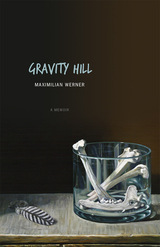 Gravity Hill: A Memoir
Maximilian Werner
University of Utah Press, 2013 “The sound of parenthood is the sigh.” So begins Gravity Hill, written from the perspective of a new father seeking hope, beauty, and meaning in an uncertain world. Many memoirs recount the author’s experiences of growing up and struggling with demons; Werner’s shows how old demons sometimes return on the heels of something as beautiful as children. Werner’s memoir is about growing up, getting older, looking back, and wondering what lies ahead—a process that becomes all the more complicated and intense when parenting is involved. Moving backward and forward between past, present, and future, Gravity Hill does not delineate time so much as collapse it. Werner narrates his struggle growing up in suburban Utah as anon-Mormon and what it took for him, his siblings, and his friends to feel like they belonged. Bonding in separation, they indulged in each other, in natural and urban landscapes, and sometimes in the destructive behaviors that are the native resort of outsidersincluding promiscuous and occasionally violent sexual behavior—and for some, paths to death and suicide. Gravity Hill is the story of the author’s descent into and eventual emergence from his dysfunction and into a newfound life. Infused with humor, honesty, and reflection, this literary memoir will resonate with readers young and old.
Gravity: Selected Letters of Olivia Langdon Clemens
Edited by Barbara E. Snedecor
University of Missouri Press, 2023 In this new volume of letters, readers are invited to meet Olivia Louise Langdon Clemens on her own terms, in her own voice—as complementary partner to her world-famous spouse, Mark Twain, and as enduring friend, mother to four children, world traveler, and much more. The frail woman often portrayed by scholars, biographers, and Twain himself is largely absent in these letters. Instead, Olivia (who Twain affectionately referred to as “Gravity” in their early correspondence) emerges as a resilient and energetic nineteenth-century woman, her family’s source and center of stability, and a well of private and public grace in an ever-changing landscape. Mark Twain’s biography recounted in Olivia’s letters offers new insights, and her captivating voice is certain to engage and enlighten readers.
 Gravity’s Century: From Einstein’s Eclipse to Images of Black Holes
Ron Cowen
Harvard University Press, 2019 A sweeping account of the century of experimentation that confirmed Einstein’s general theory of relativity, bringing to life the science and scientists at the origins of relativity, the development of radio telescopes, the discovery of black holes and quasars, and the still unresolved place of gravity in quantum theory.
Albert Einstein did nothing of note on May 29, 1919, yet that is when he became immortal. On that day, astronomer Arthur Eddington and his team observed a solar eclipse and found something extraordinary: gravity bends light, just as Einstein predicted. The finding confirmed the theory of general relativity, fundamentally changing our understanding of space and time.
A century later, another group of astronomers is performing a similar experiment on a much larger scale. The Event Horizon Telescope, a globe-spanning array of radio dishes, is examining space surrounding Sagittarius A*, the supermassive black hole at the center of the Milky Way. As Ron Cowen recounts, the foremost goal of the experiment is to determine whether Einstein was right on the details. Gravity lies at the heart of what we don’t know about quantum mechanics, but tantalizing possibilities for deeper insight are offered by black holes. By observing starlight wrapping around Sagittarius A*, the telescope will not only provide the first direct view of an event horizon—a black hole’s point of no return—but will also enable scientists to test Einstein’s theory under the most extreme conditions.
Gravity’s Century shows how we got from the pivotal observations of the 1919 eclipse to the Event Horizon Telescope, and what is at stake today. Breaking down the physics in clear and approachable language, Cowen makes vivid how the quest to understand gravity is really the quest to comprehend the universe.
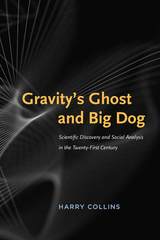 Gravity's Ghost and Big Dog: Scientific Discovery and Social Analysis in the Twenty-First Century
Harry Collins
University of Chicago Press, 2013 Gravity’s Ghost and Big Dog brings to life science’s efforts to detect cosmic gravitational waves. These ripples in space-time are predicted by general relativity, and their discovery will not only demonstrate the truth of Einstein’s theories but also transform astronomy. Although no gravitational wave has ever been directly detected, the previous five years have been an especially exciting period in the field. Here sociologist Harry Collins offers readers an unprecedented view of gravitational wave research and explains what it means for an analyst to do work of this kind. Collins was embedded with the gravitational wave physicists as they confronted two possible discoveries—“Big Dog,” fully analyzed in this volume for the first time, and the “Equinox Event,” which was first chronicled by Collins in Gravity’s Ghost. Collins records the agonizing arguments that arose as the scientists worked out what they had seen and how to present it to the world, along the way demonstrating how even the most statistical of sciences rest on social and philosophical choices. Gravity’s Ghost and Big Dog draws on nearly fifty years of fieldwork observing scientists at the American Laser Interferometer Gravitational Wave Observatory and elsewhere around the world to offer an inspired commentary on the place of science in society today.
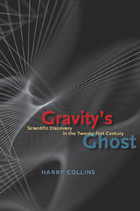 Gravity's Ghost: Scientific Discovery in the Twenty-first Century
Harry Collins
University of Chicago Press, 2010 In theory, at least, gravitational waves do exist. We are constantly bathed in gravitational radiation, which is generated when stars explode or collide and a portion of their mass becomes energy that ripples out like a disturbance on the surface of a serene pond. But unfortunately no gravitational wave has ever been directly detected even though the search has lasted more than forty years. As the leading chronicler of the search for gravitational waves, Harry Collins has been right there with the scientists since the start. The result of his unprecedented access to the front lines of physical science is Gravity’s Ghost, a thrilling chronicle of high-stakes research and cutting-edge discovery. Here, Collins reveals that scientific discovery and nondiscovery can turn on scientific traditions and rivalries, that ideal statistical analysis rests on impossible procedures and unattainable knowledge, and that fact in one place is baseless assumption in another. He also argues that sciences like gravitational wave detection, in exemplifying how the intractable is to be handled, can offer scientific leadership a moral beacon for the twenty-first century. In the end, Gravity’s Ghost shows that discoveries are the denouements of dramatic scientific mysteries.
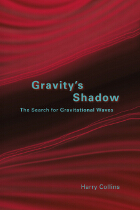 Gravity's Shadow: The Search for Gravitational Waves
Harry Collins
University of Chicago Press, 2004 According to the theory of relativity, we are constantly bathed in gravitational radiation. When stars explode or collide, a portion of their mass becomes energy that disturbs the very fabric of the space-time continuum like ripples in a pond. But proving the existence of these waves has been difficult; the cosmic shudders are so weak that only the most sensitive instruments can be expected to observe them directly. Fifteen times during the last thirty years scientists have claimed to have detected gravitational waves, but so far none of those claims have survived the scrutiny of the scientific community. Gravity's Shadow chronicles the forty-year effort to detect gravitational waves, while exploring the meaning of scientific knowledge and the nature of expertise.
Gravitational wave detection involves recording the collisions, explosions, and trembling of stars and black holes by evaluating the smallest changes ever measured. Because gravitational waves are so faint, their detection will come not in an exuberant moment of discovery but through a chain of inference; for forty years, scientists have debated whether there is anything to detect and whether it has yet been detected. Sociologist Harry Collins has been tracking the progress of this research since 1972, interviewing key scientists and delineating the social process of the science of gravitational waves.
Engagingly written and authoritatively comprehensive, Gravity's Shadow explores the people, institutions, and government organizations involved in the detection of gravitational waves. This sociological history will prove essential not only to sociologists and historians of science but to scientists themselves.
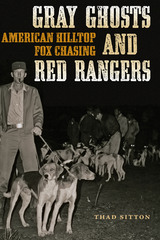 Gray Ghosts and Red Rangers: American Hilltop Fox Chasing
By Thad Sitton
University of Texas Press, 2010 Around a campfire in the woods through long hours of night, men used to gather to listen to the music of hounds' voices as they chased an elusive and seemingly preternatural fox. To the highly trained ears of these backwoods hunters, the hounds told the story of the pursuit like operatic voices chanting a great epic. Although the hunt almost always ended in the escape of the fox—as the hunters hoped it would—the thrill of the chase made the men feel "that they [were] close to something lost and never to be found, just as one can feel something in a great poem or a dream." Gray Ghosts and Red Rangers offers a colorful account of this vanishing American folkway—back-country fox hunting known as "hilltopping," "moonlighting," "fox racing," or "one-gallus fox hunting." Practiced neither for blood sport nor to put food on the table, hilltopping was worlds removed from elite fox hunting where red- and black-coated horsemen thundered across green fields in daylight. Hilltopping was a nocturnal, even mystical pursuit, uniting men across social and racial lines as they gathered to listen to dogs chasing foxes over miles of ground until the sun rose. Engaged in by thousands of rural and small-town Americans from the 1860s to the 1980s, hilltopping encouraged a quasi-spiritual identification of man with animal that bound its devotees into a "brotherhood of blood and cause" and made them seem almost crazy to outsiders.
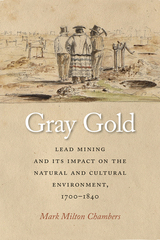 Gray Gold: Lead Mining and Its Impact on the Natural and Cultural Environment, 1700–1840
Mark Chambers
University of Tennessee Press, 2021 Winner of the Clark C. Spence Award from the Mining History Association!
While the histories of gold, silver, and copper mining and smelting are well studied, lead has not received much scholarly attention despite a long history of both Native American and European desire for the ore. Over time, native peoples made lead ornaments in molds; French and American settlers used lead to form musket balls; red lead became an important production element for flint and crystal production; and white lead was used in making paint until the mid-twentieth century.
Gray Gold aims to broaden understandings of early colonial and Native American history by turning attention to the ways that mining—and its scientific, technological, economic, cultural, and environmental features—shaped intercultural interactions and developments in the New World. Backed by remarkable original sources such as firsthand mining accounts, letters, and surveys, Mark Chambers’s study demonstrates how early mining techniques affected the culture clash between Native Americans and Europeans all the while tracking the impact increased mining had on the environment of what would become the states of Illinois and Missouri. Chambers traces the evolution of lead mining and smelting technology through pre-contact America, to the amalgamation of aboriginal processes with French colonial development, through Spain’s short occupation to the Louisiana Purchase and ultimately the technology transfer from Europe to an efficient and year-round standard of practice after American assumption. Additionally, while slavery in early American industry has been touched on in iron manufacturing and coal mining scholarship, the lead mining context sheds new light on the history of that grievous institution.
Gray Gold adds significantly to the understanding of lead mining and the economic and industrial history of the United States. Chambers makes important contributions to the fields of United States history, Native American and frontier history, mining and environmental history, and the history of science and technology.
 Gray Love: Stories About Dating and New Relationships After 60
Nan Bauer-Maglin
Rutgers University Press, 2023 Gray Love narrates stories about the most common themes – searching for and (perhaps) finding love. Forty-five men and women between ages 60 and 94 from diverse backgrounds talk about dating, starting or ending a relationship, embracing life alone or enjoying a partnered one. The longing for connection as old age encroaches is palpable here, with more and more senior singles searching online. Those who find new partners explore issues that most relationships encounter at any age, as well as some that are unique to elder relationships. These include having had previous partners and a complicated and deep personal history; family and friends’ reactions to an older person’s dating; alternative models to marriage (such as sharing space or living apart); having more than one partner at the same time; one’s aging body, appearance, and sexuality; and the pressure of time and the specter of illness and death.
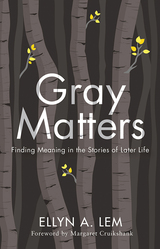 Gray Matters: Finding Meaning in the Stories of Later Life
Ellyn Lem
Rutgers University Press, 2020 Winner of the 2021 Excellence in Research and Scholarly Activity Award from the University of Wisconsin-Milwaukee
Finalist for the 2021 American Book Fest Best Book Awards
Aging is one of the most compelling issues today, with record numbers of seniors over sixty-five worldwide. Gray Matters: Finding Meaning in the Stories of Later Life examines a diverse array of cultural works including films, literature, and even art that represent this time of life, often made by people who are seniors themselves. These works, focusing on important topics such as housing, memory loss, and intimacy, are analyzed in dialogue with recent research to explore how “stories” illuminate the dynamics of growing old by blending fact with imagination. Gray Matters also incorporates the life experiences of seniors gathered from over two hundred in-depth surveys with a range of questions on growing old, not often included in other age studies works. Combining cultural texts, gerontology research, and observations from older adults will give all readers a fuller picture of the struggles and pleasures of aging and avoids over-simplified representations of the process as all negative or positive.
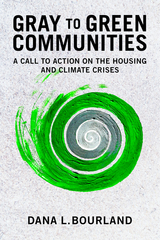 Gray to Green Communities: A Call to Action on the Housing and Climate Crises
Dana Bourland
Island Press, 2020 US cities are faced with the joint challenge of our climate crisis and the lack of housing that is affordable and healthy. Our housing stock contributes significantly to the changing climate, with residential buildings accounting for 20 percent of greenhouse gas emissions. US housing is not only unhealthy for the planet, it is putting the physical and financial health of residents at risk. Our housing system means that a renter working 40 hours a week and earning minimum wage cannot afford a two-bedroom apartment in any US county.
In Gray to Green Communities, green affordable housing expert Dana Bourland argues that we need to move away from a gray housing model to a green model, which considers the health and well-being of residents, their communities, and the planet. She demonstrates that we do not have to choose between protecting our planet and providing housing affordable to all.
Bourland draws from her experience leading the Green Communities Program at Enterprise Community Partners, a national community development intermediary. Her work resulted in the first standard for green affordable housing which was designed to deliver measurable health, economic, and environmental benefits.
The book opens with the potential of green affordable housing, followed by the problems that it is helping to solve, challenges in the approach that need to be overcome, and recommendations for the future of green affordable housing. Gray to Green Communities brings together the stories of those who benefit from living in green affordable housing and examples of Green Communities’ developments from across the country. Bourland posits that over the next decade we can deliver on the human right to housing while reaching a level of carbon emissions reductions agreed upon by scientists and demanded by youth.
Gray to Green Communities will empower and inspire anyone interested in the future of housing and our planet.
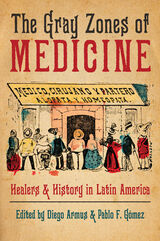 The Gray Zones of Medicine: Healers and History in Latin America
Diego Armus and Pablo F. Gómez
University of Pittsburgh Press, 2021 Winner, 2022 Outstanding Academic Title, CHOICE Awards
Health practitioners working in gray zones, or between official and unofficial medicines, played a fundamental role in shaping Latin America from the colonial period onward. The Gray Zones of Medicine offers a human, relatable, complex examination of the history of health and healing in Latin America across five centuries. Contributors uncover how biographical narratives of individual actors—outside those of hegemonic biomedical knowledge, careers of successful doctors, public health initiatives, and research and medical institutions—can provide a unique window into larger social, cultural, political, and economic historical changes and continuities in the region. They reveal the power of such stories to illuminate intricacies and resilient features of the history of health and disease, and they demonstrate the importance of escaping analytical constraints posed by binary frameworks of legality/illegality, learned/popular, and orthodoxy/heterodoxy when writing about the past. Through an accessible and story-like format, this book unlocks the potential of historical narratives of healings to understand and give nuance to processes too frequently articulated through intellectual medical histories or the lenses of empires, nation-states, and their institutions.
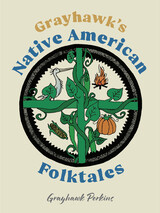 Grayhawk's Native American Folktales
Grayhawk Perkins
University of Alabama Press, 2025 Beloved Houma/Choctaw storyteller Grayhawk Perkins shares age-old wisdom in an unforgettable collection of folktales Grayhawk’s Native American Folktales is the eagerly awaited collection of stories by Grayhawk Perkins, a noted Houma/Choctaw storyteller from Louisiana. Drawing on traditional Indigenous tales, Grayhawk transforms these narratives into stories that captivate contemporary readers and audiences. The collection features universal animal characters such as Deer, Rabbit, Bobcat, Turtle, and Snake that embody a variety of traits. Their adventures and challenges in the natural world reveal human behavior and lessons about how to treat others. Creation stories explain how the world and its inhabitants came to be, including the diligent Crawfish, the origin of skunk stripes, and why opossums are white. Although written for children ages 7 to 12 and their families, all will be charmed by Grayhawk’s contributions to Indigenous literature.
 The Graying of America: An Encyclopedia of Aging, Health, Mind, and Behavior (2d ed.)
Donald H. Kausler and Barry C. Kausler
University of Illinois Press, 2001 This second edition of The Graying of America greatly expands and updates the most comprehensive reference book on aging that is readily accessible to the lay reader.
Featuring nontechnical language, user-friendly indexes, and more than 150 new entries, the second edition covers new topics such as acupuncture, wheelchairs, adjusting to bifocals, preparing for traveling, improving communication with physicians, and avoiding eye strain in computer use. Among other updates are more detailed coverage of health problems including arthritis, diabetes, osteoporosis, and various kinds of cancer, as well as advice on reducing the stress of caring for a family member with Alzheimer's disease. In addition to discussing hundreds of common ailments and conditions, Kausler and Kausler provide constructive guidance on regular physical activity, mental stimulation, and other behaviors that promote "successful aging."
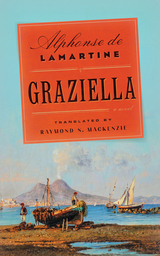 Graziella: A Novel
Alphonse de Lamartine
University of Minnesota Press, 2018 In its first modern translation, a novel-cum-memoir of a Frenchman’s erotic awakening in Italy by a preeminent writer of the Romantic period
In 1812 Alphonse de Lamartine, a young man of means, traveled through southern Italy, where, during a sojourn in Naples, he fell in love with a young woman who worked in a cigar factory—and whose death after he returned to France would haunt him throughout his writing life. Graziella, Lamartine called this lost girl in his poetry and memoirs—and also in Graziella, a novel that closely follows the story of his own romance.
“When I was eighteen,” the narrator begins, as if penning his memoir, “my family entrusted me to the care of a relative whose business affairs called her to Tuscany.” The tale that unfolds, of the young man’s amorous experiences amid the natural grandeur and subtle splendors of the Italian countryside, is one of the finest works of fiction in the French Romantic tradition, a bildungsroman that is also a melancholy portrait of the artist as a young man discovering the muse who would both inspire and elude him. Remarkable for its contemplative prose, its dreamy passions and seductive drawing of the Italian landscape, and its place in the Romantic canon, Graziella is a timeless portrait of love, chronicling the remorse and the misguided ideals of youth that find their expression, if not their amends, in art.
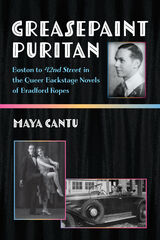 Greasepaint Puritan: Boston to 42nd Street in the Queer Backstage Novels of Bradford Ropes
Maya Cantu
University of Michigan Press, 2024 Greasepaint Puritan details the life and work of Bradford Ropes, author of the bawdy 1932 novel 42nd Street, on which the classic film and its stage adaptation are based. Each of Ropes’s long-forgotten novels was inspired by his own experiences as a performer, and focused on the lives of gay men in show business, offering rare glimpses into backstage Broadway. But why did Ropes’s body of work, and consequently his biographical footsteps, disappear into such obscurity?
Greasepaint Puritan aims to find out and reclaim his story. Descended from Mayflower Pilgrims, Ropes rebelled against the “Proper Bostonian” life, in a career that touched upon the Jazz Age, American vaudeville, and theater censorship. We follow Ropes’s successful career as both a performer and the author of the trilogy of backstage novels: 42nd Street, Stage Mother, and Go Into Your Dance. Populated by scheming stage mothers, precocious stage children, grandiose bit players, and tart-tongued chorines, these novels centered on the lives and relationships of gay men on Broadway during the Jazz Age and Prohibition era. Rigorously researched, Greasepaint Puritan chronicles Ropes’s career as a successful screenwriter in 1930s and ’40s Hollywood, where he continued to be a part of a dynamic gay subculture within the movie industry before returning to obscurity in the 1950s. His legacy lives on in the Hollywood and Broadway incarnations of 42nd Street—but Greasepaint Puritan restores the “forgotten melody” of the man who first envisioned its colorful characters.
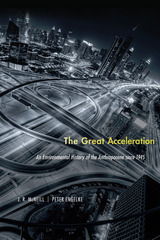 The Great Acceleration: An Environmental History of the Anthropocene since 1945
J. R. McNeill and Peter Engelke
Harvard University Press, 2014 The Earth has entered a new age—the Anthropocene—in which humans are the most powerful influence on global ecology. Since the mid-twentieth century, the accelerating pace of energy use, greenhouse gas emissions, and population growth has thrust the planet into a massive uncontrolled experiment. The Great Acceleration explains its causes and consequences, highlighting the role of energy systems, as well as trends in climate change, urbanization, and environmentalism.
More than any other factor, human dependence on fossil fuels inaugurated the Anthropocene. Before 1700, people used little in the way of fossil fuels, but over the next two hundred years coal became the most important energy source. When oil entered the picture, coal and oil soon accounted for seventy-five percent of human energy use. This allowed far more economic activity and produced a higher standard of living than people had ever known—but it created far more ecological disruption.
We are now living in the Anthropocene. The period from 1945 to the present represents the most anomalous period in the history of humanity’s relationship with the biosphere. Three-quarters of the carbon dioxide humans have contributed to the atmosphere has accumulated since World War II ended, and the number of people on Earth has nearly tripled. So far, humans have dramatically altered the planet’s biogeochemical systems without consciously managing them. If we try to control these systems through geoengineering, we will inaugurate another stage of the Anthropocene. Where it might lead, no one can say for sure.
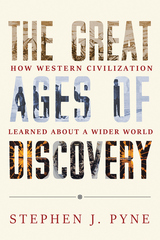 The Great Ages of Discovery: How Western Civilization Learned About a Wider World
Stephen J. Pyne
University of Arizona Press, 2021 For more than 600 years, Western civilization has relied on exploration to learn about a wider world and universe. The Great Ages of Discovery details the different eras of Western exploration in terms of its locations, its intellectual contexts, the characteristic moral conflicts that underwrote encounters, and the grand gestures that distill an age into its essence.
Historian and MacArthur Fellow Stephen J. Pyne identifies three great ages of discovery in his fascinating new book. The first age of discovery ranged from the early 15th to the early 18th century, sketched out the contours of the globe, aligned with the Renaissance, and had for its grandest expression the circumnavigation of the world ocean. The second age launched in the latter half of the 18th century, spanning into the early 20th century, carrying the Enlightenment along with it, pairing especially with settler societies, and had as its prize achievement the crossing of a continent. The third age began after World War II, and, pivoting from Antarctica, pushed into the deep oceans and interplanetary space. Its grand gesture is Voyager’s passage across the solar system. Each age had in common a galvanic rivalry: Spain and Portugal in the first age, Britain and France—followed by others—in the second, and the USSR and USA in the third.
With a deep and passionate knowledge of the history of Western exploration, Pyne takes us on a journey across hundreds of years of geographic trekking. The Great Ages of Discovery is an interpretive companion to what became Western civilization’s quest narrative, with the triumphs and tragedies that grand journey brought, the legacies of which are still very much with us.
The Great American Blow-Up: Puffery in Advertising and Selling
Ivan L. Preston
University of Wisconsin Press, 1996 How does advertising really work? This thoroughly revised edition of Ivan Preston’s popular classic, The Great American Blow-Up, provides new examples of puffery and deceit in advertising. Preston examines in detail the role of laws and the Federal Trade Commission in ensuring fair representation of goods and services to consumers. In a new concluding chapter, Preston describes and assesses developments in the field of advertising from the mid–1970s to the present.
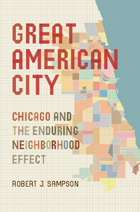 Great American City: Chicago and the Enduring Neighborhood Effect
Robert J. Sampson
University of Chicago Press, 2012 For over fifty years numerous public intellectuals and social theorists have insisted that community is dead. Some would have us believe that we act solely as individuals choosing our own fates regardless of our surroundings, while other theories place us at the mercy of global forces beyond our control. These two perspectives dominate contemporary views of society, but by rejecting the importance of place they are both deeply flawed. Based on one of the most ambitious studies in the history of social science, Great American City argues that communities still matter because life is decisively shaped by where you live. To demonstrate the powerfully enduring impact of place, Robert J. Sampson presents here the fruits of over a decade’s research in Chicago combined with his own unique personal observations about life in the city, from Cabrini Green to Trump Tower and Millennium Park to the Robert Taylor Homes. He discovers that neighborhoods influence a remarkably wide variety of social phenomena, including crime, health, civic engagement, home foreclosures, teen births, altruism, leadership networks, and immigration. Even national crises cannot halt the impact of place, Sampson finds, as he analyzes the consequences of the Great Recession and its aftermath, bringing his magisterial study up to the fall of 2010. Following in the influential tradition of the Chicago School of urban studies but updated for the twenty-first century, Great American City is at once a landmark research project, a commanding argument for a new theory of social life, and the story of an iconic city.
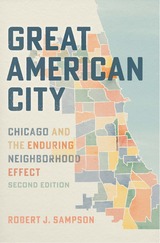 Great American City: Chicago and the Enduring Neighborhood Effect
Robert J. Sampson
University of Chicago Press, 2024 Great American City demonstrates the powerfully enduring impact of place.
Based on one of the most ambitious studies in the history of social science, Robert J. Sampson’s Great American City presents the fruits of over a decade’s research to support an argument that we all feel and experience every day: life is decisively shaped by your neighborhood.
Engaging with the streets and neighborhoods of Chicago, Sampson, in this new edition, reflects on local and national changes that have transpired since his book’s initial publication, including a surge in gun violence and novel forms of segregation despite an increase in diversity. New research, much of it a continuation of the influential discoveries in Great American City, has followed, and here, Sampson reflects on its meaning and future directions. Sampson invites readers to see the status of the research initiative that serves as the foundation of the first edition—the Project on Human Development in Chicago Neighborhoods (PHDCN)—and outlines the various ways other scholars have continued his work. Both accessible and incisively thorough, Great American City is a must-read for anyone interested in cutting-edge urban sociology and the study of crime.
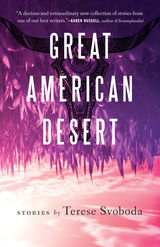 Great American Desert: Stories
Terese Svoboda
Ohio State University Press, 2019 Water, its use and abuse, trickles through Great American Desert, a story collection by Terese Svoboda that spans the misadventures of the prehistoric Clovis people to the wanderings of a forlorn couple around a pink pyramid in a sci-fi prairie. In “Dutch Joe,” the eponymous hero sees the future from the bottom of a well in the Sandhills, while a woman tries to drag her sister back from insanity in “Dirty Thirties.” In “Bomb Jockey,” a local Romeo disposes of leaky bombs at South Dakota’s army depot, while a family quarrels in “Ogallala Aquifer” as a thousand trucks dump chemical waste from a munitions depot next to their land. Bugs and drugs are devoured in “Alfalfa,” a disc jockey talks her way out of a knifing in “Sally Rides,” and an updated Pied Piper begs parents to reconsider in “The Mountain.” The consequences of the land’s mistreatment is epitomized in the final story by a discovery inside a pink pyramid.
In her arresting and inimitable style, Svoboda’s delicate handling of the complex dynamics of family and self seeps into every sentence of these first-rate short stories about what we do to the world around us—and what it can do to us.
 The Great American Housing Bubble: What Went Wrong and How We Can Protect Ourselves in the Future
Adam J. Levitin and Susan M. Wachter
Harvard University Press, 2020 The definitive account of the housing bubble that caused the Great Recession—and earned Wall Street fantastic profits.
The American housing bubble of the 2000s caused the worst global financial crisis since the Great Depression. In this definitive account, Adam Levitin and Susan Wachter pinpoint its source: the shift in mortgage financing from securitization by Fannie Mae and Freddie Mac to “private-label securitization” by Wall Street banks. This change set off a race to the bottom in mortgage underwriting standards, as banks competed in laxity to gain market share.
The Great American Housing Bubble tells the story of the transformation of mortgage lending from a dysfunctional, local affair, featuring short-term, interest-only “bullet” loans, to a robust, national market based around the thirty-year fixed-rate mortgage, a uniquely American innovation that served as the foundation for the middle class.
Levitin and Wachter show how Fannie and Freddie’s market power kept risk in check until 2003, when mortgage financing shifted sharply to private-label securitization, as lenders looked for a way to sustain lending volume following an unprecedented refinancing wave. Private-label securitization brought a return of bullet loans, which had lower initial payments—enabling borrowers to borrow more—but much greater back-loaded risks. These loans produced a vast oversupply of underpriced mortgage finance that drove up home prices unsustainably. When the bubble burst, it set off a destructive downward spiral of home prices and foreclosures.
Levitin and Wachter propose a rebuild of the housing finance system that ensures the widespread availability of the thirty-year fixed-rate mortgage, while preventing underwriting competition and shifting risk away from the public to private investors.
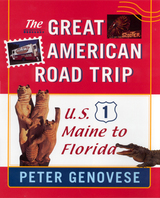 The Great American Road Trip: U.S. 1, Maine to Florida
Genovese, Peter
Rutgers University Press, 1999 Take an unforgettable road trip down one of America’s most fascinating highways, U.S. On what highway can you find the headquarters of the FBI, Dow Jones Interactive, and the National Enquirer? What road is home to the Bronx Zoo, the Okefenokee Swamp, and Flipper? On the side of what freeway can you find the Super Duper Weenie Wagon, Larry’s Redneck Bar, and the Big Chicken Barn? Peter Genovese found them all, along with about a million other fascinating and bizarre attractions, on U.S. 1, ‘the best damn highway in America,” as he calls it. Join him for the road trip of a lifetime The Great American Road Trip: A Journey Down U.S. 1. U.S. 1 may not be America’s scenic highway, but it’s certainly the most colorful. It runs through Boston, New York, Baltimore, Washington, D.C., and Miami, in addition to Caribou, Maine, Quonochontaug, Rhode Island, and Alma, Georgia. It zig-zags along the wild and beautiful Maine coast and soars over the Atlantic Ocean as the Overseas Highway, one of the most spectacular stretches of road anywhere. The Star-Spangled Banner is on U.S. 1. Madonna lived on U.S. 1 (until she sold her house to Rosie O'Donnell). U.S. 1 is Main Street and the Miracle Mile, two-lane blacktop and six-lane expressway, straight as an arrow in some places and twistier than a Philadelphia soft pretzel in others. Genovese spent two years on U.S. 1, talking to everyone from doughnut makers, dolphin trainers, and swamp guides to real Miami vice cops and the keeper of the national parasite collection. His resulting book is the most complete portrait of an American highway ever written. With his unerring eye for detail, sense of humor, and understanding of human nature, Genovese takes readers on a sometimes funny, sometimes sad, always illuminating 2,450-mile journey from Fort Kent, Maine to Key West, Florida. Ride along with Genovese and grab a drink at the Last Resort Bar or the Last Chance Saloon, then pick up a paperback at the Banned Bookstore. Visit Oscar, the biggest gator in the Okefenokee Swamp, have dinner at Hog Heaven, and take in a Portland Seadogs baseball game. Tour a Budweiser brewery and go into the pit at a NASCAR race. Looking for someplace to stay? How about the world’s only underwater hotel, the Jules’ Undersea Lodge, or in a cabin made entirely from one pine tree at the Maine Idyll Motor Court? If it’s culture you seek, the highway boasts dozens of museums. While you may have heard of the Museum of Natural History and the National Museum of American Art, how about the Blacks in Wax Museum, Tragedy in the United States Museum, and the Mushroom Museum? There’s something for everyone on U.S. 1, and Genovese has written about it all in The Great American Road Trip.
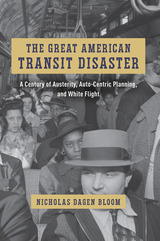 The Great American Transit Disaster: A Century of Austerity, Auto-Centric Planning, and White Flight
Nicholas Dagen Bloom
University of Chicago Press, 2023 A potent re-examination of America’s history of public disinvestment in mass transit.
Many a scholar and policy analyst has lamented American dependence on cars and the corresponding lack of federal investment in public transportation throughout the latter decades of the twentieth century. But as Nicholas Dagen Bloom shows in The Great American Transit Disaster, our transit networks are so bad for a very simple reason: we wanted it this way.
Focusing on Baltimore, Atlanta, Chicago, Detroit, Boston, and San Francisco, Bloom provides overwhelming evidence that transit disinvestment was a choice rather than destiny. He pinpoints three major factors that led to the decline of public transit in the United States: municipal austerity policies that denied most transit agencies the funding to sustain high-quality service; the encouragement of auto-centric planning; and white flight from dense city centers to far-flung suburbs. As Bloom makes clear, these local public policy decisions were not the product of a nefarious auto industry or any other grand conspiracy—all were widely supported by voters, who effectively shut out options for transit-friendly futures. With this book, Bloom seeks not only to dispel our accepted transit myths but hopefully to lay new tracks for today’s conversations about public transportation funding.
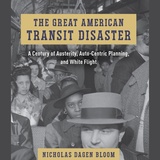 The Great American Transit Disaster: A Century of Austerity, Auto-Centric Planning, and White Flight
Nicholas Dagen Bloom
University of Chicago Press, 2023 This is an auto-narrated audiobook edition of this book.
A potent re-examination of America’s history of public disinvestment in mass transit.
Many a scholar and policy analyst has lamented American dependence on cars and the corresponding lack of federal investment in public transportation throughout the latter decades of the twentieth century. But as Nicholas Dagen Bloom shows in The Great American Transit Disaster, our transit networks are so bad for a very simple reason: we wanted it this way.
Focusing on Baltimore, Atlanta, Chicago, Detroit, Boston, and San Francisco, Bloom provides overwhelming evidence that transit disinvestment was a choice rather than destiny. He pinpoints three major factors that led to the decline of public transit in the United States: municipal austerity policies that denied most transit agencies the funding to sustain high-quality service; the encouragement of auto-centric planning; and white flight from dense city centers to far-flung suburbs. As Bloom makes clear, these local public policy decisions were not the product of a nefarious auto industry or any other grand conspiracy—all were widely supported by voters, who effectively shut out options for transit-friendly futures. With this book, Bloom seeks not only to dispel our accepted transit myths but hopefully to lay new tracks for today’s conversations about public transportation funding.
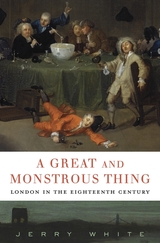 A Great and Monstrous Thing: London in the Eighteenth Century
Jerry White
Harvard University Press, 2013 London in the eighteenth century was a new city, risen from the ashes of the Great Fire of 1666 that had destroyed half its homes and great public buildings. The century that followed was an era of vigorous expansion and large-scale projects, of rapidly changing culture and commerce, as huge numbers of people arrived in the shining city, drawn by its immense wealth and power and its many diversions. Borrowing a phrase from Daniel Defoe, Jerry White calls London “this great and monstrous thing,” the grandeur of its new buildings and the glitter of its high life shadowed by poverty and squalor.
A Great and Monstrous Thing offers a street-level view of the city: its public gardens and prisons, its banks and brothels, its workshops and warehouses—and its bustling, jostling crowds. White introduces us to shopkeepers and prostitutes, men and women of fashion and genius, street-robbers and thief-takers, as they play out the astonishing drama of life in eighteenth-century London. What emerges is a picture of a society fractured by geography, politics, religion, history—and especially by class, for the divide between rich and poor in London was never greater or more destructive in the modern era than in these years.
Despite this gulf, Jerry White shows us Londoners going about their business as bankers or beggars, reveling in an enlarging world of public pleasures, indulging in crimes both great and small—amidst the tightening sinews of power and regulation, and the hesitant beginnings of London democracy.
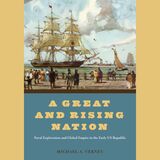 A Great and Rising Nation: Naval Exploration and Global Empire in the Early US Republic
Michael A. Verney
University of Chicago Press, 2022 This is an auto-narrated audiobook version of this book.
A Great and Rising Nation illuminates the unexplored early decades of the United States’ imperialist naval aspirations.
Conventional wisdom holds that, until the Spanish-American War of 1898, the United States was a feeble player on the world stage, with an international presence rooted in commerce rather than military might. Michael A. Verney’s A Great and Rising Nation flips this notion on its head, arguing that early US naval expeditions, often characterized as merely scientific, were in fact deeply imperialist. Circling the globe from the Mediterranean to South America and the Arctic, these voyages reflected the diverse imperial aspirations of the new republic, including commercial dominance in the Pacific World, religious empire in the Holy Land, proslavery expansion in South America, and diplomatic prestige in Europe. As Verney makes clear, the United States had global imperial aspirations far earlier than is commonly thought.
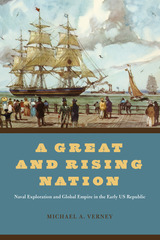 A Great and Rising Nation: Naval Exploration and Global Empire in the Early US Republic
Michael A. Verney
University of Chicago Press, 2022 A Great and Rising Nation illuminates the unexplored early decades of the United States’ imperialist naval aspirations.
Conventional wisdom holds that, until the Spanish-American War of 1898, the United States was a feeble player on the world stage, with an international presence rooted in commerce rather than military might. Michael A. Verney’s A Great and Rising Nation flips this notion on its head, arguing that early US naval expeditions, often characterized as merely scientific, were in fact deeply imperialist. Circling the globe from the Mediterranean to South America and the Arctic, these voyages reflected the diverse imperial aspirations of the new republic, including commercial dominance in the Pacific World, religious empire in the Holy Land, proslavery expansion in South America, and diplomatic prestige in Europe. As Verney makes clear, the United States had global imperial aspirations far earlier than is commonly thought.
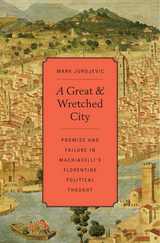 A Great and Wretched City: Promise and Failure in Machiavelli’s Florentine Political Thought
Mark Jurdjevic
Harvard University Press, 2014 Like many inhabitants of booming metropolises, Machiavelli alternated between love and hate for his native city. He often wrote scathing remarks about Florentine political myopia, corruption, and servitude, but also wrote about Florence with pride, patriotism, and confident hope of better times. Despite the alternating tones of sarcasm and despair he used to describe Florentine affairs, Machiavelli provided a stubbornly persistent sense that his city had all the materials and potential necessary for a wholesale, triumphant, and epochal political renewal. As he memorably put it, Florence was "truly a great and wretched city."
Mark Jurdjevic focuses on the Florentine dimension of Machiavelli's political thought, revealing new aspects of his republican convictions. Through The Prince, Discourses, correspondence, and, most substantially, Florentine Histories, Jurdjevic examines Machiavelli's political career and relationships to the republic and the Medici. He shows that significant and as yet unrecognized aspects of Machiavelli's political thought were distinctly Florentine in inspiration, content, and purpose. From a new perspective and armed with new arguments, A Great and Wretched City reengages the venerable debate about Machiavelli's relationship to Renaissance republicanism. Dispelling the myth that Florentine politics offered Machiavelli only negative lessons, Jurdjevic argues that his contempt for the city's shortcomings was a direct function of his considerable estimation of its unrealized political potential.
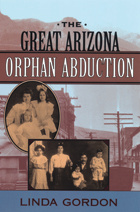 The Great Arizona Orphan Abduction
Linda Gordon
Harvard University Press, 1999 In 1904, New York nuns brought forty Irish orphans to a remote Arizona mining camp, to be placed with Catholic families. The Catholic families were Mexican, as was the majority of the population. Soon the town's Anglos, furious at this "interracial" transgression, formed a vigilante squad that kidnapped the children and nearly lynched the nuns and the local priest. The Catholic Church sued to get its wards back, but all the courts, including the U.S. Supreme Court, ruled in favor of the vigilantes.
The Great Arizona Orphan Abduction tells this disturbing and dramatic tale to illuminate the creation of racial boundaries along the Mexican border. Clifton/Morenci, Arizona, was a "wild West" boomtown, where the mines and smelters pulled in thousands of Mexican immigrant workers. Racial walls hardened as the mines became big business and whiteness became a marker of superiority. These already volatile race and class relations produced passions that erupted in the "orphan incident." To the Anglos of Clifton/Morenci, placing a white child with a Mexican family was tantamount to child abuse, and they saw their kidnapping as a rescue.
Women initiated both sides of this confrontation. Mexican women agreed to take in these orphans, both serving their church and asserting a maternal prerogative; Anglo women believed they had to "save" the orphans, and they organized a vigilante squad to do it. In retelling this nearly forgotten piece of American history, Linda Gordon brilliantly recreates and dissects the tangled intersection of family and racial values, in a gripping story that resonates with today's conflicts over the "best interests of the child."
The Great Art Hoax: Essays in the Comedy and Insanity of Collectible Art
Jon Huer
University of Wisconsin Press, 1990 The Great Art Hoax exposes the real fakery and hypocrisy of the art world: how art is manufactured and marketed; how the pathology of private possession drives up the price; and how false art is hyped as true art to the tune of millions of dollars. Jon Huer demonstrates convincingly that what the art market deals as art need not be “art” at all.
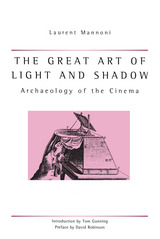 The Great Art Of Light And Shadow: Archaeology of the Cinema
Laurent Mannoni
University of Exeter Press, 2000
Widely regarded by historians of the early moving picture as the best work yet published on pre-cinema, The Great Art of Light and Shadow: Archaeology of the Cinema throws light on a fascinating range of optical media from the twelfth century to the turn of the twentieth. First published in French in 1994 and now translated into English, Laurent Mannoni's account projects a broad picture of the subject area now known as 'pre-cinema'.
Starting from the earliest uses of the camera obscura in astronomy and entertainment, Mannoni discusses, among many other devices, the invention and early years of the magic lantern in the seventeenth century, the peepshows and perspective views of the eighteenth century, and the many weird and wonderful nineteenth-century attempts to recreate visions of real life in different ways and forms. This fully-illustrated and accessible account of a strange mixture of science, magic, art and deception introduces to an English-speaking readership many aspects of pre-cinema history from other European countries.
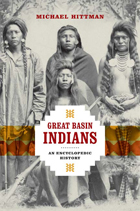 Great Basin Indians: An Encyclopedic History
Michael Hittman
University of Nevada Press, 2024 The Native American inhabitants of North America’s Great Basin have a long, eventful history and rich cultures. Great Basin Indians: An Encyclopedic History covers all aspects of their world. The book is organized in an encyclopedic format to allow full discussion of many diverse topics, including geography, religion, significant individuals, the impact of Euro-American settlement, wars, tribes and intertribal relations, reservations, federal policies regarding Native Americans, scholarly theories regarding their prehistory, and others. Author Michael Hittman employs a vast range of archival and secondary sources as well as interviews, and he addresses the fruits of such recent methodologies as DNA analysis and gender studies that offer new insights into the lives and history of these enduring inhabitants of one of North America’s most challenging environments.
Great Basin Indians is an essential resource for any reader interested in the Native peoples of the American West and in western history in general.
Great Basin Kingdom: An Economic History of the Latter-day Saints, 1830-1900, New Edition
Leonard J. Arrington
University of Illinois Press, 2004 Leonard Arrington, who died in 1999, is considered by most, if not all, serious scholars of Mormon and western history as the single most important figure to write on LDS history. Great Basin Kingdom is perhaps his greatest work. A classic in Mormon studies and western history, Great Basin Kingdom offers insights into the ‘underdeveloped' American economy, a comprehensive treatment of one of the few native American religious movements, and detailed, exciting stories from little-known phases of Mormon and American history. This edition includes thirty new photographs and an introduction by Ronald W. Walker that provides a brief biography of Arrington, as well as the history of the work, its place in Mormon and western historiography, and its lasting impact.
 A Great Basin Mosaic: The Cultures of Rural Nevada
James W. Hulse
University of Nevada Press, 2017 The Nevada of lesser-known cities, towns, and outposts deserve their separate chronicles, and here Hulse fills a wide gap. He contributes in a text rich with memories tramping through rural Nevada as a child, then as a journalist seeking news and gossip, then later as an academic historian and a parent trying to share the wonders of the high desert with his family. Nobody is more qualified to write about the cultural nuances of rural Nevada than Hulse, who retired after 35 years as a professor of history at University of Nevada, Reno. Robert Laxalt wrote an article in National Geographic in 1974 entitled “The Other Nevada” in which he referred to “the Nevada that has been eclipsed by the tinsel trimmings of Las Vegas, the round-the-clock casinos, the ski slopes of the Sierra. It is a Nevada that few tourists see.” With this book Hulse reflects on Laxalt’s insights and shows changes—often slow-moving and incremental—that have occurred since then. Much of the terrain of rural Nevada has not changed at all, while others have adapted to technological revolutions of recent times. Hulse states that there is no single “other” Nevada, but several subcultures with distinct features. He offers a tour of sorts to what John Muir called the “bewildering abundance” of the Nevada landscape.
Great Basin National Park: A Guide to the Park and Surrounding Area
Gretchen M. Baker
Utah State University Press, 2012 Great Basin National Park is in large part a high-alpine park, but it sits in one of America’s driest, least populated, and most isolated deserts. That contrast is one facet of the diversity that characterizes this region. Within and outside the park are phenomenal landscape features, biotic wonders, unique environments, varied historic sites, and the local colors of isolated towns and ranches. Vast Snake and Spring Valleys, bracketing the national park, are also subjects of one of the West's most divisive environment contests, over what on the surface seems most absent but underground is abundant enough for sprawling Las Vegas to covet it—water.
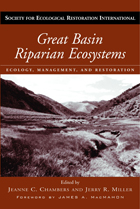 Great Basin Riparian Ecosystems: Ecology, Management, and Restoration
Edited by Jeanne C. Chambers and Jerry R. Miller; Foreword by James A. MacMahon; Society for Ecological Restoration International
Island Press, 2004 Established by the USDA Forest Service in 1993, the Great Basin Ecosystem Management Project for Restoring and Maintaining Sustainable Riparian Ecosystems is a large-scale research study that uses an interdisciplinary approach to examine the effects of climate change and human disturbance on riparian areas. Structured as a collaborative effort between management and research, the project focuses on understanding the geomorphic, hydrologic, and biotic processes that underlie riparian structure and function and the interrelated responses of those processes to disturbances, both natural and anthropogenic. Great Basin Riparian Ecosystems, edited by Jeanne C. Chambers and Jerry R. Miller, presents the approach used by the researchers to study and understand riparian areas in the Great Basin region. It summarizes the current state of knowledge about those areas and provides insights into the use of the information generated by the project for the restor-ation and management of riparian ecosystems. Because semi-arid ecosystems like the Great Basin are highly sensitive to climate change, the study considered how key processes are affected by past and present climate. Great Basin Riparian Ecosystems also examines the processes over a continuum of temporal and spatial scales. Great Basin Riparian Ecosystems addresses restoration over a variety of scales and integrates work from multiple disciplines, including riparian ecology, paleoecology, geomorphology, and hydrology. While the focus is on the Great Basin, the general approach is widely applicable, as it describes a promising new strategy for developing restoration and management plans, one based on sound principles derived from attention to natural systems.
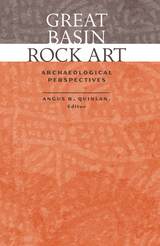 Great Basin Rock Art: Archaeological Perspectives
Angus R. Quinlan
University of Nevada Press, 2007 Rock art is one of humankind’s most ancient forms of artistic expression, and one of its most enigmatic. For centuries, scholars and other observers have struggled to interpret the meaning of the mysterious figures incised or painted on natural rocks and to understand their role in the lives of their long-vanished creators. The Great Basin of the American West is especially rich in rock art, but until recently North American archaeologists have largely ignored these most visible monuments left by early Native Americans and have given little attention to the terrain surrounding them. In Great Basin Rock Art, twelve respected rock art researchers examine a number of significant sites from the dual perspectives of settlement archaeology and contemporary Native American interpretations of the role of rock art in their cultural past. The authors demonstrate how modern archaeological methodology and interpretations are providing a rich physical and cultural context for these ancient and hitherto puzzling artifacts. They offer exciting new insights into the lives of North America’s first inhabitants. This is essential reading for anyone interested in the petroglyphs of the American West and in the history of the Great Basin and its original peoples.
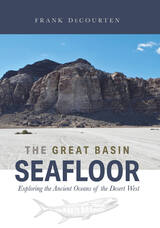 The Great Basin Seafloor: Exploring the Ancient Oceans of the Desert West
Frank DeCourten
University of Utah Press, 2022 Many people appreciate the stunning vistas of the Great Basin desert; understanding the region’s geological past can provide a deeper way to know and admire this landscape. In The Great Basin Seafloor, Frank DeCourten immerses readers in a time when the Basin was covered by a vast ocean in which volcanoes exploded and sea life flourished.
Written for a nontechnical audience, this book interprets the rock record left by more than 500 million years of oceanic activity, when mud and sand accumulated and solidified to produce today’s Great Basin across parts of modern Utah, Nevada, and California. DeCourten deciphers clues within exposed slopes and canyons to reconstruct the vanished seafloor and its volcanic events and examines fossils to reveal once-thriving ancient marine communities. Supplemental material is available online to serve as a field guide for readers wishing to explore this ancient ocean themselves as they travel through the region.
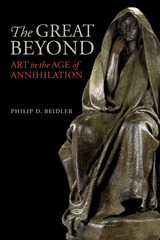 The Great Beyond: Art in the Age of Annihilation
Philip D. Beidler
University of Alabama Press, 2022 Essays from a master critic on how artistic giants from modernism onward confronted mortality—forging unexpected links between Twain, Woolf, Mahler, Wittgenstein, Beckett, Toni Morrison, and more
While much about modernism remains up for debate, there can be no dispute about the connection between modernist art and death. The long modern moment was and is an age of war, genocide, and annihilation. Two world wars killed perhaps as many as 100 million people, through combat, famine, holocaust, and ghastly attacks on civilians. The ongoing COVID-19 pandemic is the fifth global pandemic since 1918, with more than a half-million American deaths and counting.
It can hardly come as a surprise, then, that many of the touchstones of modernism reflect on death and devastation. In Philip D. Beidler’s exploration of the modernist canon, he illuminates how these singular voices looked extinction in the eye and tried to reckon with our finitude—and their own. The Great Beyond:Art in the Age of Annihilation catalogs through lively prose an eclectic selection of artists, writers, and thinkers. In 16 essays, Beidler takes nuanced and surprising approaches to well-studied figures—the haunting sculpture by Saint-Gaudens commissioned by Henry Adams for his late wife; Luchino Visconti’s adaptation of Mann’s Death in Venice; and the author’s own long fascination with Beckett’s Waiting for Godot.
The threads and recurring motifs that emerge through Beidler’s analysis bridge the different media, genres, and timeframes of the works under consideration. Protomodernists Crane and Twain connect with near-contemporary voices like Sebald and Morrison. Robert MacFarlane’s 21st-century nonfiction about what lies underneath the earth echoes the Furerbunker and the poetry of Gertrud Kolmar. Learned but lively, somber but not grim, The Great Beyond is not a comfortable read, but it is in a way comforting. In tracing how his subjects confronted nothingness, be it personal or global, Beidler draws a brilliant map of how we see the end of the road.
 A Great Big Girl Like Me: The Films of Marie Dressler
Victoria Sturtevant
University of Illinois Press, 2008 In this study of Marie Dressler, MGM's most profitable movie star in the early 1930s, Victoria Sturtevant analyzes Dressler's use of her body to challenge Hollywood's standards for leading ladies. At five feet seven inches tall and two hundred pounds, Dressler was never considered the popular "delicate beauty," often playing ugly ducklings, old maids, doting mothers, and imperious dowagers. However, Dressler's body, her fearless physicality, and her athletic slapstick routines commanded the screen. Although an unlikely movie star, Dressler represented for Depression-era audiences a sign of abundance and generosity in a time of scarcity. This premier analysis of her body of work explores how Dressler refocused the generic frame of her films beyond the shallow problems of the rich and beautiful, instead dignifying the marginalized, the elderly, women, and the poor. Sturtevant inteprets the meanings of Dressler's body through different genres, venues, and historical periods by looking at her vaudeville career, her transgressive representation of an "unruly" yet sexual body in Emma and Christopher Bean, ideas of the body politic in the films Politics and Prosperity, and Dressler as a mythic body in Min and Bill and Tugboat Annie.
GREAT BIRD OF LOVE: POEMS
Paul Zimmer
University of Illinois Press, 1989
"The Great Bird of Love brims with a life so intense that it
must be told quietly. The pages are quirky, full of surprise, variety,
humor, and the sustaining reliable voice of a worthy guide to experience.
These poems come from perception informed by sympathy, and the language
is alive with verbal adventure."
-- William Stafford
A book in the National Poetry Series
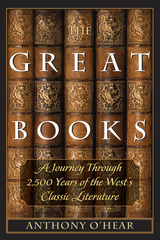 The Great Books: A Journey through 2,500 Years of the West’s Classic Literature
Anthony O'Hear
Intercollegiate Studies Institute, 2009
Anyone Can Read the Great Books . . . with a Little Help
“An illuminating, learned, well-written, and entertaining survey of the giants of world literature. Busy people, and especially the young, will be grateful for this useful and concise introduction.” —Paul Johnson
Not simply a grand work of reference, The Great Books is a captivating journey through two-and-a-half millennia of the great Western tradition.
The eminent British philosopher Anthony O’Hear is our capable tour guide, taking readers on an exhilarating tour through 2,500 years of books as powerful, thrilling, erotic, politically astute, and awe-inspiring as any modern bestseller.
The Great Booksis a fascinating narrative that encompasses history, myth, art, music, theater, and more. O’Hear sweeps us along from Homer’s Iliad to Goethe’s Faust, covering much ground in between. In Homer’s poems of epic struggle we discover not only the fascination and pleasure we can derive, but also why these works became the fountainhead of Western literature. From Greek tragedy we feel the power of the ancient myths, while from Plato’s Death of Socrates we see what may have killed off the tragic spirit. In Virgil’s Aeneid we ponder the close connections to—and puzzling contrasts with—Homer; in Dante’s terrifying and sublime Divine Comedy we encounter Virgil once again, this time as mentor and guide through Hell; and in Milton’s phantasmagoric Paradise Lost we find the Christian story given epic shape and power. And of course, in Shakespeare we experience the great dramatist’s particular and incomparable genius.
There is much more beyond—from Ovid and Augustine to Chaucer and Cervantes, Pascal and Racine. The Great Books is a spirited and enlightening guide to the great works of the Western tradition, shot through with a love of literature and the author’s deeply held belief in its power to enrich and enliven everyone’s world.
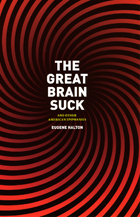 The Great Brain Suck: And Other American Epiphanies
Eugene Halton
University of Chicago Press, 2008 More and more information is pumped into our media-saturated world every day, yet Americans seem to know less and less. In a society where who you are is defined by what you buy, and where we prefer to experience reality by watching it on TV, Eugene Halton argues something has clearly gone wrong.
Luckily Halton, with scalpel-sharp wit in one hand and the balm of wisdom in the other, is here to operate on the declining body politic. His initial diagnosis is bleak: fast food and too much time spent sitting, whether in our cars or on our couches, are ruining our bodies, while our minds are weakened by the proliferation of electronic devices—TVs, computers, cell phones, iPods, video games—and their alienating effects. If we are losing the battle between autonomy and automation, he asks, how can our culture regain self-sufficiency? Halton finds the answer in the inspiring visions—deeply rooted in American culture—of an organic and more spontaneous life at the heart of the work of master craftsman Wharton Esherick, legendary blues singer Muddy Waters, urban critic Lewis Mumford, and artist Maya Lin, among others.
A scathing and original jeremiad against modern materialism, The Great Brain Suck is also a series of epiphanies of a simpler but more profound life.
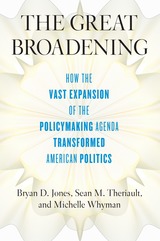 The Great Broadening: How the Vast Expansion of the Policymaking Agenda Transformed American Politics
Bryan D. Jones, Sean M. Theriault, and Michelle Whyman
University of Chicago Press, 2019 Beginning in the late 1950s and continuing through the 1970s, the United States experienced a vast expansion in national policy making. During this period, the federal government extended its scope into policy arenas previously left to civil society or state and local governments.
With The Great Broadening, Bryan D. Jones, Sean M. Theriault, and Michelle Whyman examine in detail the causes, internal dynamics, and consequences of this extended burst of activity. They argue that the broadening of government responsibilities into new policy areas such as health care, civil rights, and gender issues and the increasing depth of existing government programs explain many of the changes in America politics since the 1970s. Increasing government attention to particular issues was motivated by activist groups. In turn, the beneficiaries of the government policies that resulted became supporters of the government’s activity, leading to the broad acceptance of its role. This broadening and deepening of government, however, produced a reaction as groups critical of its activities organized to resist and roll back its growth.
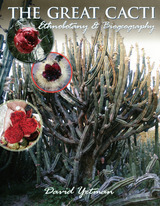 The Great Cacti: Ethnobotany and Biogeography
David Yetman
University of Arizona Press, 2007 Towering over deserts, arid scrublands, and dry tropical forests, giant cacti grow throughout the Americas, from the United States to Argentina—often in rough terrain and on barren, parched soils, places inhospitable to people. But as David Yetman shows, many of these tall plants have contributed significantly to human survival.
Yetman has been fascinated by columnar cacti for most of his life and now brings years of study and reflection to a wide-ranging and handsomely illustrated book. Drawing on his close association with the Guarijíos, Mayos, and Seris of Mexico—peoples for whom such cacti have been indispensable to survival—he offers surprising evidence of the importance of these plants in human cultures. The Great Cacti reviews the more than one hundred species of columnar cacti, with detailed discussions of some 75 that have been the most beneficial to humans or are most spectacular. Focusing particularly on northwestern Mexico and the southwestern United States, Yetman examines the role of each species in human society, describing how cacti have provided food, shelter, medicine, even religiously significant hallucinogens.
Taking readers to the exotic sites where these cacti are found—from sea-level deserts to frigid Andean heights—Yetman shows that the great cacti have facilitated the development of native culture in hostile environments, yielding their products with no tending necessary. Enhanced by over 300 superb color photos, The Great Cacti is both a personal and scientific overview of sahuesos, soberbios, and other towering flora that flourish where few other plants grow—and that foster human life in otherwise impossible places.
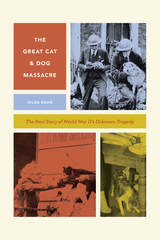 The Great Cat and Dog Massacre: The Real Story of World War Two's Unknown Tragedy
Hilda Kean
University of Chicago Press, 2017 The tragedies of World War II are well known. But at least one has been forgotten: in September 1939, four hundred thousand cats and dogs were massacred in Britain. The government, vets, and animal charities all advised against this killing. So why would thousands of British citizens line up to voluntarily euthanize household pets?
In The Great Cat and Dog Massacre, Hilda Kean unearths the history, piecing together the compelling story of the life—and death—of Britain’s wartime animal companions. She explains that fear of imminent Nazi bombing and the desire to do something to prepare for war led Britons to sew blackout curtains, dig up flower beds for vegetable patches, send their children away to the countryside—and kill the family pet, in theory sparing them the suffering of a bombing raid. Kean’s narrative is gripping, unfolding through stories of shared experiences of bombing, food restrictions, sheltering, and mutual support. Soon pets became key to the war effort, providing emotional assistance and helping people to survive—a contribution for which the animals gained government recognition.
Drawing extensively on new research from animal charities, state archives, diaries, and family stories, Kean does more than tell a virtually forgotten story. She complicates our understanding of World War II as a “good war” fought by a nation of “good” people. Accessibly written and generously illustrated, Kean’s account of this forgotten aspect of British history moves animals to center stage—forcing us to rethink our assumptions about ourselves and the animals with whom we share our homes.
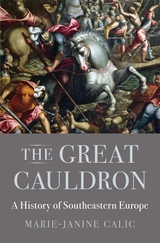 The Great Cauldron: A History of Southeastern Europe
Marie-Janine Calic
Harvard University Press, 2019 A sweeping history of southeastern Europe from antiquity to the present that reveals it to be a vibrant crossroads of trade, ideas, and religions.
We often think of the Balkans as a region beset by turmoil and backwardness, but from late antiquity to the present it has been a dynamic meeting place of cultures and religions. Combining deep insight with narrative flair, The Great Cauldron invites us to reconsider the history of this intriguing, diverse region as essential to the story of global Europe.
Marie-Janine Calic reveals the many ways in which southeastern Europe’s position at the crossroads of East and West shaped continental and global developments. The nascent merchant capitalism of the Mediterranean world helped the Balkan knights fight the Ottomans in the fifteenth century. The deep pull of nationalism led a young Serbian bookworm to spark the conflagration of World War I. The late twentieth century saw political Islam spread like wildfire in a region where Christians and Muslims had long lived side by side. Along with vivid snapshots of revealing moments in time, including Krujë in 1450 and Sarajevo in 1984, Calic introduces fascinating figures rarely found in standard European histories. We meet the Greek merchant and poet Rhigas Velestinlis, whose revolutionary pamphlet called for a general uprising against Ottoman tyranny in 1797. And the Croatian bishop Ivan Dominik Stratiko, who argued passionately for equality of the sexes and whose success with women astonished even his friend Casanova.
Calic’s ambitious reappraisal expands and deepens our understanding of the ever-changing mixture of peoples, faiths, and civilizations in this much-neglected nexus of empire.
The Great Chain of Being: A Study of the History of an Idea
Arthur O. Lovejoy
Harvard University Press, 1963 From later antiquity down to the close of the eighteenth century, most philosophers and men of science and, indeed, most educated men, accepted without question a traditional view of the plan and structure of the world.In this volume, which embodies the William James lectures for 1933, Arthur O. Lovejoy points out the three principles—plenitude, continuity, and graduation—which were combined in this conception; analyzes their origins in the philosophies of Plato, Aristotle, and the Neoplatonists; traces the most important of their diverse samifications in subsequent religious thought, in metaphysics, in ethics and aesthetics, and in astronomical and biological theories; and copiously illustrates the influence of the conception as a whole, and of the ideas out of which it was compounded, upon the imagination and feelings as expressed in literature.
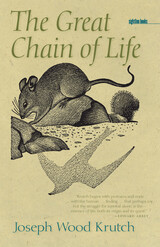 The Great Chain of Life
Krutch, Joseph Wood
University of Iowa Press, 1956 Originally published in 1956, The Great Chain of Life brings a humanist’s keen eye and ear to one of the great questions of the ages: “What am I?” Originally a scholar of literature and theater, toward the end of his career Joseph Wood Krutch turned to the study of the natural world. Bringing his keen intellect to bear on the places around him, Krutch crafted some of the most memorable and important works of nature writing extant.
Whether anticipating the arguments of biologists who now ascribe high levels of cognition to the so-called lower animals, recognizing the importance of nature for a well-lived life, or seeing nature as an elaborately interconnected, interdependent network, Krutch’s seminal work contains lessons just as resonant today as they were when the book was first written.
Lavishly illustrated with thirteen beautiful woodcuts by Paul Landacre, an all-but-lost yet important Los Angeles artist whom Rockwell Kent called “the best American wood engraver working,” The Great Chain of Life will be cherished by new generations of readers.
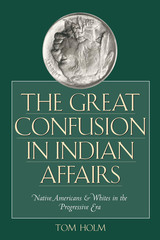 The Great Confusion in Indian Affairs: Native Americans and Whites in the Progressive Era
By Tom Holm
University of Texas Press, 2005 The United States government thought it could make Indians "vanish." After the Indian Wars ended in the 1880s, the government gave allotments of land to individual Native Americans in order to turn them into farmers and sent their children to boarding schools for indoctrination into the English language, Christianity, and the ways of white people. Federal officials believed that these policies would assimilate Native Americans into white society within a generation or two. But even after decades of governmental efforts to obliterate Indian culture, Native Americans refused to vanish into the mainstream, and tribal identities remained intact. This revisionist history reveals how Native Americans' sense of identity and "peoplehood" helped them resist and eventually defeat the U.S. government's attempts to assimilate them into white society during the Progressive Era (1890s-1920s). Tom Holm discusses how Native Americans, though effectively colonial subjects without political power, nonetheless maintained their group identity through their native languages, religious practices, works of art, and sense of homeland and sacred history. He also describes how Euro-Americans became increasingly fascinated by and supportive of Native American culture, spirituality, and environmental consciousness. In the face of such Native resiliency and non-Native advocacy, the government's assimilation policy became irrelevant and inevitably collapsed. The great confusion in Indian affairs during the Progressive Era, Holm concludes, ultimately paved the way for Native American tribes to be recognized as nations with certain sovereign rights.
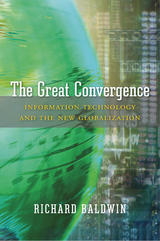 The Great Convergence: Information Technology and the New Globalization
Richard Baldwin
Harvard University Press, 2016 An Economist Best Book of the Year
A Financial Times Best Economics Book of the Year
A Fast Company “7 Books Microsoft CEO Satya Nadella Says You Need to Lead Smarter”
Between 1820 and 1990, the share of world income going to today’s wealthy nations soared from twenty percent to almost seventy. Since then, that share has plummeted to where it was in 1900. As the renowned economist Richard Baldwin reveals, this reversal of fortune reflects a new age of globalization that is drastically different from the old. The nature of globalization has changed, but our thinking about it has not.
Baldwin argues that the New Globalization is driven by knowledge crossing borders, not just goods. That is why its impact is more sudden, more individual, more unpredictable, and more uncontrollable than before—which presents developed nations with unprecedented challenges as they struggle to maintain reliable growth and social cohesion. It is the driving force behind what Baldwin calls “The Great Convergence,” as Asian economies catch up with the West.
“In this brilliant book, Baldwin has succeeded in saying something both new and true about globalization.”
—Martin Wolf, Financial Times
“A very powerful description of the newest phase of globalization.”
—Larry Summers, former U.S. Secretary of the Treasury
“An essential book for understanding how modern trade works via global supply chains. An antidote to the protectionist nonsense being peddled by some politicians today.”
—The Economist
“[An] indispensable guide to understanding how globalization has got us here and where it is likely to take us next.”
—Alan Beattie, Financial Times
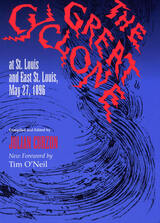 The Great Cyclone at St Louis and East St. Louis, May 27, 1896
Compiled and Edited by Julian Curzon. Foreword by Tim O'Neil
Southern Illinois University Press, 1997 Shortly after 5:00 P.M. On Wednesday, May 27, 1896, a Herculean tornado shattered the St. Louis Area. Within twenty minutes, 137 people had perished in St. Louis, with 118 dead across the river in East St. Louis. Along a ten-mile swath of devastation, the tornado destroyed 311 buildings, heavily damaged 7,200 others and caused significant harm to 1,300 more. Even today, that powerful cyclone of a century ago "remains the single deadliest incident to befall the St. Louis area," according to Tim O’Neil of the St.Louis Post-Dispatch, who wrote the foreword for this historic reprint of a book originally published by the Cyclone Publishing Company. Heavily illustrated by photographs of the damage, The Great Cyclone was compiled from stories in the city’s daily newspapers—the Globe-Democrat, the Post-Dispatch, and, most notably, the old St. Louis Republic. O’Neil points out that "the book’s compilers are not identified, but their glowing praise of the ‘superb descriptive composition’ in the Republic provides a good guess about where most of them worked."
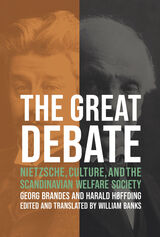 The Great Debate: Nietzsche, Culture, and the Scandinavian Welfare Society
Georg Brandes and Harald Høffding
University of Wisconsin Press, 2024 In 1889, Danish literary critic Georg Brandes published “Aristocratic Radicalism: An Essay on Friedrich Nietzsche,” which transformed the as-yet-unknown German-Swiss philosopher into a European, and ultimately global, phenomenon. The article sparked a furious public debate between Brandes and a fellow Dane, philosopher Harald Høffding, who swiftly issued a rebuttal, “Democratic Radicalism: An Objection.” What began as a scholarly disagreement over Nietzsche’s philosophy rapidly spiraled into a sprawling contest of competing visions of society’s future, one radically aristocratic and the other radically democratic.
Marking the moment at which the uniquely Nordic concept of social democratic welfare was first contested in the public sphere, this debate provides insights into not only Nietzschean philosophy and its immediate reception but also the foundational concept of modern Scandinavian social, cultural, and political organization. This volume presents, for the first time in any language other than Danish, the debate in its entirety: three essays by Brandes and three by Høffding. A critical introduction by editor and translator William Banks explores the exchange in its context and convincingly argues that the principles contested by the two Danish luminaries still very much resonate in Western society today.
Great Debates: Language and Culture Skills for ESL Students
Meredith Westfall and John McCarthy
University of Michigan Press, 2004
This book provides vocabulary, conversation tips, language learning tips, and discussion activities to help students debate on a wide variety of fairly non-controversial topics, from dining in or eating out, using the phone or e-mail, type A or type B, fiction or non-fiction, love at first sight or love over time, to diet or exercise.
Along with the discussion activities, the book contains some reading, writing, and vocabulary activities.
Each of the 30 units includes:
pre-debate discussion questions
new vocabulary words
a reading that outlines both sides of the debate
comprehension questions
discussion activities that include expressions used in debate-related speech acts and those pertaining to language learning
writing assignments
idiom and vocabulary review.
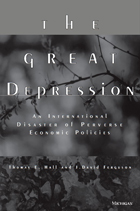 The Great Depression: An International Disaster of Perverse Economic Policies
Thomas E. Hall and J. David Ferguson
University of Michigan Press, 1998 The Great Depression was the worst economic catastrophe in modern history. Not only did it cause massive worldwide unemployment, but it also led to the rise of Adolf Hitler in Germany, World War II in Europe, and the tragic deaths of tens of millions of people. This book describes the sequence of policy errors committed by powerful, well-meaning people in several countries, which, in combination with the gold standard in place at the time, caused the disaster. In addition, it details attempts to reduce unemployment in the United States by Franklin Roosevelt's New Deal, and in Germany by Hitler's National Socialist economic policies.
A comprehensive economic and historical explanation of the events pertaining to the Depression, this book begins by describing the economic setting in the major industrialized countries during the 1920s and the gold standard that linked theory economies together. It then discusses the triggering event that started the economic decline--the Federal Reserve's credit tightening in reaction to perceived overspeculation in the U.S. stock market. The policy bungling that transformed the recession into the Great Depression is detailed: Smoot Hawley, the Federal Reserve's disastrous adherence to the real bills doctrine, and Hoover's 1932 tax hike. This is followed by a detailed description of the New Deal's shortcomings in trying to end the Depression, along with a discussion of the National Socialist economic programs in Germany. Finally, the factors that ended the Depression are examined.
This book will appeal to economists, historians, and those interested in business conditions who would like to know more about the causes and consequences of the Great Depression. It will be particularly useful as a supplementary text in economic history courses.
Thomas E. Hall and J. David Ferguson are both Professors of Economics, Miami University.
 The Great Depression in Eastern Europe
Klaus Richter
Central European University Press, 2025 As the centenary of the Great Depression approaches, this book offers a historical study of its impact on Eastern Europe. Due to its agricultural dominance this region was particularly hard hit. The volume focuses on ten states of the interwar period that had emerged from the Ottoman, Romanov, Habsburg, and Hohenzollern empires and where national sovereignty was particularly contested. The contributing authors apply an integrative approach that uses economic change as a starting point for analysing socio-institutional changes and political realignments. They review the main responses that the respective countries have made to try to mitigate the impact of the crises, such as economic protectionism or the construction of welfare states. The contributions also examine the profound impact of the Depression on the relationship between societies and states, between genders, between social classes, and between different nationalities. By moving the study of economic nationalism from economic history to the center of social and political history, the volume contributes to a much better understanding of states, societies and nationalism in Eastern Europe in the 1930s.
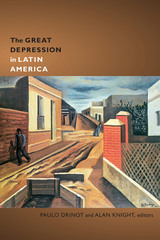 The Great Depression in Latin America
Paulo Drinot and Alan Knight, eds.
Duke University Press, 2014 Although Latin America weathered the Great Depression better than the United States and Europe, the global economic collapse of the 1930s had a deep and lasting impact on the region. The contributors to this book examine the consequences of the Depression in terms of the role of the state, party-political competition, and the formation of working-class and other social and political movements. Going beyond economic history, they chart the repercussions and policy responses in different countries while noting common cross-regional trends--in particular, a mounting critique of economic orthodoxy and greater state intervention in the economic, social, and cultural spheres, both trends crucial to the region's subsequent development. The book also examines how regional transformations interacted with and differed from global processes. Taken together, these essays deepen our understanding of the Great Depression as a formative experience in Latin America and provide a timely comparative perspective on the recent global economic crisis.
Contributors. Marcelo Bucheli, Carlos Contreras, Paulo Drinot, Jeffrey L. Gould, Roy Hora, Alan Knight, Gillian McGillivray, Luis Felipe Sáenz, Angela Vergara, Joel Wolfe, Doug Yarrington
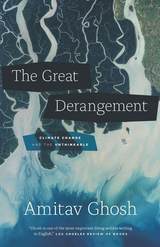 The Great Derangement: Climate Change and the Unthinkable
Amitav Ghosh
University of Chicago Press, 2016 Are we deranged? The acclaimed Indian novelist Amitav Ghosh argues that future generations may well think so. How else to explain our imaginative failure in the face of global warming? In his first major book of nonfiction since In an Antique Land, Ghosh examines our inability—at the level of literature, history, and politics—to grasp the scale and violence of climate change.
The extreme nature of today’s climate events, Ghosh asserts, make them peculiarly resistant to contemporary modes of thinking and imagining. This is particularly true of serious literary fiction: hundred-year storms and freakish tornadoes simply feel too improbable for the novel; they are automatically consigned to other genres. In the writing of history, too, the climate crisis has sometimes led to gross simplifications; Ghosh shows that the history of the carbon economy is a tangled global story with many contradictory and counterintuitive elements.
Ghosh ends by suggesting that politics, much like literature, has become a matter of personal moral reckoning rather than an arena of collective action. But to limit fiction and politics to individual moral adventure comes at a great cost. The climate crisis asks us to imagine other forms of human existence—a task to which fiction, Ghosh argues, is the best suited of all cultural forms. His book serves as a great writer’s summons to confront the most urgent task of our time.
The Great Devonian Controversy: The Shaping of Scientific Knowledge among Gentlemanly Specialists
Martin J. S. Rudwick
University of Chicago Press, 1985 "Arguably the best work to date in the history of geology."—David R. Oldroyd, Science
"After a superficial first glance, most readers of good will and broad knowledge might dismiss [this book] as being too much about too little. They would be making one of the biggest mistakes in their intellectual lives. . . . [It] could become one of our century's key documents in understanding science and its history."—Stephen Jay Gould, New York Review of Books
"Surely one of the most important studies in the history of science of recent years, and arguably the best work to date in the history of geology."—David R. Oldroyd, Science
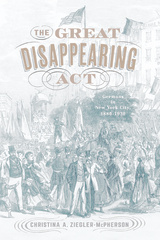 The Great Disappearing Act: Germans in New York City, 1880-1930
Christina A. Ziegler-McPherson
Rutgers University Press, 2022 Where did all the Germans go? How does a community of several hundred thousand people become invisible within a generation?
This study examines these questions in relation to the German immigrant community in New York City between 1880-1930, and seeks to understand how German-American New Yorkers assimilated into the larger American society in the early twentieth century.
By the turn of the twentieth century, New York City was one of the largest German-speaking cities in the world and was home to the largest German community in the United States. This community was socio-economically diverse and increasingly geographically dispersed, as upwardly mobile second and third generation German Americans began moving out of the Lower East Side, the location of America’s first Kleindeutschland (Little Germany), uptown to Yorkville and other neighborhoods. New York’s German American community was already in transition, geographically, socio-economically, and culturally, when the anti-German/One Hundred Percent Americanism of World War I erupted in 1917.
This book examines the structure of New York City’s German community in terms of its maturity, geographic dispersal from the Lower East Side to other neighborhoods, and its ultimate assimilation to the point of invisibility in the 1920s. It argues that when confronted with the anti-German feelings of World War I, German immigrants and German Americans hid their culture – especially their language and their institutions – behind closed doors and sought to make themselves invisible while still existing as a German community.
But becoming invisible did not mean being absorbed into an Anglo-American English-speaking culture and society. Instead, German Americans adopted visible behaviors of a new, more pluralistic American culture that they themselves had helped to create, although by no means dominated. Just as the meaning of “German” changed in this period, so did the meaning of “American” change as well, due to nearly 100 years of German immigration.
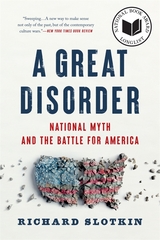 A Great Disorder: National Myth and the Battle for America
Richard Slotkin
Harvard University Press, 2024 Longlisted for the National Book Award in Nonfiction
Longlisted for the Edwards Book Award
A Foreign Affairs Best Book of the Year
“Sweeping…A new way to make sense not only of the past, but of the contemporary culture wars.”
—New York Times Book Review
“A provocative culmination of Slotkin’s field-defining arguments on the place of violence in creating America.” —Kathleen Belew
“Brisk, bold, and thought-provoking.” —Daniel Lazare, Arts Fuse
“[An] exciting and detailed new decoder ring of a book…While it is usually hyperbolic to claim that a book will change your life, this one may well have a permanent effect on how you consume and think about American political news.” —Tom Zoellner, Los Angeles Review of Books
Red America and Blue America are so divided they could be two different countries, with wildly diverging views of why government exists and who counts as American. Their ideologies are grounded in different versions of American history, endorsing irreconcilable visions of patriotism and national identity.
A Great Disorder is a bold, urgent work that helps us make sense of today’s culture wars through a brilliant reconsideration of America’s foundational myths and their use in contemporary politics. Richard Slotkin identifies five key narratives that have shaped our conception of what it means to be American: the myths of the Frontier, the Founding, the Civil War (with dueling views of it as Liberation or the Lost Cause), and the Good War. Today, Slotkin argues, Trump and his MAGA followers play up a frontier-inspired hostility to the federal government and rally around Confederate symbols to champion a racially exclusive definition of American nationality; meanwhile, Blue America takes its cue from the protest movements of the 1960s, envisioning a limitlessly pluralistic country in which the federal government is the ultimate enforcer of rights and opportunities. With these opposing perspectives, American history—and the foundations of our democracy—has become a battleground. It remains to be seen which vision will prevail.
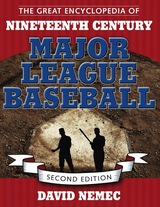 The Great Encyclopedia of Nineteenth-Century Major League Baseball
David Nemec
University of Alabama Press, 2006 The authoritative compendium of facts, statistics, photographs, and analysis that defines baseball in its formative first decades This comprehensive reference work covers the early years of major league baseball from the first game—May 4, 1871, a 2-0 victory for the Fort Wayne Kekiongas over the visiting Cleveland Forest City team—through the 1900 season. Baseball historian David Nemec presents complete team rosters and detailed player, manager, and umpire information, with a wealth of statistics to warm a fan’s heart. Sidebars cover a variety of topics, from oddities—the team that had the best record but finished second—to analyses of why Cleveland didn’t win any pennants in the 1890s. Additional benefits include dozens of rare illustrations and narrative accounts of each year’s pennant race. Nemec also carefully charts the rule changes from year to year as the game developed by fits and starts to formulate the modern rules. The result is an essential work of reference and at the same time a treasury of baseball history. This new edition adds much material unearthed since the first edition, fills gaps, and corrects errors, while presenting a number of new stories and fascinating details. David Nemec began the lifetime labor that helped produced this work in 1954 and admits it may never end, as there always will be some obscure player whose birth date has not yet been found. Until perfection is achieved, this work offers state-of-the-art accuracy and detail beyond that supplied by even modern baseball encyclopedias. As Casey Stengel, who was born during this era, was wont to say, “you could look it up.” Now you can.
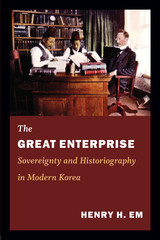 The Great Enterprise: Sovereignty and Historiography in Modern Korea
Henry H. Em
Duke University Press, 2013 In The Great Enterprise, Henry H. Em examines how the project of national sovereignty shaped the work of Korean historians and their representations of Korea's past. The goal of Korea attaining validity and equal standing among sovereign nations, Em shows, was foundational to modern Korean politics in that it served a pedagogical function for Japanese and Western imperialisms, as well as for Korean nationalism. Sovereignty thus functioned as police power and political power in shaping Korea's modernity, including anticolonial and postcolonial movements toward a radically democratic politics. Surveying historical works written over the course of the twentieth century, Em elucidates the influence of Christian missionaries, as well as the role that Japan's colonial policy played in determining the narrative framework for defining Korea's national past. Em goes on to analyze postcolonial works in which South Korean historians promoted national narratives appropriate for South Korea's place in the U.S.-led Cold War system. Throughout, Em highlights equal sovereignty's creative and productive potential to generate oppositional subjectivities and vital political alternatives.
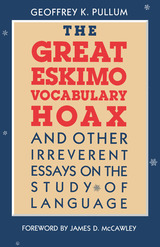 The Great Eskimo Vocabulary Hoax and Other Irreverent Essays on the Study of Language
Geoffrey K. Pullum
University of Chicago Press, 1991 How reliable are all those stories about the number of Eskimo words for snow? How can lamps, flags, and parrots be libelous? How might Star Trek's Commander Spock react to Noam Chomsky's theories of language? These and many other odd questions are typical topics in this collection of essays that present an occasionally zany, often wry, but always fascinating look at language and the people who study it.
Geoffrey K. Pullum's writings began as columns in Natural Language and Linguistic Theory in 1983. For six years, in almost every issue, under the banner "TOPIC. . .COMMENT," he published a captivating mélange of commentary, criticism, satire, whimsy, and fiction. Those columns are reproduced here—almost exactly as his friends and colleagues originally warned him not to publish them—along with new material including a foreword by James D. McCawley, a prologue, and a new introduction to each of these clever pieces. Whether making a sneak attack on some sacred cow, delivering a tongue-in-cheek protest against current standards, or supplying a caustic review of some recent development, Pullum remains in touch with serious concerns about language and society. At the same time, he reminds the reader not to take linguistics too seriously all of the time.
Pullum will take you on an excursion into the wild and untamed fringes of linguistics. Among the unusual encounters in store are a conversation between Star Trek's Commander Spock and three real earth linguists, the strange tale of the author's imprisonment for embezzling funds from the Campaign for Typographical Freedom, a harrowing account of a day in the research life of four unhappy grammarians, and the true story of how a monograph on syntax was suppressed because the examples were judged to be libelous. You will also find a volley of humorous broadsides aimed at dishonest attributional practices, meddlesome copy editors, mathematical incompetence, and "cracker-barrel philosophy of science." These learned and witty pieces will delight anyone who is fascinated by the quirks of language and linguists.
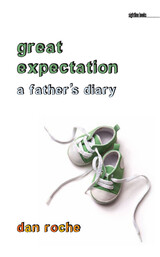 Great Expectation: A Father's Diary
Dan Roche
University of Iowa Press, 2008 In Great Expectation, Dan Roche gives a man's perspective on what it means to start and expand a family relatively later in life. Through a series of diary entries in turns humorous, angst ridden, and full of hope and joy, Roche describes his own thoughts and concerns during the nine months of his wife's pregnancy.
With five years of parenting his irrepressible daughter Maeve under his belt, Roche, already forty-five years old, and his wife, Maura, face the prospect of another arrival and the myriad of emotions that come with a second child. From revelling in the joys of pregnancy such as Maura's delight at "having cleavage" and being able to eat whatever she desires; to assuaging the parental anxieties of choosing the right obstetrician, correcting the mistakes one made with the first child, and sending children to college in the future; to navigating the unforeseen, experiencing the unexpected death of a parent, and feeling trepidation toward the thought of having a son, Roche records his emotions with unusual candidness and intimacy.
Reflecting on day-to-day events and their significance in his family’s life together, Roche wonders what he is getting himself into and how much deeper he can immerse himself into parenting. Together, he and his wife face the bittersweet intersections of death and new life, menace and hopefulness. With sincerity and a mature wit, Great Expectation stands as a wise recounting of nine months’ time, with all of its chaos and charms, and offers a fresh perspective for first-time and veteran parents alike.
 Great Expectations and Interwar Realities: Cultural Diplomacy in Horthy's Hungary
Zsolt Nagy
Central European University Press, 2017 After the shock of the 1920 Treaty of Trianon, which Hungarians perceived as an unfair dictate, the leaders of the country found it imperative to change Hungary’s international image in a way that would help the revision of the post-World War I settlement. The monograph examines the development of interwar Hungarian cultural diplomacy in three areas: universities, the tourist industry, and the media—primarily motion pictures and radio production. It is a story of the Hungarian elites’ high hopes and deep-seated anxieties about the country’s place in a Europe newly reconstructed after World War I, and how these elites perceived and misperceived themselves, their surroundings, and their own ability to affect the country’s fate. The defeat in the Great War was crushing, but it was also stimulating, as Nagy documents in his examination of foreign language journals, tourism, radio, and other tools of cultural diplomacy. The mobilization of diverse cultural and intellectual resources, the author argues, helped establish Hungary’s legitimacy in the international arena, contributed to the modernization of the country, and established a set of enduring national images. Though the study is rooted in Hungary, it explores the dynamic and contingent relationship between identity construction and transnational cultural and political currents in East-Central European nations in the interwar period.
Great Expectations: Marriage and Divorce in Post-Victorian America
Elaine Tyler May
University of Chicago Press, 1983 During the late nineteenth and early twentieth centuries, the divorce rate in the United States rose by a staggering 2,000 percent. To understand this dramatic rise, Elaine Tyler May studied over one thousand detailed divorce cases. She found that contrary to common assumptions, divorce was not simply a by-product of women's increasing economic and sexual independence, or a rebellion against marriage. Rather, thwarted hopes for fulfillment in the public sphere drove both men and women to wed at a greater rate and to bring higher expectations to their marriages.
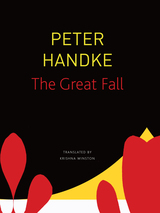 The Great Fall
Peter Handke
Seagull Books, 2018 “On the day of the Great Fall he left nothing, nothing at all behind.”
The latest work by Peter Handke, one of our greatest living writers, chronicles a day in life of an aging actor as he makes his way on foot from the outskirts of a great metropolis into its center. He is scheduled to receive a prestigious award that evening from the country’s president, and the following day he is supposed to start shooting for a film—perhaps his last—in which he plays a man who runs amok. While passing through a forest, he encounters the outcasts of the society—homeless people and migrants—but he keeps trudging along, traversing a suburb whose inhabitants are locked in petty but mortal conflicts, crossing a seemingly unbridgeable superhighway, and wandering into an abandoned railyard, where police, unused to pedestrians, detain him briefly on suspicion of terrorism.
Things don’t improve when he reaches the heart of the city. There he can’t help but see the alienation characteristic of its residents and the omnipresent malign influence of electronic technology. What, then, is the “Great Fall”? What is this heart-wrenching, humorous, distinctively attentive narrative trying to tell us? As usual, Peter Handke, deeply introspective and powerfully critical of the world around him, leaves it to the reader to figure out.
The Great Famine and the Irish Diaspora in America
Arthur Gribben
University of Massachusetts Press, 1999 Between 1845 and 1855, nearly 1.5 million Irish women, men, and children sailed to America to escape the Great Famine, triggered by successive years of potato blight. The famine and resulting emigration had a profound impact not only on the history of Ireland, but on that of England and North America as well. This volume of original essays commemorates the 150th anniversary of these epochal events and sheds new light on both the consequences of the famine and experience of the Irish in America.
 A Great Fear: Luís de Onís and the Shadow War against Napoleon in Spanish America, 1808–1812
Timothy Hawkins
University of Alabama Press, 2019 An exploration of the Spanish colonial reaction to the threat of Napoleonic subversion
A Great Fear: Luís de Onís and the Shadow War against Napoleon in Spanish America, 1808–1812 explores why Spanish Americans did not take the opportunity to seize independence in this critical period when Spain was overrun by French armies and, arguably, in its weakest state. In the first years after his appointment as Spanish ambassador to the United States, Luís de Onís claimed the heavy responsibility of defending Spanish America from the wave of French spies, subversives, and soldiers whom he believed Napoleon was sending across the Atlantic to undermine the empire.
As a leading representative of Spain’s loyalist government in the Americas, Onís played a central role in identifying, framing, and developing what soon became a coordinated response from the colonial bureaucracy to this perceived threat. This crusade had important short-term consequences for the empire. Since it paralleled the emergence of embryonic independence movements against Spanish rule, colonial officials immediately conflated these dangers and attributed anti-Spanish sentiment to foreign conspiracies.
Little direct evidence of Napoleon’s efforts at subversion in Spanish America exists. However, on the basis of prodigious research, Hawkins asserts that the fear of French intervention mattered far more than the reality. Reinforced by detailed warnings from Ambassador Onís, who found the United States to be the staging ground for many of the French emissaries, colonial officials and their subjects became convinced that Napoleon posed a real threat. The official reaction to the threat of French intervention increasingly led Spanish authorities to view their subjects with suspicion, as potential enemies rather than allies in the struggle to preserve the empire. In the long term, this climate of fear eroded the legitimacy of the Spanish Crown among Spanish Americans, a process that contributed to the unraveling of the empire by the 1820s.
This study draws on documents and official records from both sides of the Hispanic Atlantic, with extensive research conducted in Spain, Guatemala, Argentina, and the United States. Overall, it is a provocative interpretation of the repercussions of Napoleonic intrigue and espionage in the New World and a stellar examination of late Spanish colonialism in the Americas.
 The Great Game: Essays on Poetics
Amit Majmudar
Acre Books, 2024 In this essay collection, Amit Majmudar meditates on the poetic canon of the West and the traditions of world literature.
In The Great Game, poet, critic, translator, and literary omnivore Amit Majmudar ranges widely, writing with characteristic verve on canonical authors such as Milton, Byron, and Emily Dickinson, contemporaries like Kay Ryan, and other traditions of world literature. He examines verse drama and philosophy and even touches on writers of popular prose like Robert Ludlum and Ray Bradbury. A radiologist as well as a writer, Majmudar brings together the diagnostician’s precision with the poet’s imagination and an encyclopedic base of knowledge. He practices literary criticism as a global art, one with the intensity of verse, the depth of philosophy, and the scope of history—and does so with the infectious curiosity of a passionate reader.
Some of the most powerful essays here are synoptic meditations on science and poetry in which Majmudar shows that anyone trying to make fresh sense of the world, be it Milton or Kepler or Dickinson or Darwin, is practicing something like poetic meaning-making. The collection’s diverse inquiries are held together by Majmudar’s sustained, thoughtful, delightfully inventive attention to poetic form as an idea, to specific forms like the ghazal and the epic, and by his nimble, empathetic readings of individual writers. The Great Game is an intellectually thrilling tour of poetry across centuries, geographic divides, and even the disciplinary boundaries that separate science from philosophy from poetry.
 The Great Gatsby and Fitzgerald's World of Ideas
Ronald Berman
University of Alabama Press, 2000 Berman examines the intellectual and cultural milieu in which The
Great Gatsby was created--and challenges accepted interpretations of
Fitzgerald's greatest novel. "The Great Gatsby" and Fitzgerald's World of Ideas
focuses on F. Scott Fitzgerald and the prevailing ideas and values
that permeated American society in the late teens and early twenties, providing
a vivid portrait of the intellectual and cultural milieu in which The
Great Gatsby was produced. This new and original reading of Gatsby discloses
Fitzgerald's remarkable awareness of the issues of his time and his debt
to such philosophers and critics as William James, Josiah Royce, George
Santayana, John Dewey, Walter Lippman, H. L. Mencken, and Edmund Wilson.
Ronald Berman's fresh approach considers the meaning of various ideas important
to the novel: for example, those moral qualities governing both social
and individual life. Berman's reading of the text reveals extraordinary
emphases on matters that could productively be described as philosophical
-- the nature of friendship, love, and the good life. But the text of the
novel has many echoes, and the same concern with moral issues -- especially
those issues affecting democratic life - can be found in a number of other
texts of the first quarter of the century. Vigorously debated throughout
Fitzgerald's own lifetime, these texts shed a completely new light on the
idealism of The Great Gatsby and on the penetrating view it has
of life in a new form of American democracy. A noted Fitzgerald scholar, Berman makes it clear that
accepted interpretations of The Great Gatsby and of Fitzgerald's
work in general must be changed. Berman demonstrates that Fitzgerald wrote
within a vast dialectic, relating the ideas of the twenties to those of
the "old America" described in so many of his works. Gatsby, Nick Carraway,
and the other characters of Fitzgerald's greatest novel all have to consider
not only their relationship to the present but also their distance from
what was once a highly meaningful past.
 Great Gatsby and Modern Times
Ronald Berman
University of Illinois Press, 1994 "A stunning piece of
work. If Fitzgerald could have wished for one reader of The Great Gatsby,
it would have been Ronald Berman. Berman's criticism creates an ideal
companion piece to the novel--as brilliantly illuminating about America
as it is about fiction, and composed with as much thought and style."
-- Roger Rosenblatt
"An impressive study
that brilliantly highlights the oneness of Fitzgerald's art with the overall
context of modernism." -- Milton R. Stern, author of The Golden
Moment: The Novels of F. Scott Fitzgerald
"Citing films, dates,
places, schedules, Broadway newsstands, and the spoils of manufacture,
the author, never lapsing into critical jargon, locates the characters
in 'the moving present.' Gatsby, the first of the great novels
to emerge from B movies, uses the language of commodities, advertisements,
photography, cinematography, and Horatio Alger to present models of identity
for characters absorbed in and by what is communicated. . . . Berman concludes
that Gatsby 'reassembled' rather than 'invented' himself."
-- A. Hirsh, Choice
 The Great Gelatin Revival: Savory Aspics, Jiggly Shots, and Outrageous Desserts
Ken Albala
University of Illinois Press, 2023 Once synonymous with food novelty, gelatin has re-emerged as an attention-grabbing element of creative cuisine and avant-garde drinkology. Ken Albala’s most fearless food exploration yet takes readers into the sublime world of aspics past and present. Blending history with his trademark zeal for experimentation, Albala traces gelatin’s ever-changing fortunes alongside one-of-a-kind recipes that inspire, delight, and terrify as only jello can do. Gelatin’s wondrous arrival in the medieval era was part of a technological watershed. Today, it reflects our high-tech zeitgeist. Albala encourages readers to celebrate gelatin's return with advice on creating a base and making silicone molds while his outrageous original creations dare you to add some jiggle to breakfast (Eggs Benedict in Champagne Jello), a nightcap (Froot Loop Negroni), or any culinary moment in between. A lighthearted manifesto for the new age of aspics, The Great Gelatin Revival rattles our very understanding of what food can be.
 The Great Global Transformation: The United States, China, and the Remaking of the World Economic Order
Branko Milanovic
University of Chicago Press, 2026 From the essential chronicler of the world economy, a portrait of the Great Powers in transition.
The world’s two great economic powers are on opposite trajectories. In the United States, decades of neoliberal policies produced a small class of rich elites and gutted the middle class. In China, the same global forces have created a massive new upper class. The result is the greatest reshuffling of global incomes since the Industrial Revolution—a dramatic shakeup of each country’s political order. As the two powers retreat from one another, the implications for their futures, and for the world economy, are uncertain.
In The Great Global Transformation, acclaimed economist Branko Milanovic draws on original research to chart how these seismic shifts will shape the next century of the global economy. As both the US and China retreat into protectionism, Milanovic shows how a new and multipolar world order will follow—and how rising nationalism will have dramatically different effects on the two countries. And he shows us the fight ahead: as plutocracy returns, global war threatens, and a new system silently shapes our nations, driving populist discontent to breaking point.
A worthy successor to Capitalism, Alone and his other landmark works, Milanovic’s new book announces the arrival of a new era he terms “national market liberalism,” in which liberalism survives in domestic economies, but not necessarily in the social arena. The Great Global Transformation is Milanovic’s indispensable account of the new twenty-first century now underway.
 The Great Gulf: Fishermen, Scientists, and the Struggle to Revive the World's Greatest Fishery
David Dobbs
Island Press, 2000 For hundreds of years, the New England cod fishery was one of the most productive in the world, with higher average annual landings than any comparable ocean area. But in the late 1980s, fish catches dropped precipitously, as the cod, flounder, and other species that had long dominated the region seemed to lose their ability to recover from the massive annual harvests. Even today, with fishing sharply restricted, populations have not recovered. Largely overlooked in this disaster is the intriguing human and scientific puzzle that lies at its heart: an anguished, seemingly inexplicable conflict between government scientists and fishermen over how fish populations are assessed, which has led to bitter disputes and has crippled efforts to agree on catch restrictions. In The Great Gulf, author David Dobbs offers a fascinating and compelling look at both sides of the conflict. With great immediacy, he describes the history of the fisheries science in this most studied of oceans, and takes the reader on a series of forays over the Gulf of Maine and Georges Bank on both fishing boats and research vessels. He introduces us to the challenges facing John Galbraith, Linda Despres, and Jay Burnett, passionate and dedicated scientists with the National Marine Fisheries Service who spend countless hours working to determine how many fish there really are, and to the dilemma of Dave Goethel, a whipsmart, conscientious fisherman with 20 years's experience who struggles to understand the complex world he works in while maintaining his livelihood in an age of increasing regulation. Dobbs paints the New England fishery problem in its full human and natural complexity, vividly portraying the vitality of an uncontrollable, ultimately unknowable sea and its strange, frightening, and beautiful creatures on the one hand, and on the other, the smart, irrepressible, unpredictable people who work there with great joy and humor, refusing to surrender to the many reasons for despair or cynicism. For anyone who read Cod or The Perfect Storm, this book offers the next chapter of the story -- how today's fishers and fisheries scientists are grappling with the collapse of this fishery and trying to chart, amid uncertain waters, a course towards its restoration.
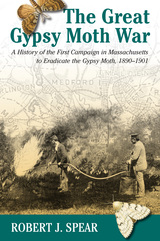 The Great Gypsy Moth War: A History of the First Campaign in Massachusetts to Eradicate the Gypsy Moth, 1890-1901
Robert J. Spear
University of Massachusetts Press, 2005 In The Great Gypsy Moth War, Robert J. Spear presents the untold story behind the importation and release of the gypsy moth in North America and the astonishing series of coincidences that brought the state of Massachusetts to a decade-long war against this tenacious insect. Spear traces the events leading up to the beginning of the war in 1890, notes the causes for its failure, and shows the terrible legacy it left as the precedent for all subsequent insect-eradication campaigns.
During the Civil War, when the supply of cotton from southern fields was disrupted, the owners of northern textile mills looked elsewhere for raw fiber. One source was silk. Among those experimenting with silkworm production was a Frenchman named Etienne Leopold Trouvelot, who had settled outside of Boston. It was Trouvelot who imported the gypsy moths and inadvertently allowed them to escape. Soon the invasion was on and a counteroffensive was required.
Spear reveals the turbulent undercurrents in the eradication campaign when the enthusiasm of the entomologists in charge turned into desperation upon the discovery that their alien adversary was much tougher than they thought. Fighting a war they could not win and dared not lose, the leaders of the campaign resorted to political maneuvering, cheap tricks, and outright misrepresentation to maintain a façade of success, urging the Commonwealth to continue funding the war long after any chance of victory had faded.
More than just reviewing the important events of this historic episode, Spear tells the story in an engaging way, often through the first-hand accounts of those who were directly involved. Much of what Spear has written is new, the recounting is lively, and the information he presents shows that almost all of the previous beliefs about the campaign to eradicate the gypsy moths are myths. In the process, he also traces the rise of modern economic entomology and the birth of the pesticide industry.
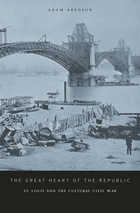 The Great Heart of the Republic: St. Louis and the Cultural Civil War
Adam Arenson
Harvard University Press, 2010 The Civil War revealed what united as well as what divided Americans in the nineteenth century—not only in its deadly military conflict, but also in the broader battle of ideas, dueling moral systems, and competing national visions that preceded and followed. This cultural civil war was the clash among North, South, and West, as their leaders sought to shape Manifest Destiny and slavery politics.
No site embodied this struggle more completely than St. Louis, the largest city along the border of slavery and freedom. In this sweeping history, Adam Arenson reveals a city at the heart of the cultural civil war. St. Louisans heralded a new future, erasing old patterns as the United States stretched across the continent. They tried to reorient the nation’s political landscape, with westerners in the vanguard and St. Louis as the cultural, commercial, and national capital. John C. Calhoun, Frederick Douglass, Walt Whitman, and John Brown tracked the progress of the cultural contest by monitoring events in St. Louis, observing how the city’s leaders tried yet ultimately failed to control the national destiny.
The interplay of local ambitions and national meanings reveals the wider cultural transformation brought about by westward expansion, political strife, and emancipation in the era of the Civil War and Reconstruction. This vibrant and beautifully written story enriches our understanding of America at a crossroads.
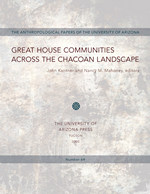 Great House Communities across the Chacoan Landscape
John Kantner
University of Arizona Press, 2000 Beginning in the tenth century, Chaco Canyon emerged as an important center whose influence shaped subsequent cultural developments throughout the Four Corners area of the American Southwest. Archaeologists investigating the prehistory of Chaco Canyon have long been impressed by its massive architecture, evidence of widespread trading activities, and ancient roadways that extended across the region. Research on Chaco Canyon today is focused on what the remains indicate about the social, political, and ideological organization of the Chacoan people. Communities with great houses located some distance away are of particular interest, because determining how and why peripheral areas became associated with the central canyon provides insight into the evolution of the Chacoan tradition. This volume brings together twelve chapters by archaeologists who suggest that the relationship between Chaco Canyon and outlying communities was not only complex but highly variable. Their new research reveals that the most distant groups may have simply appropriated Chacoan symbolism for influencing local social and political relationships, whereas many of the nearest communities appear to have interacted closely with the central canyon--perhaps even living there on a seasonal basis. The multifaceted approach taken by these authors provides different and refreshing perspectives on Chaco. Their contributions offer new insight into what a Chacoan community is and shed light on the nature of interactions among prehistoric communities.
 Great Houses and Gardens of New Jersey
Seebohm, Caroline
Rutgers University Press, 2003 Author Caroline Seebohm and photographer Peter C. Cook bring readers an exclusive look at some of New Jersey's most magnificent private homes and gardens. From a centuries-old farm to modern glass houses, from woodlands planted with native plants to formal French and English-style gardens, the book celebrates the rich diversity of architectural and gardening styles found in the state. More than 200 gorgeous color photographs, accompanied by inspired accounts, celebrate the beauty of New Jersey homes and gardens.
New Jersey is called the Garden State with good reason- some of the nation's most strikingly beautiful homes and gardens can be found within its borders. Caroline Seebohm and Peter C. Cook have captured them gloriously in Great Houses and Gardens of New Jersey.
No other book has so beautifully presented the architectural story of the state, stunningly documented in more than 200 color photographs- from a centuries-old farm to modern glass houses, from woodlands planted with native plants to formal French and English-style gardens. Each house and garden is privately owned, and many have never before been photographed. Readers are given an exclusive peek at some of New Jersey's greatest treasures.
Seebohm and Cook take us on a private tour of a pre-revolutionary Dutch farmhouse that could have sprung from the coast of Devon in England; a brick-patterned house that vividly expresses the originality and exuberance of the region's early builders and craftsmen; a collection of native stone buildings reminiscent of Bucks County, Pennsylvania; and an Arts and Crafts house with contributions by New Jersey's innovative Gustav Stickley. The twentieth century is equally well represented with works by masters such as Frank Lloyd Wright, Robert Venturi, Michael Graves, and Richard Meier.
The book showcases gardens of dazzling splendor and variety- woodlands ablaze with native azaleas and dogwoods; a charming sunken garden by well-known English garden designer Penelope Hobhouse; a stunning water garden on the Navesink River; a tiny formal garden surrounded by a picket fence in Somerset County; a garden in Alpine carpeted with bluebells in the spring, scented with roses in the summer, and with orchids on display all year round.
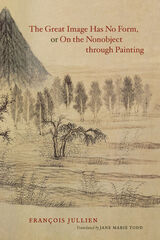 The Great Image Has No Form, or On the Nonobject through Painting
François Jullien
University of Chicago Press, 2009 In premodern China, elite painters used imagery not to mirror the world around them, but to evoke unfathomable experience. Considering their art alongside the philosophical traditions that inform it, The Great Image Has No Form explores the “nonobject”—a notion exemplified by paintings that do not seek to represent observable surroundings. François Jullien argues that this nonobjectifying approach stems from the painters’ deeply held belief in a continuum of existence, in which art is not distinct from reality. Contrasting this perspective with the Western notion of art as separate from the world it represents, Jullien investigates the theoretical conditions that allow us to apprehend, isolate, and abstract objects. His comparative method lays bare the assumptions of Chinese and European thought, revitalizing the questions of what painting is, where it comes from, and what it does. Provocative and intellectually vigorous, this sweeping inquiry introduces new ways of thinking about the relationship of art to the ideas in which it is rooted.
 The Great Indian Phone Book: How the Cheap Cell Phone Changes Business, Politics, and Daily Life
Assa Doron and Robin Jeffrey
Harvard University Press, 2013 In 2001, India had 4 million cell phone subscribers. Ten years later, that number had exploded to more than 750 million. Over just a decade, the mobile phone was transformed from a rare and unwieldy instrument to a palm-sized, affordable staple, taken for granted by poor fishermen in Kerala and affluent entrepreneurs in Mumbai alike. The Great Indian Phone Book investigates the social revolution ignited by what may be the most significant communications device in history, one which has disrupted more people and relationships than the printing press, wristwatch, automobile, or railways, though it has qualities of all four.
In this fast-paced study, Assa Doron and Robin Jeffrey explore the whole ecosystem of the cheap mobile phone. Blending journalistic immediacy with years of field-research experience in India, they portray the capitalists and bureaucrats who control the cellular infrastructure and wrestle over bandwidth rights, the marketers and technicians who bring mobile phones to the masses, and the often poor, village-bound users who adapt these addictive and sometimes troublesome devices to their daily lives. Examining the challenges cell phones pose to a hierarchy-bound country, the authors argue that in India, where caste and gender restrictions have defined power for generations, the disruptive potential of mobile phones is even greater than elsewhere.
The Great Indian Phone Book is a rigorously researched, multidimensional tale of what can happen when a powerful and readily available technology is placed in the hands of a large, still predominantly poor population.
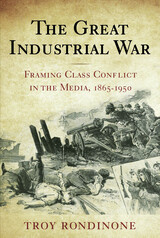 The Great Industrial War: Framing Class Conflict in the Media, 1865-1950
Rondinone, Troy
Rutgers University Press, 2011 The Great Industrial War, a comprehensive assessment of how class has been interpreted by the media in American history, documents the rise and fall of a frightening concept: industrial war. Moving beyond the standard account of labor conflict as struggles between workers and management, Troy Rondinone asks why Americans viewed big strikes as "battles" in "irrepressible conflict" between the armies of capital and laborùa terrifying clash between workers, strikebreakers, police, and soldiers. Examining how the mainstream press along with the writings of a select group of influential reformers and politicians framed strike news, Rondinone argues that the Civil War, coming on the cusp of a revolution in industrial productivity, offered a gruesome, indelible model for national conflict. He follows the heated discourse on class war through the nineteenth century until its general dissipation in the mid-twentieth century. Incorporating labor history, cultural studies, linguistic anthropology, and sociology, The Great Industrial War explores the influence of historical experience on popular perceptions of social order and class conflict and provides a reinterpretation of the origins and meaning of the Taft-Hartley Act and the industrial relations regime it supported.
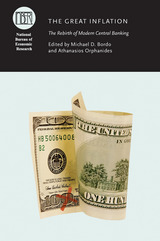 The Great Inflation: The Rebirth of Modern Central Banking
Edited by Michael D. Bordo and Athanasios Orphanides
University of Chicago Press, 2013 Controlling inflation is among the most important objectives of economic policy. By maintaining price stability, policy makers are able to reduce uncertainty, improve price-monitoring mechanisms, and facilitate more efficient planning and allocation of resources, thereby raising productivity.
This volume focuses on understanding the causes of the Great Inflation of the 1970s and ’80s, which saw rising inflation in many nations, and which propelled interest rates across the developing world into the double digits. In the decades since, the immediate cause of the period’s rise in inflation has been the subject of considerable debate. Among the areas of contention are the role of monetary policy in driving inflation and the implications this had both for policy design and for evaluating the performance of those who set the policy. Here, contributors map monetary policy from the 1960s to the present, shedding light on the ways in which the lessons of the Great Inflation were absorbed and applied to today’s global and increasingly complex economic environment.
 The Great Justices, 1941-54: Black, Douglas, Frankfurter, and Jackson in Chambers
William Domnarski
University of Michigan Press, 2006 The Great Justices offers a revealing glimpse of a judicial universe in which titanic egos often clash, and comes as close as any book ever has to getting inside the minds of Supreme Court jurists.
This is rare and little-examined territory: in the public consciousness the Supreme Court is usually seen as an establishment whose main actors, the justices, remain above emotion, vitriol, and gossip, the better to interpret our nation of laws. Yet the Court's work is always an interchange of ideas and individuals, and the men and women who make up the Court, despite or because of their best intentions, are as human as the rest of us. Appreciating that human dimension helps us to discover some of the Court's secrets, and a new way to understand the Court and its role.
Comparing four brilliant but very different jurists of the Roosevelt Court-Hugo Black, William O. Douglas, Felix Frankfurter, and Robert Jackson-William Domnarski paints a startling picture of the often deeply ambiguous relationship between ideas and reality, between the law and the justices who interpret and create it. By pulling aside the veil of decorous tradition, Domnarski brings to light the personalities that shaped one of the greatest Courts of our time-one whose decisions continue to affect judicial thinking today.
William Domnarski is the author of In the Opinion of the Court (1996), a study of the history and nature of federal court judicial opinions. He holds a J.D. from the University of Connecticut and a Ph.D. in English from the University of California. Domnarski currently practices law in California, where he is also working on a forthcoming biography of legendary Hollywood lawyer Bert Fields.
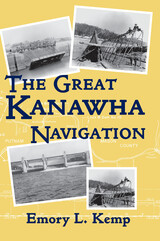 The Great Kanawha Navigation
Emory L. Kemp
University of Pittsburgh Press, 2000
The vision of a central waterway connecting tidewater Virginia with the Ohio River to rival the Erie Canal persisted for decades during the 19th century. The idea was at first fostered by the commonwealth of Virginia and then reincarnated as the Central Water Line, which was endorsed by the federal government. It was a grand vision, and though never implemented, the Great Kanawha Navigation nevertheless became a highly successful regionally controlled waterway that developed the rich resources of the Kanawha Valley. Emory Kemp has compiled a comprehensive history of navigation on the Great Kanawha River, detailing the industrial archaeology of this waterway from the early 19th century, and offering a detailed case study of a major 19th- and early 20th-century civil engineering project that would significantly advance the nation's industrial development.
Using the early unsuccessful attempts to connect the James River and western waters as a background, The Great Kanawha Navigation emphasizes technological innovation and construction of navigational structures on the river. With the river men championing open navigation during favorable stages of the river, and at the same time clamoring for controls to ensure navigation during periods of low flow, the Corps of Engineers responded with the concept of the movable dam to provide a cost-effective means of moving bulk cargo, especially coal, salt, lumber, cement, and chemicals, along nearly 100 miles of the Great Kanawha River. The Great Kanawha Navigation employed a series of ten locks and dams and became a laboratory for the use of movable dams in the United States, using first the French Chanoine shutter wicket dam and then the German Roller Gate dam. The innovative technology of the ten dams, the volume of freight carried and the management of the system by the Corps of Engineers made this one of the most significant public works in the nation. Each of the two systems provided cost-effective and environmentally sound means to tap the rich mineral resources of the Kanawha Valley. By any measure, the Great Kanawha Navigation has been one of the more successful ventures of the Corps of Engineers; Kemp has provided extensive photographs, illustrations, diagrams, and maps to further emphasize the construction of the various hydraulic structures. The result is an interesting and significant blend of biographical, technical, political, geographical, and industrial history that will delight historians of technology and the region.
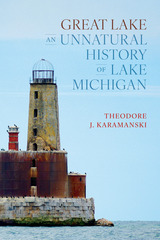 Great Lake: An Unnatural History of Lake Michigan
Theodore J. Karamanski
University of Michigan Press, 2026 Looking down from outer space a vast expanse of blue appears in the heart of North America. Of the magnificent chain of inland seas, only one of those bodies of water—Lake Michigan—is entirely within the boundaries of the United States. Lake Michigan has been uniquely shaped by its relationship with humans, since its geological evolution took place at the same time as Paleo-Indian peoples interacted with the changing environment. Each generation of humans has altered the lake to suit society’s changing needs, dredging harbors, building lighthouses, digging canals and channels, filling in shallows, and obliterating wetlands.
Great Lake is a comprehensive survey of the manifold ways Americans, from the first Native American communities to the present age, have abused, nurtured, loved, and neglected this massive freshwater resource. Extending 307 miles from north to south, the lake cuts across climatic, environmental, and physiographic zones, from the prairies of Illinois to the boreal forests of the north. Bordered by large cities like Chicago and Milwaukee as well as smaller Wisconsin resorts and northern Michigan mines and mill towns, the lake touches people in urban centers and countryside. Thus, the history of Lake Michigan combines the history of frontier resource extraction, agricultural abundance, industrialization, and dense urbanization in the American heartland. Great Lake is the story of the ever-escalating and divergent demands Americans have placed on Lake Michigan, how the lake’s ecosystem responded to those changes, and how together they have shaped the modern American Midwest.
 The Great Lake Sturgeon
Nancy Auer and Dave Dempsey
Michigan State University Press, 2013 The first book of its kind to explore this magnificent creature, this collected volume captures many aspects of the remarkable Great Lakes sturgeon, from the mythical to the critically real. Lake sturgeon are sacred to some, impressive to many, and endangered in the Great Lakes. A fish whose ancestry reaches back millions of years and that can live over a century and grow to six feet or more, the Great Lakes lake sturgeon was once considered useless, then overfished nearly to extinction. Though the fish is slowly making a comeback thanks to the awareness-raising efforts of Native Americans, biologists, and sturgeon supporters, it remains to be seen if conservation and stewardship will continue to the degree this remarkable animal deserves. Blending history, biology, folklore, environmental science, and policy, this accessible book seeks to reach a broad audience and tell the story of the Great Lakes lake sturgeon in a manner as diverse as its subject.
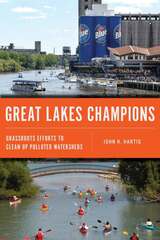 Great Lakes Champions: Grassroots Efforts to Clean Up Polluted Watersheds
John H. Hartig
Michigan State University Press, 2022 The Great Lakes—containing one-fifth of the standing freshwater on earth, covering some 94,250 square miles with a combined 10,210 miles of shoreline—have suffered greatly from human use and abuse since the advent of the commercial fur trade in the late 1600s. Logging destroys or degrades habitats, urbanization and industrialization pour human and industrial wastes into the water, fertilizers flowing off farm fields feed algae that suffocate other creatures, and ships bring in exotic species that decimate the lakes’ biodiversity. In 1985 when the International Joint Commission identified more than forty pollution hotspots around the lakes, few people had faith the Areas of Concern would be cleaned up in their lifetime. Indeed, aquatic ecosystem restoration is extremely difficult: only nine of these hotspots have been removed from the infamous list. But progress is being made, and at the helm are local champions, people with a profound love of the region who lead by example and build broad, diverse coalitions in order to realize a common vision. The stories of fourteen of these champions are told here to inspire necessary action to care for the place they call home, so it may be a home to many living creatures for ages yet to come.
Great Lakes Chronicle: Essays on Coastal Wisconsin
Wisconsin Coastal Management
Wisconsin Historical Society Press, 2018 Lakes Superior and Michigan have long played a vital role in shaping our state’s history, culture and economy. For forty years, the Wisconsin Coastal Management Program has collaborated with governments and nonprofit organizations to preserve and protect this crucial resource, and, since 2002, has promoted public awareness of issues affecting the lakes in its annual Wisconsin Great Lakes Chronicle. Great Lakes Chronicle: Essays on Coastal Wisconsin brings together more than one hundred articles by coastal management practitioners, providing a broad perspective on issues affecting Wisconsin’s Great Lakes shorelines, and advocating for the wise and balanced use of our coastal environment for the benefit of people now and in the future.
Great Lakes Fisheries Policy and Management: A Binational Perspective
William W. Taylor
Michigan State University Press, 2012 To maintain thriving, sustainable fisheries in the Laurentian Great Lakes, an understanding of the numerous and complex ecological, societal, economic, management, and policy issues surrounding them is critical. This incisive study provides a collaborative, interjurisdictional, and multi-use perspective that is shaped by the United states and Canada together as part of their shared governance of these waters. This book offers an informed look at the Great Lakes fisheries and their ecosystems, as the contributors examine both the threats they have faced and the valuable opportunities they provide for basin citizens and industries. Divided into four sections—the Great Lakes region, Great Lakes Fisheries, Fisheries case studies, and outlook for the Future—this is a valuable and up-to-date tool for students, researchers, policymakers, and managers alike.
 The Great Lakes Forest: An Environmental and Social History
Susan Flader
University of Minnesota Press, 1983
The Great Lakes Forest was first published in 1983.The upper Great Lakes region is an area with a common natural and human history in which the forest has been a prime factor. Known as the Laurentian Mixed Forest in the United States (it is a mix of coniferous and deciduous trees) and the Great Lakes-St. Lawrence Forest in Canada, it was subject to massive exploitation in the second half of the nineteenth century, when loggers cleared the forest’s pines to build the railroads, farms, and cities of the Middle West. Another distinctive trait of the region is the fact that it lies north of the effective limits of agriculture. Generations of native Woodland Indians adapted to life in the forest, but the failure of white settlers to understand the area’s agricultural limitations resulted in decades of wrenching social and institutional adjustment in the twentieth century.The 18 papers in this book were written in an effort to understand the relation between social and environmental change in the Great Lakes forest, a region that includes northern Michigan, Wisconsin and Minnesota and adjacent parts of Ontario. Contributors from the biological and social sciences, the humanities, and the management professions view the forest as a dynamic ecosystem that includes people, with their attitudes and institutions, as well as forest vegetation, waters, and wildlife. This multidisciplinary approach provides fresh and provocative insights into the history of the region.An introductory chapter by Susan Flader explores the concept of the dynamic ecosystem, contrasting it with earlier notions of human-environmental relations and showing how the concept serves as the book’s organizing principles. The first if five major sections describes the Great Lakes forest from the perspective of the biological sciences and examines processes of change in vegetation and wildlife over time. These authors agree that human disturbance of the forest has had irreversible effects that now lock us into continued management in order to avoid even more costly and destructive changes in the ecosystem. Papers in the second section deal with the relationship of the Menominee Indians of Wisconsin to their forest homeland. The Indians have tenaciously protected this forest from dismemberment and exploitative logging, and today it remains the largest block of old-growth timber in the Lake States.The economic, social, and public policy implications of the logging era and its aftermath are examined in a section which also points to the contrast between land-use and resource policy in the U.S. and Canadian portions of the forest. “Status and Prospects” looks at present and future land use in the forest, and a final section, “Perceptions and Values,” is a fascinating evaluation of human attitudes towards the forest.The Great Lakes Forest is published in association with the Forest History Society.
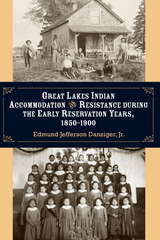 Great Lakes Indian Accommodation and Resistance during the Early Reservation Years, 1850-1900
Edmund Jefferson Danziger, Jr.
University of Michigan Press, 2009 During the four decades following the War of 1812, Great Lakes Indians were forced to surrender most of their ancestral homelands and begin refashioning their lives on reservations. The challenges Indians faced during this period could not have been greater. By century's end, settlers, frontier developers, and federal bureaucrats possessed not only economic and political power but also the bulk of the region's resources. It is little wonder that policymakers in Washington and Ottawa alike anticipated the disappearance of distinctive Indian communities within a single generation. However, these predictions have proved false as Great Lakes Indian communities, though assaulted on both sides of the international border to this day, have survived. Danziger's lively and insightful book documents the story of these Great Lakes Indians---a study not of victimization but of how Aboriginal communities and their leaders have determined their own destinies and preserved core values, lands, and identities against all odds and despite ongoing marginalization. Utilizing eyewitness accounts from the 1800s and an innovative, cross-national approach, Danziger explores not only how Native Americans adapted to their new circumstances---including attempts at horse and plow agriculture, the impact of reservation allotment, and the response to Christian evangelists---but also the ways in which the astute and resourceful Great Lakes chiefs, councils, and clan mothers fought to protect their homeland and preserve the identity of their people. Through their efforts, dreams of economic self-sufficiency and self-determination as well as the historic right to unimpeded border crossings---from one end of the Great Lakes basin to the other---were kept alive.
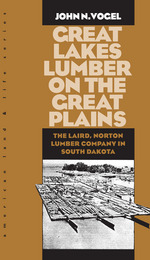 Great Lakes Lumber on the Great Plains: The Laird, Norton Lumber Company In South Dakota
John N. Vogel
University of Iowa Press, 1992 Focusing on the Plains territory of east central South Dakota as well as the Great Lakes lumber-producing region of Wisconsin's Chippewa Valley, John Vogel carefully and thoroughly examines the pattern and process by which lumber reached South Dakota. The Great Dakota Boom of 1878 to 1887 and the Laird, Norton Lumber Company of Winona, Minnesota, provide the basis for his engrossing book. The westward expansion of the railroad and the continuing settlement of the Great Plains in the late nineteenth century allowed the lumber companies of Minnesota and Wisconsin to send their boards and beams and fenceposts and millwork to a market characterized by great demand and small supply. Laird, Norton followed settlers across southern Dakota as they arrived on the trains. The eastern portions of Dakota were settled first, and thus early lumberyards were found there; as settlement moved west, so did the lumberyards. Beyond its all-important function of distribution, the railroad forced Laird, Norton to alter the very structure of its operation. Experimenting with nearly complete vertical integration, the company pioneered organizational models that would serve significant purposes as frontier America—a republic of wood—solidified itself economically and culturally.
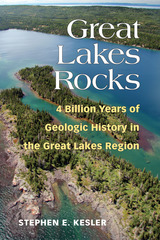 Great Lakes Rocks: 4 Billion Years of Geologic History in the Great Lakes Region
Stephen E. Kesler
University of Michigan Press, 2019 The geologic story of the Great Lakes region is one of the most remarkable of any place on Earth. Great Lakes Rocks takes readers on this fascinating journey through geologic history, beginning with an investigation of the surface features—the hills and valleys, waterfalls and caves, and the Great Lakes themselves—that we encounter on a daily basis. From there the book digs deeper into the past, and readers learn about the amazing techniques geologists have used to reconstruct the events that shaped this region millions and even billions of years before humans set foot on Earth. Throughout, the book gives special attention to the link between the region’s geology and its modern history, including the impacts of geology on settlement patterns as well as the development of industries and the present-day economy. Other discussed topics include natural hazards that are geologic in nature, including earthquakes, floods, landslides, and coastal erosion, as well as information on rocks, minerals, and ancient life seen in fossils. Written for nonspecialist readers, this book provides a detailed but easy-to-follow introduction to the geology of the Great Lakes region, and it is an ideal fit for introductory geology courses, including those aimed at nonscience majors.
 Great Lakes Sea Lamprey: The 70 Year War on a Biological Invader
Cory Brant
University of Michigan Press, 2019 The stuff of nightmares in both their looks and the wounds inflicted on their victims, sea lampreys (Petromyzon marinus) are perhaps the deadliest invasive species to ever enter the Great Lakes. At the invasion’s apex in the mid-20th century, harvests of lake trout (Salvelinus namaycush), the lampreys’ preferred host fish in the Great Lakes, plummeted from peak annual catches of 15 million pounds to just a few hundred thousand pounds per year—a drop of 98% in only a few decades.
Threatening the complete collapse of the fishery, the sea lamprey invasion triggered an environmental awakening in the region and prompted an international treaty that secured unprecedented cooperation across political boundaries to protect the Great Lakes. Fueled by a pioneering scientific spirit, the war on Great Lakes sea lampreys led to discoveries that are the backbone of the program that eventually brought the creature under control and still protects the largest freshwater ecosystem in the world to this day.
Great Lakes Sea Lamprey draws on extensive interviews with individuals who experienced the invasion firsthand as well as a trove of unexplored archival materials to tell the incredible story of sea lamprey in the Great Lakes—what started the invasion, how it was halted, and what this history can teach us about the response to biological invaders in the present and future. Richly illustrated with color and black & white photographs, the book will interest readers concerned with the health of the Great Lakes, the history of the conservation movement, and the ongoing threat of invasive species.
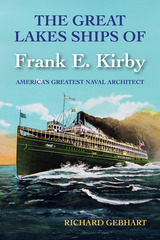 The Great Lakes Ships of Frank E. Kirby: America's Greatest Naval Architect
Richard Gebhart
Michigan State University Press, 2026 This study of the legendary Michigan shipbuilder Frank E. Kirby examines his life and the accomplishments that earned him national esteem and international fame. Kirby was involved in the design and build of nearly one hundred vessels, many of which sailed the Great Lakes region. He is best known for designing the paddle steamer Tashmoo and two boats that ferried visitors to Boblo Island in the Detroit River for decades, Columbia and Ste. Claire. Though only three of his vessels remain, none of them operational, hundreds of thousands of Michiganders who are still alive today have been carried by Kirby vessels. Told through stories found in the Detroit Free Press, historical archives, family documents, an interview conducted by his daughter-in-law Dorothy Clement Kirby in 1926, and keepsakes, Richard Gebhart brings to life the story of one of the most prolific Great Lakes shipbuilders of the time.
The Great Lakes Water Wars
Peter Annin
Island Press, 2009 The Great Lakes are the largest collection of fresh surface water on earth, and more than 40 million Americans and Canadians live in their basin. Will we divert water from the Great Lakes, causing them to end up like Central Asia's Aral Sea, which has lost 90 percent of its surface area and 75 percent of its volume since 1960? Or will we come to see that unregulated water withdrawals are ultimately catastrophic? Peter Annin writes a fast-paced account of the people and stories behind these upcoming battles. Destined to be the definitive story for the general public as well as policymakers, The Great Lakes Water Wars is a balanced, comprehensive look behind the scenes at the conflicts and compromises that are the past-and future-of this unique resource.
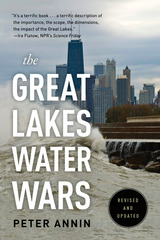 The Great Lakes Water Wars
Peter Annin
Island Press, 2018 The Great Lakes are the largest system of freshwater lakes in the world and America’s greatest freshwater resource. For over a century they have been the target of controversial diversion schemes designed to sell, send, or ship water to thirsty communities, sometimes far from the source. In part to protect the Great Lakes from overzealous entrepreneurship, the Great Lakes Compact was signed in 2008. Although the Compact fulfills that promise and ensures that Great Lakes water stays within the Basin, some would say it has only shifted the controversy closer to home. Now water diversion controversies of a different kind are some of the most fought-over environmental issues in the region. Will the water wars ever be settled?
Journalist Peter Annin delves deeply into the fraught history of water use in the Great Lakes region and recaps the story of the Chicago River diversion, which reversed the flow of the river, fundamentally transforming the Great Lakes ecosystem. A century later it remains “the poster child of bad behavior in the Great Lakes.” Today, with growing communities and a warming climate, tensions over water use are high, and controversies on the perimeter of the Great Lakes Basin are on the rise. In this new and expanded edition of The Great Lakes Water Wars, Annin shares the stories of New Berlin and Waukesha, two Wisconsin communities straddling the Basin boundary whose recent legal battles have tested the legislative strength of the newly signed Compact. Annin devotes a new chapter to the volatile issue of the invasive Asian carp—a voracious species that reproduces at a disturbing rate—which is transforming the ecology of the river as it makes its way through the Chicago River diversion and ever closer to Lake Michigan.
With three new chapters and significant revisions to existing chapters that bring the story up-to-date over the past decade, this is the definitive behind-the-scenes account of the people and stories behind hard-fought battles to protect this precious resource that makes the region so special for the millions who call it home.
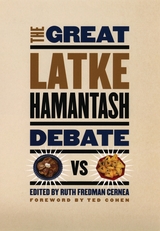 The Great Latke-Hamantash Debate
Edited by Ruth Fredman Cernea
University of Chicago Press, 2005 Creation versus evolution. Nature versus nurture. Free will versus determinism. Every November at the University of Chicago, the best minds in the world consider the question that ranks with these as one of the most enduring of human history: latke or hamantash? This great latke-hamantash debate, occurring every year for the past six decades, brings Nobel laureates, university presidents, and notable scholars together to debate whether the potato pancake or the triangular Purim pastry is in fact the worthier food. What began as an informal gathering is now an institution that has been replicated on campuses nationwide. Highly absurd yet deeply serious, the annual debate is an opportunity for both ethnic celebration and academic farce. In poetry, essays, jokes, and revisionist histories, members of elite American academies attack the latke-versus-hamantash question with intellectual panache and an unerring sense of humor, if not chutzpah. The Great Latke-Hamantash Debate is the first collection of the best of these performances, from Martha Nussbaum's paean to both foods—in the style of Hecuba's Lament—to Nobel laureate Leon Lederman's proclamation on the union of the celebrated dyad. The latke and the hamantash are here revealed as playing a critical role in everything from Chinese history to the Renaissance, the works of Jane Austen to constitutional law. Philosopher and humorist Ted Cohen supplies a wry foreword, while anthropologist Ruth Fredman Cernea provides historical and social context as well as an overview of the Jewish holidays, latke and hamantash recipes, and a glossary of Yiddish and Hebrew terms, making the book accessible even to the uninitiated. The University of Chicago may have split the atom in 1942, but it's still working on the equally significant issue of the latke versus the hamantash. “As if we didn’t have enough on our plates, here’s something new to argue about. . . . To have to pick between sweet and savory, round and triangular, latke and hamantash. How to choose? . . . Thank goodness one of our great universities—Chicago, no less—is on the case. For more than 60 years, it has staged an annual latke-hamantash debate. . . . So, is this book funny? Of course it’s funny, even laugh-out-loud funny. It’s Mickey Katz in academic drag, Borscht Belt with a PhD.”—David Kaufmann, Forward
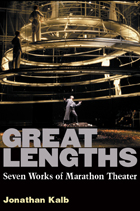 Great Lengths: Seven Works of Marathon Theater
Jonathan Kalb
University of Michigan Press, 2013 "Reading this book is certainly a vigorous experience. Kalb's sense of nuance, unpredictability, and the complexity of perception brings these productions to life. He is our surrogate, our scapegoat even, enduring the length of these productions so that he can convey the essence of their power."
---Stanton B. Garner, Jr., University of Tennessee "Jonathan Kalb takes us on a tour of monumental theater events, which flaunt the rules of economy, Aristotelian and otherwise. Kalb captures these unwieldy marathon productions by skillfully mixing personal experience and scholarly analysis. I read this engaging book in a single sitting---and came away ready to join the first theater marathon I could find."
---Martin Puchner, Harvard University "Jonathan Kalb's Great Lengths leaps to the head of any class in theatre history. Rich with critical perspective of 'marathon' works by Peter Brook, Tony Kushner, Robert Wilson, and others, and written with panache and lucidity, Kalb's book is filled with suspense as he describes and demystifies more than the post-modern and post-dramatic haunting recent theatre. This is history as present event, embracing the Greeks, Shakespeare, and even Charles Dickens."
---Gordon Rogoff, Yale University We know that size matters in many areas of human endeavor, but what about works of the imagination? Why do some dramatic creations extend to five hours or more, and how does their extreme length help them accomplish extraordinarily ambitious aims? In Great Lengths, theater critic and scholar Jonathan Kalb addresses these and other questions through a close look at seven internationally prominent theater productions, including Tony Kushner's Angels in America, Robert Wilson's Einstein on the Beach, and the Royal Shakespeare Company's Nicholas Nickleby. This is a book about extreme length, monumental scope, and intensive immersion in the theater in general, written by a passionate spectator reflecting on selected pinnacles of his theatergoing over thirty years. The book's examples, deliberately chosen for their diversity, range from adapted novels and epics, to dramatic chronicles with macrohistorical and macropolitical implications, to stagings of super-size classic plays, to "postdramatic" works that negotiate the border between life and art. Kalb reconstructs each of the works, re-creating the experience of seeing it while at the same time explaining how it maintained attention and interest over so many hours, and then expanding the scope to embrace a wider view and ask broader questions. The discussion of Nicholas Nickleby, for example, considers melodrama as a basic tool of theatrical communication, and the section on Peter Brook's The Mahabharata explores the ethical problems surrounding theatrical exoticism. The chapter on Einstein on the Beach grows into a reflection on the media-age status of the much-debated Gesamtkunstwerk (or "total artwork") and a reassessment of the long avant-gardist tradition of challenging the primacy of rational language in theater. The essay on Peter Stein's Faust I + II becomes a reflection on the interpretive role of theater directors and the theatrical viability of antitheatrical closet drama. Great Lengths thus offers a remarkable panorama of the surprisingly broad field of contemporary marathon theater---an art form that diverse audiences of savvy, screen-weaned spectators continue to seek out, for the increasingly rare experiences of awe, transcendence, and sustained immersion that it provides. Great Lengths will appeal to general readers as well as theater specialists. It situates the chosen productions in various historical and critical contexts and engages with the many lively scholarly debates that have swirled around them. At the same time, it uses the productions as springboards for wide-ranging reflections on the basic purpose and enduring power of theater in an attention-challenged, media-saturated era.
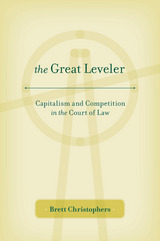 The Great Leveler: Capitalism and Competition in the Court of Law
Brett Christophers
Harvard University Press, 2016 For all the turmoil that roiled financial markets during the Great Recession and its aftermath, Wall Street forecasts once again turned bullish and corporate profitability soared to unprecedented heights. How does capitalism consistently generate profits despite its vulnerability to destabilizing events that can plunge the global economy into chaos? The Great Levelerelucidates the crucial but underappreciated role of the law in regulating capitalism’s rhythms of accumulation and growth.
Brett Christophers argues that capitalism requires a delicate balance between competition and monopoly. When monopolistic forces become dominant, antitrust law steps in to discourage the growth of giant corporations and restore competitiveness. When competitive forces become dominant, intellectual property law steps in to protect corporate assets and encourage investment. These two sets of laws—antitrust and intellectual property—have a pincer effect on corporate profitability, ensuring that markets become neither monopolistic, which would lead to rent-seeking and stagnation, nor overly competitive, which would drive down profits.
Christophers pursues these ideas through a close study of the historical development of American and British capitalist economies from the late nineteenth century to the present, tracing the relationship between monopoly and competition in each country and the evolution of legal mechanisms for keeping these forces in check. More than an illuminating study of the economic role of law, The Great Leveler is a bold and fresh dissection of the anatomy of modern capitalism.
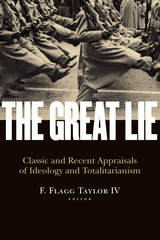 The Great Lie: Classic and Recent Appraisals of Ideology and Totalitarianism
F. Flagg Taylor
Intercollegiate Studies Institute, 2011
The Most Insightful and Profound
Reflections on Totalitarian Tyranny
Totalitarianism was the dominant phenomenon of the twentieth century. Deeply troubling questions endure regarding the nature of such tyrannical regimes: What enabled human beings to carry out such horrific crimes against their fellow man? What does the endurance of Communism reveal about human liberty? Why did human beings suffer rule by ideological lies for so long, and what kept them open to the truth? What are we to make of the relationship between totalitarianism and the foundational principles of democratic modernity?
Some of the greatest minds of the twentieth century sought answers to these haunting questions. Now, for the first time ever, their incisive and profound reflections on totalitarianism have been brought together in one book. The Great Lie showcases the insights of such giants as Aleksandr Solzhenitsyn, Václav Havel, Hannah Arendt, Eric Voegelin, Czeslaw Milosz, Leo Strauss, and Raymond Aron, along with neglected but important thinkers such as Waldemar Gurian, Aurel Kolnai, Leszek Kolakowski, Pierre Manent, Claude Lefort, and Chantal Delsol. The brilliant essays in this volume illuminate the very nature of totalitarian regimes, and the monstrous ideology that is their defining feature.
The Great Lie allows readers to make sense of political evil and how it can attract so many people into its ideological fold. This is not a matter of mere academic interest in an age when we confront totalitarianism in such regimes as North Korea and Cuba—and, arguably, in radical Islamist movements.
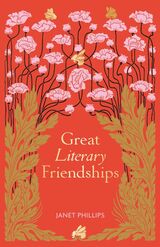 Great Literary Friendships
Janet Phillips
Bodleian Library Publishing, 2022 This volume explores twenty-four literary friendships in succinct, structured entries, from William Shakespeare to Elena Ferrante.
Close friendships are a heart-warming feature of many of our best-loved works of fiction. From the poignant schoolgirl relationship between Jane Eyre and Helen Burns to Tom Sawyer and Huckleberry Finn’s adventures on the Mississippi, fictional friends have supported, guided, comforted—and at times betrayed—the heroes and heroines of our most popular plays and novels.
This book explores twenty-four literary friendships and together with character studies and publication history, describes how each key relationship influences character, determines the plot, or underlines the theme of each literary work. It shows how authors have by turn celebrated, lamented, or transformed friendships throughout the ages. Some friendships—Don Quixote and Sancho Panza, Holmes and Watson, and even Bridget Jones and pals—have taken on creative lives beyond the bounds of their original narratives.
Including a broad scope of literature from writers such as Jane Austen, Charles Dickens, George Eliot, John Steinbeck, Alice Walker, Dona Tartt, and Margaret Atwood, this book is the ideal gift for your literature-loving friend.
The Great Machines: Poems and Songs from the Age of the American Railroad
Robert Hedin
University of Iowa Press, 1996 Here, for the first time, is a feast for anyone who has ever been beguiled by the trains that formerly thrummed through the landscapes of our lives. This entertaining and evocative anthology presents the amazing variety of poems and songs written about the American railroad in the last century and a half. Comprised of selections from both oral and written traditions, the volume celebrates the historical and cultural significance of this marvel of engineering skills. Hedin's anthology allows all readers, from the most avid railroad buff to anyone who has fond memories of train travel, to enjoy the romance of trains.
 The Great Map of Mankind: Perceptions of New Worlds in the Age of Enlightenment
P. J. Marshall and Glyn Williams
Harvard University Press, 1982 In 1777 Edmund Burke remarked that for his contemporaries “the Great Map of Mankind is unrolled at once.” The period from the late seventeenth century to the end of the eighteenth century had seen a massive increase in Britain’s knowledge of the non-European peoples of the wider world, and this was reflected in the proliferation of travel accounts of every kind.
This is a history of British perceptions of the exotic peoples and lands of Asia, North America, West Africa, and the Pacific who became well-known during that great age of exploration. It shows how the contours of intellectual and cultural history changed as news poured in. Philosophers contemplated man in a state of nature; the study of religion was broadened as Hinduism, the naturalistic religions of North America, and Chinese rites and ceremonies were revealed. Racial issues like slavery and negritude, questions about advanced versus backward nations, the great Chain of Being argument, and the Unchanging East theory became concerns of educated persons. Along with the impact of explorations on men’s ideas, the use of “sciences” like anthropology, ethnology, archeology, and philology came into vogue. And not incidentally, interest in empire grew, missionary zeal was strengthened, and tolerance and intolerance toward strangers struggled for dominance.
It could be argued that by the end of this age of “enlightenment,” investigation of the inhabitants of these distant lands had reinforced those assumptions of superiority that were an essential feature of British global expansion. To that extent this book is concerned with the intellectual foundations of the second British empire, for it seeks to show how many of the attitudes present in Britain’s dealings with the world in her imperial heyday were formulated during the eighteenth century.
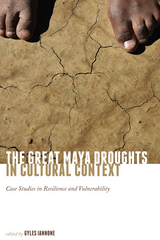 The Great Maya Droughts in Cultural Context: Case Studies in Resilience and Vulnerability
Gyles Iannone
University Press of Colorado, 2014 In The Great Maya Droughts in Cultural Context, contributors reject the popularized link between societal collapse and drought in Maya civilization, arguing that a series of periodic “collapses,” including the infamous Terminal Classic collapse (AD 750–1050), were not caused solely by climate change–related droughts but by a combination of other social, political, and environmental factors. New and senior scholars of archaeology and environmental science explore the timing and intensity of droughts and provide a nuanced understanding of socio-ecological dynamics, with specific reference to what makes communities resilient or vulnerable when faced with environmental change.Contributors recognize the existence of four droughts that correlate with periods of demographic and political decline and identify a variety of concurrent political and social issues. They argue that these primary underlying factors were exacerbated by drought conditions and ultimately led to societal transitions that were by no means uniform across various sites and subregions. They also deconstruct the concept of “collapse” itself—although the line of Maya kings ended with the Terminal Classic collapse, the Maya people and their civilization survived. The Great Maya Droughts in Cultural Context offers new insights into the complicated series of events that impacted the decline of Maya civilization. This significant contribution to our increasingly comprehensive understanding of ancient Maya culture will be of interest to students and scholars of archaeology, anthropology, geography, and environmental studies.
 Great Medical Discoveries: An Oxford Story
Conrad Keating
Bodleian Library Publishing, 2013 The “miracle drug” penicillin was first administered in Oxford in February 1941, leading to a full-blown transformation in the way bacterial infection was diagnosed and treated. What was to become one of the greatest stories of the “golden age of medical discovery” not only had its roots in Oxford, but was the latest in a line of pivotal medical discoveries made in the city.
Great Medical Discoveries offers a short illustrated history of the city’s contribution to the medical sciences, from the medieval period to the present day, when it is home to some of the world’s leading large scientific institutions. In charting this remarkable history, the book showcases twenty discoveries across the centuries. In the mid-twentieth century, for instance, Oxford led the field of experimental medicine, and William Harvey, Thomas Willis, and Thomas Sydenham all gained eponymous status with their pioneering research into the workings of the human body. In the mid-seventeenth century, Dorothy Hodgkin’s development of x-ray crystallography earned her a Nobel Prize in Chemistry. Meanwhile, the work of epidemiologist Richard Doll saved millions of lives by making clear the long-term dangers of smoking and the benefits of quitting.
Great Medical Discoveries traces these and other examples of groundbreaking research—from the scientific application of anesthetics to new treatments for hemophilia and life-saving advances in neurosurgery—and shows how they form part of a wider tapestry of work that has helped shape the medical sciences and improve human health.
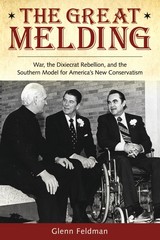 The Great Melding: War, the Dixiecrat Rebellion, and the Southern Model for America's New Conservatism
Glenn Feldman
University of Alabama Press, 2015 2016 Choice Outstanding Academic Title
Audacious in its scope, subtle in its analysis, and persuasive in its arguments, The Great Melding is the second book in Glenn Feldman’s magisterial recounting of the South’s transformation from a Reconstruction-era citadel of Democratic Party inertia to a cauldron of GOP agitation. In this pioneering study, Feldman shows how the transitional years after World War II, the Dixiecrat episode, and the early 1950s formed a pivotal sequence of events that altered America’s political landscape in profound, fundamental, and unexpected ways.
Feldman’s landmark work The Irony of the Solid South dismantled the myth of the New Deal consensus, proving it to be only a fleeting alliance of fissiparous factions; The Great Melding further examines how the South broke away from that consensus. Exploring issues of race and white supremacy, Feldman documents and explains the roles of economics, religion, and emotive appeals to patriotism in southern voting patterns. His probing and original analysis includes a discussion of the limits of southern liberalism and a fresh examination of the Dixiecrat Revolt of 1948.
Feldman convincingly argues that the Dixiecrats—often dismissed as a transitory footnote in American politics—served as a template for the modern conservative movement. Now a predictable Republican stronghold, Alabama at the time was viewed by national political strategists as a battleground and bellwether. Masterfully synthesizing a vast range of sources, Feldman shows that Alabama was then one of the few states where voters made unpredictable choices between the competing ideologies of the Democrats, Republicans, and Dixiecrats.
Writing in his lively and provocative style, Feldman demonstrates that the events he recounts in Alabama between 1942 and Dwight Eisenhower’s 1952 election encapsulate a rare moment of fluidity in American politics, one in which the New Deal consensus shattered and the Democratic and Republican parties fought off a third-party revolt only to find themselves irrevocably altered by their success. The Great Melding will fascinate historians, political scientists, political strategists, and readers of political nonfiction.
 The Great Melody: A Thematic Biography of Edmund Burke
Conor Cruise O'Brien
University of Chicago Press, 1992 Statesman, political thinker, orator, and ardent campaigner, Edmund Burke was one of the most brilliant figures of the eighteenth century. This unorthodox biography focuses on Burke's thoughts, responses, and actions to the great events and debates surrounding Britain's tumultuous relationships with her three colonies—America, Ireland, and India—and archrival France.
"In bringing Burke to our attention, Mr. O'Brien has brought back a lost treasure. The Great Melody is a brilliant work of narrative sweep and analytical depth. Conor Cruise O'Brien on Edmund Burke is a literary gift to political thought."—John Patrick Diggins, New York Times Book Review
"Serious readers of history are in for a treat: a book by the greatest living Irishman on the greatest Irishman who ever lived. . . . O'Brien's study is not merely a reconstruction of a fascinating man and period. It is also a tract for the times. . . . I cannot remember another time when I finished a book of more than 600 pages wishing it were longer."—Paul Johnson, The Independent
"The Great Melody combines superb biography and fascinating history with a profound understanding of political philosophy."—Former President Richard Nixon
|
|




